The Efficacy of ADR in Addressing Challenges Faced by Microfinance Institutions (MFIs) in Kenya
VerifiedAdded on 2023/06/08
|39
|9956
|288
AI Summary
In this report we will discuss about challenges faced by Microfinance Institutions (MFIs) in kenya. and below are the summaries point:-
The study explores the efficacy of Alternative Dispute Resolution (ADR) in addressing challenges faced by Microfinance Institutions (MFIs) in Kenya.
A mixed-methods approach is used to gather data on the use of ADR in resolving issues such as loan defaults, operational inefficiencies, and regulatory compliance.
The study aims to provide findings, discussions, conclusions, and recommendations on the applicability of ADR in solving MFIs disputes in Kenya and other countries.
Contribute Materials
Your contribution can guide someone’s learning journey. Share your
documents today.
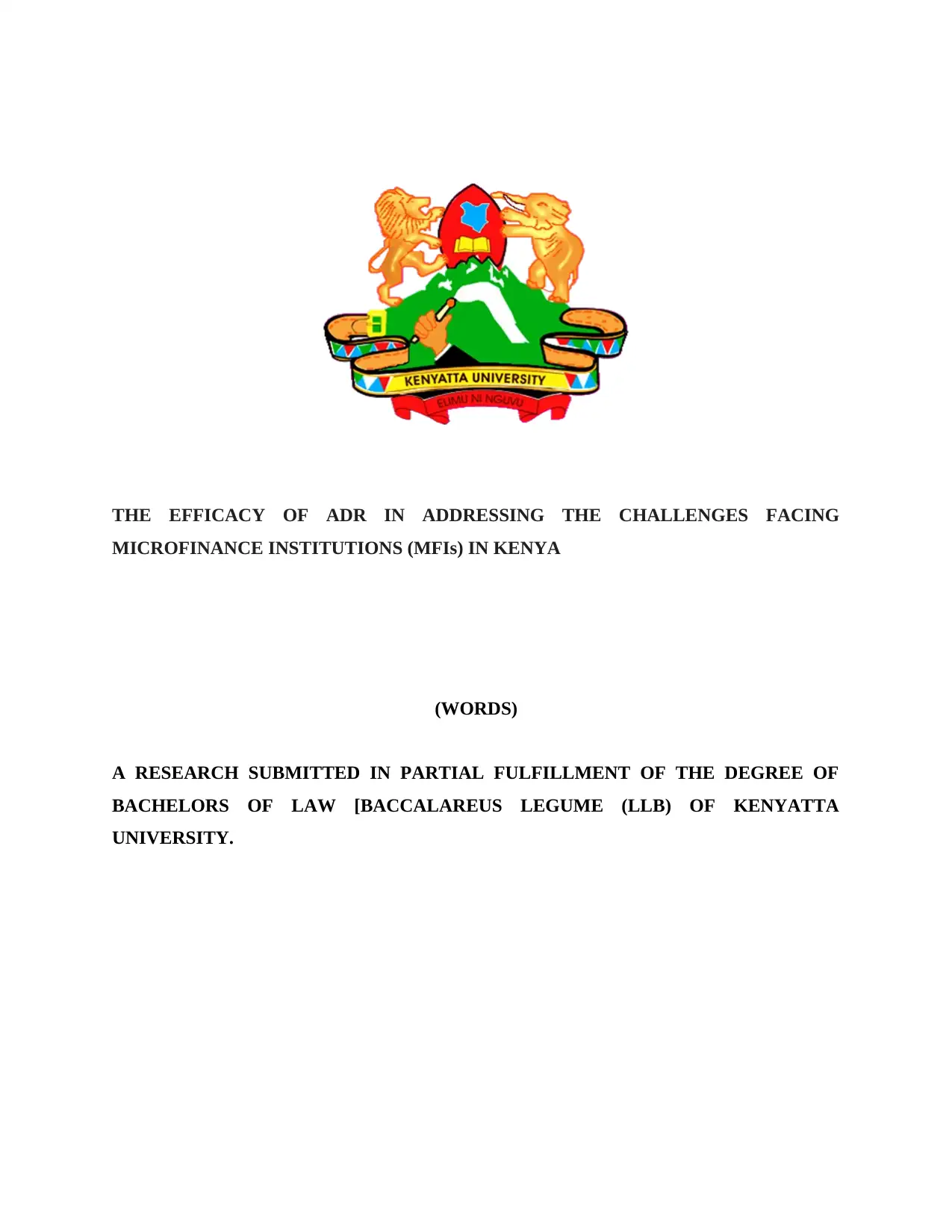
THE EFFICACY OF ADR IN ADDRESSING THE CHALLENGES FACING
MICROFINANCE INSTITUTIONS (MFIs) IN KENYA
(WORDS)
A RESEARCH SUBMITTED IN PARTIAL FULFILLMENT OF THE DEGREE OF
BACHELORS OF LAW [BACCALAREUS LEGUME (LLB) OF KENYATTA
UNIVERSITY.
MICROFINANCE INSTITUTIONS (MFIs) IN KENYA
(WORDS)
A RESEARCH SUBMITTED IN PARTIAL FULFILLMENT OF THE DEGREE OF
BACHELORS OF LAW [BACCALAREUS LEGUME (LLB) OF KENYATTA
UNIVERSITY.
Secure Best Marks with AI Grader
Need help grading? Try our AI Grader for instant feedback on your assignments.
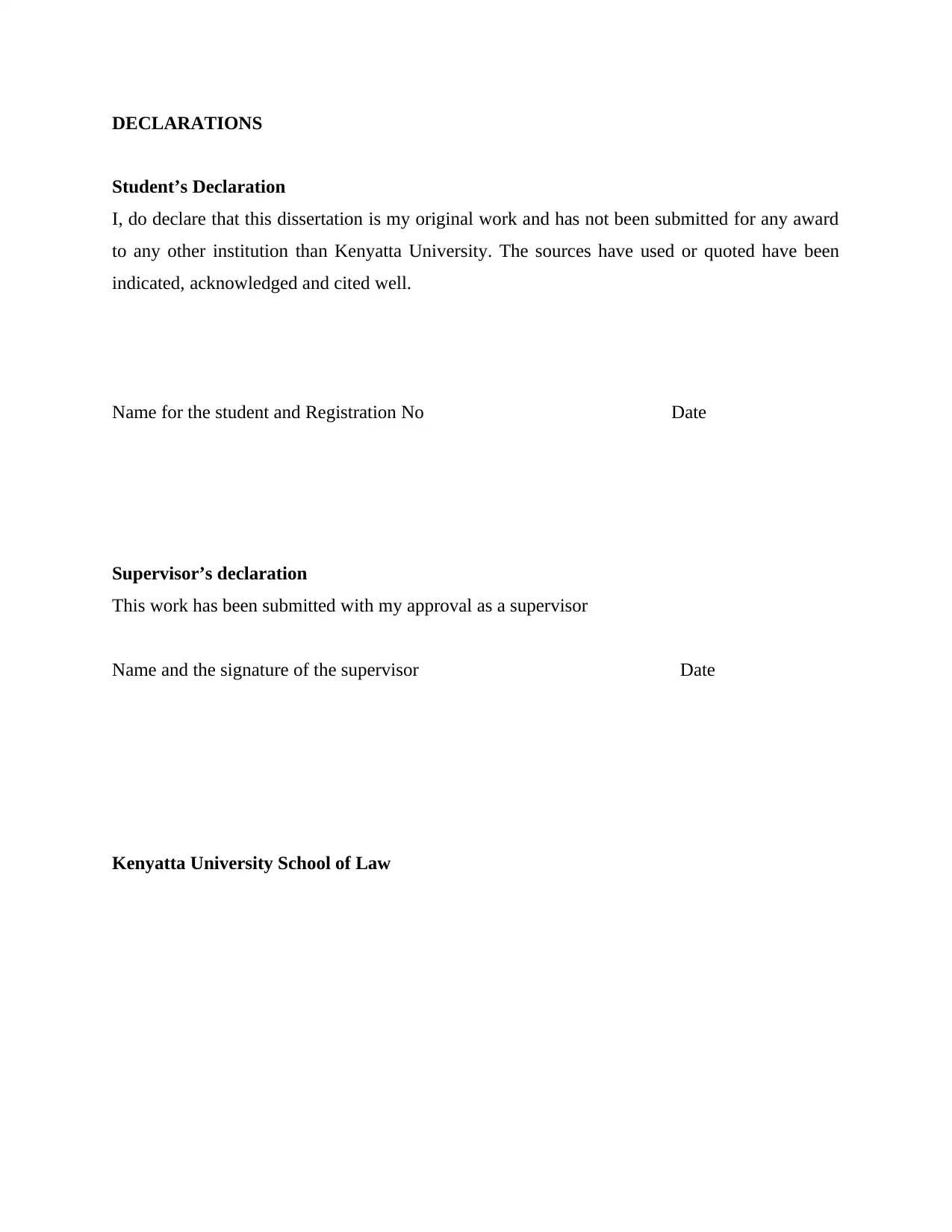
DECLARATIONS
Student’s Declaration
I, do declare that this dissertation is my original work and has not been submitted for any award
to any other institution than Kenyatta University. The sources have used or quoted have been
indicated, acknowledged and cited well.
Name for the student and Registration No Date
Supervisor’s declaration
This work has been submitted with my approval as a supervisor
Name and the signature of the supervisor Date
Kenyatta University School of Law
Student’s Declaration
I, do declare that this dissertation is my original work and has not been submitted for any award
to any other institution than Kenyatta University. The sources have used or quoted have been
indicated, acknowledged and cited well.
Name for the student and Registration No Date
Supervisor’s declaration
This work has been submitted with my approval as a supervisor
Name and the signature of the supervisor Date
Kenyatta University School of Law

DEDICATION
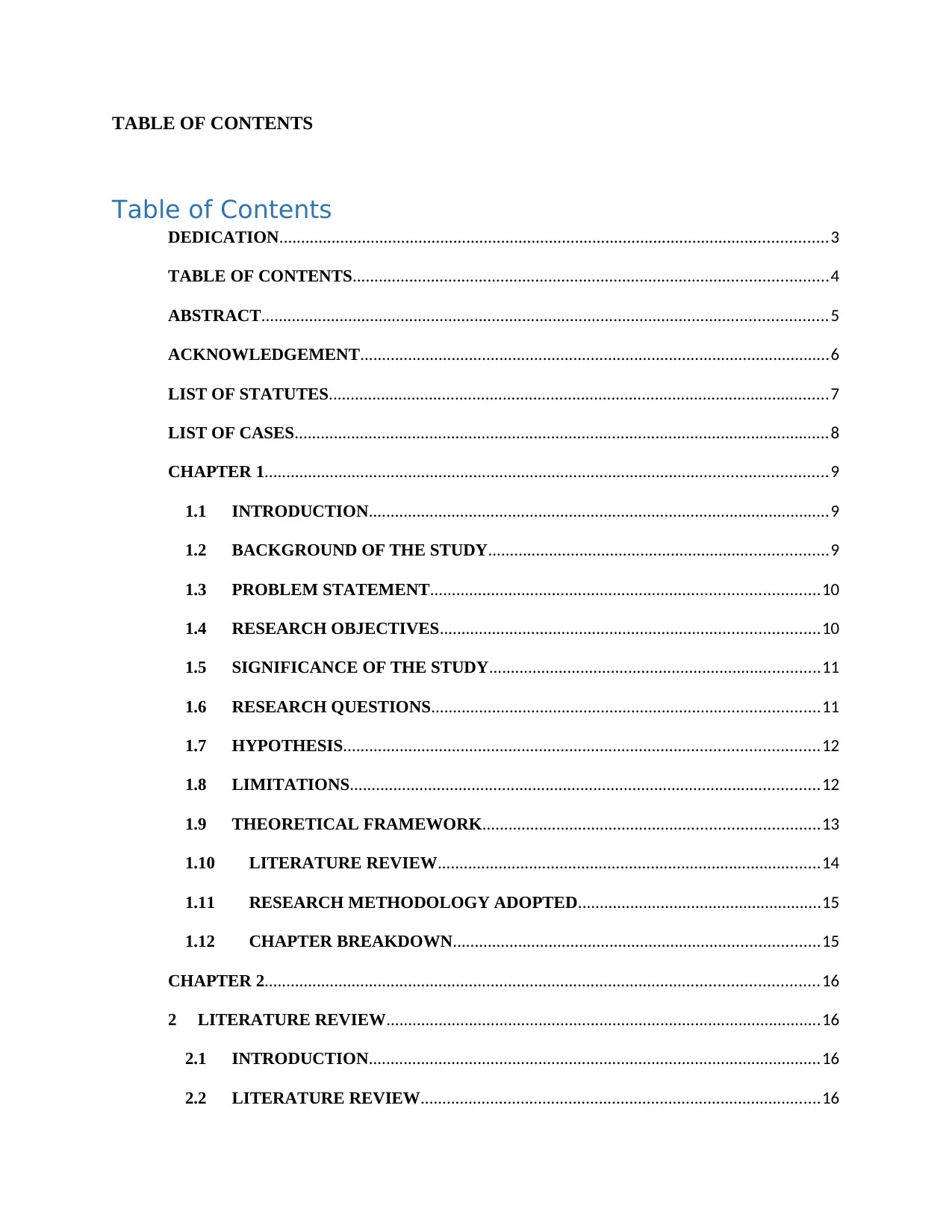
TABLE OF CONTENTS
Table of Contents
DEDICATION..............................................................................................................................3
TABLE OF CONTENTS.............................................................................................................4
ABSTRACT..................................................................................................................................5
ACKNOWLEDGEMENT............................................................................................................6
LIST OF STATUTES...................................................................................................................7
LIST OF CASES...........................................................................................................................8
CHAPTER 1.................................................................................................................................9
1.1 INTRODUCTION..........................................................................................................9
1.2 BACKGROUND OF THE STUDY..............................................................................9
1.3 PROBLEM STATEMENT.........................................................................................10
1.4 RESEARCH OBJECTIVES.......................................................................................10
1.5 SIGNIFICANCE OF THE STUDY............................................................................11
1.6 RESEARCH QUESTIONS.........................................................................................11
1.7 HYPOTHESIS.............................................................................................................12
1.8 LIMITATIONS............................................................................................................12
1.9 THEORETICAL FRAMEWORK.............................................................................13
1.10 LITERATURE REVIEW........................................................................................14
1.11 RESEARCH METHODOLOGY ADOPTED........................................................15
1.12 CHAPTER BREAKDOWN....................................................................................15
CHAPTER 2...............................................................................................................................16
2 LITERATURE REVIEW....................................................................................................16
2.1 INTRODUCTION........................................................................................................16
2.2 LITERATURE REVIEW............................................................................................16
Table of Contents
DEDICATION..............................................................................................................................3
TABLE OF CONTENTS.............................................................................................................4
ABSTRACT..................................................................................................................................5
ACKNOWLEDGEMENT............................................................................................................6
LIST OF STATUTES...................................................................................................................7
LIST OF CASES...........................................................................................................................8
CHAPTER 1.................................................................................................................................9
1.1 INTRODUCTION..........................................................................................................9
1.2 BACKGROUND OF THE STUDY..............................................................................9
1.3 PROBLEM STATEMENT.........................................................................................10
1.4 RESEARCH OBJECTIVES.......................................................................................10
1.5 SIGNIFICANCE OF THE STUDY............................................................................11
1.6 RESEARCH QUESTIONS.........................................................................................11
1.7 HYPOTHESIS.............................................................................................................12
1.8 LIMITATIONS............................................................................................................12
1.9 THEORETICAL FRAMEWORK.............................................................................13
1.10 LITERATURE REVIEW........................................................................................14
1.11 RESEARCH METHODOLOGY ADOPTED........................................................15
1.12 CHAPTER BREAKDOWN....................................................................................15
CHAPTER 2...............................................................................................................................16
2 LITERATURE REVIEW....................................................................................................16
2.1 INTRODUCTION........................................................................................................16
2.2 LITERATURE REVIEW............................................................................................16
Secure Best Marks with AI Grader
Need help grading? Try our AI Grader for instant feedback on your assignments.
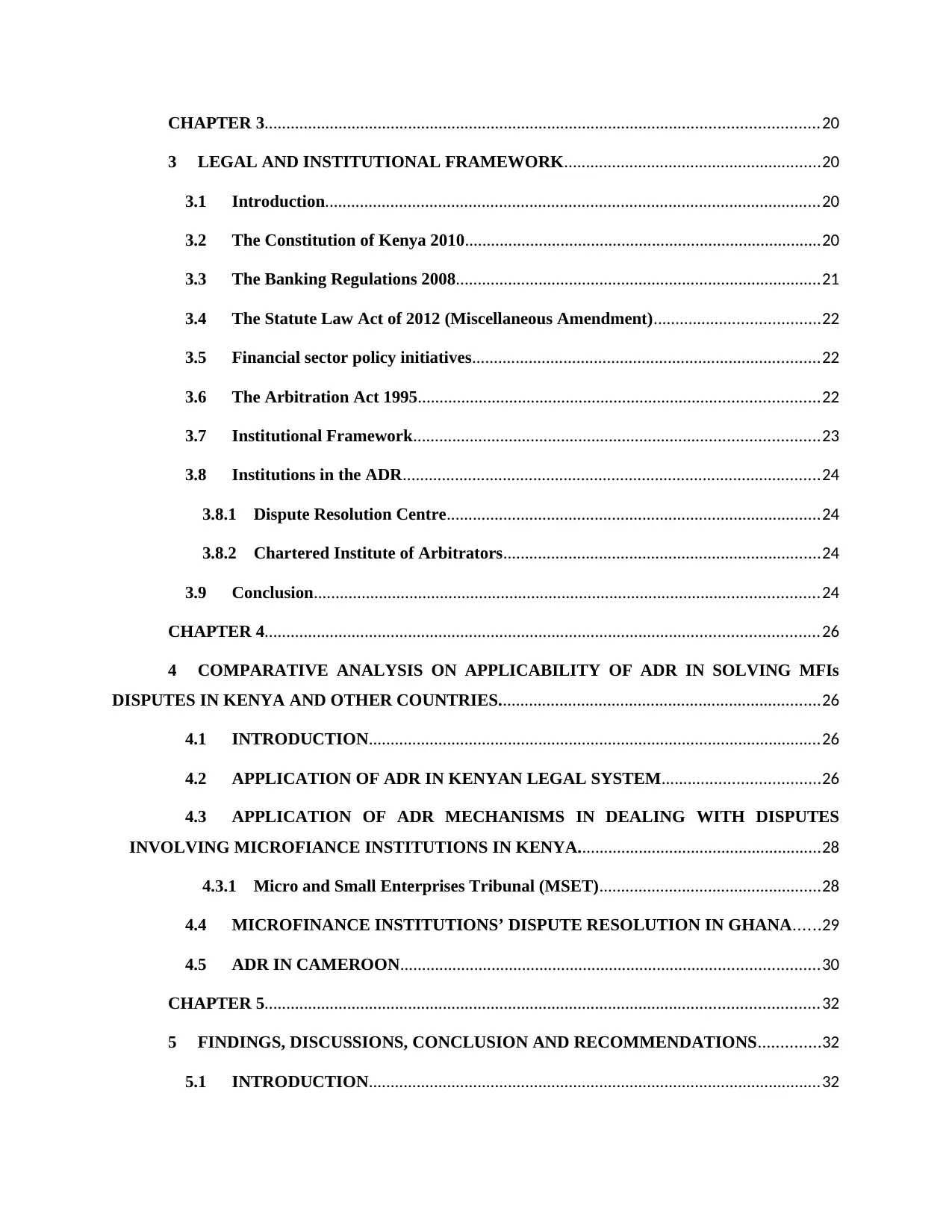
CHAPTER 3...............................................................................................................................20
3 LEGAL AND INSTITUTIONAL FRAMEWORK...........................................................20
3.1 Introduction..................................................................................................................20
3.2 The Constitution of Kenya 2010..................................................................................20
3.3 The Banking Regulations 2008....................................................................................21
3.4 The Statute Law Act of 2012 (Miscellaneous Amendment)......................................22
3.5 Financial sector policy initiatives................................................................................22
3.6 The Arbitration Act 1995............................................................................................22
3.7 Institutional Framework.............................................................................................23
3.8 Institutions in the ADR................................................................................................24
3.8.1 Dispute Resolution Centre......................................................................................24
3.8.2 Chartered Institute of Arbitrators.........................................................................24
3.9 Conclusion....................................................................................................................24
CHAPTER 4...............................................................................................................................26
4 COMPARATIVE ANALYSIS ON APPLICABILITY OF ADR IN SOLVING MFIs
DISPUTES IN KENYA AND OTHER COUNTRIES..........................................................................26
4.1 INTRODUCTION........................................................................................................26
4.2 APPLICATION OF ADR IN KENYAN LEGAL SYSTEM....................................26
4.3 APPLICATION OF ADR MECHANISMS IN DEALING WITH DISPUTES
INVOLVING MICROFIANCE INSTITUTIONS IN KENYA........................................................28
4.3.1 Micro and Small Enterprises Tribunal (MSET)...................................................28
4.4 MICROFINANCE INSTITUTIONS’ DISPUTE RESOLUTION IN GHANA......29
4.5 ADR IN CAMEROON................................................................................................30
CHAPTER 5...............................................................................................................................32
5 FINDINGS, DISCUSSIONS, CONCLUSION AND RECOMMENDATIONS..............32
5.1 INTRODUCTION........................................................................................................32
3 LEGAL AND INSTITUTIONAL FRAMEWORK...........................................................20
3.1 Introduction..................................................................................................................20
3.2 The Constitution of Kenya 2010..................................................................................20
3.3 The Banking Regulations 2008....................................................................................21
3.4 The Statute Law Act of 2012 (Miscellaneous Amendment)......................................22
3.5 Financial sector policy initiatives................................................................................22
3.6 The Arbitration Act 1995............................................................................................22
3.7 Institutional Framework.............................................................................................23
3.8 Institutions in the ADR................................................................................................24
3.8.1 Dispute Resolution Centre......................................................................................24
3.8.2 Chartered Institute of Arbitrators.........................................................................24
3.9 Conclusion....................................................................................................................24
CHAPTER 4...............................................................................................................................26
4 COMPARATIVE ANALYSIS ON APPLICABILITY OF ADR IN SOLVING MFIs
DISPUTES IN KENYA AND OTHER COUNTRIES..........................................................................26
4.1 INTRODUCTION........................................................................................................26
4.2 APPLICATION OF ADR IN KENYAN LEGAL SYSTEM....................................26
4.3 APPLICATION OF ADR MECHANISMS IN DEALING WITH DISPUTES
INVOLVING MICROFIANCE INSTITUTIONS IN KENYA........................................................28
4.3.1 Micro and Small Enterprises Tribunal (MSET)...................................................28
4.4 MICROFINANCE INSTITUTIONS’ DISPUTE RESOLUTION IN GHANA......29
4.5 ADR IN CAMEROON................................................................................................30
CHAPTER 5...............................................................................................................................32
5 FINDINGS, DISCUSSIONS, CONCLUSION AND RECOMMENDATIONS..............32
5.1 INTRODUCTION........................................................................................................32
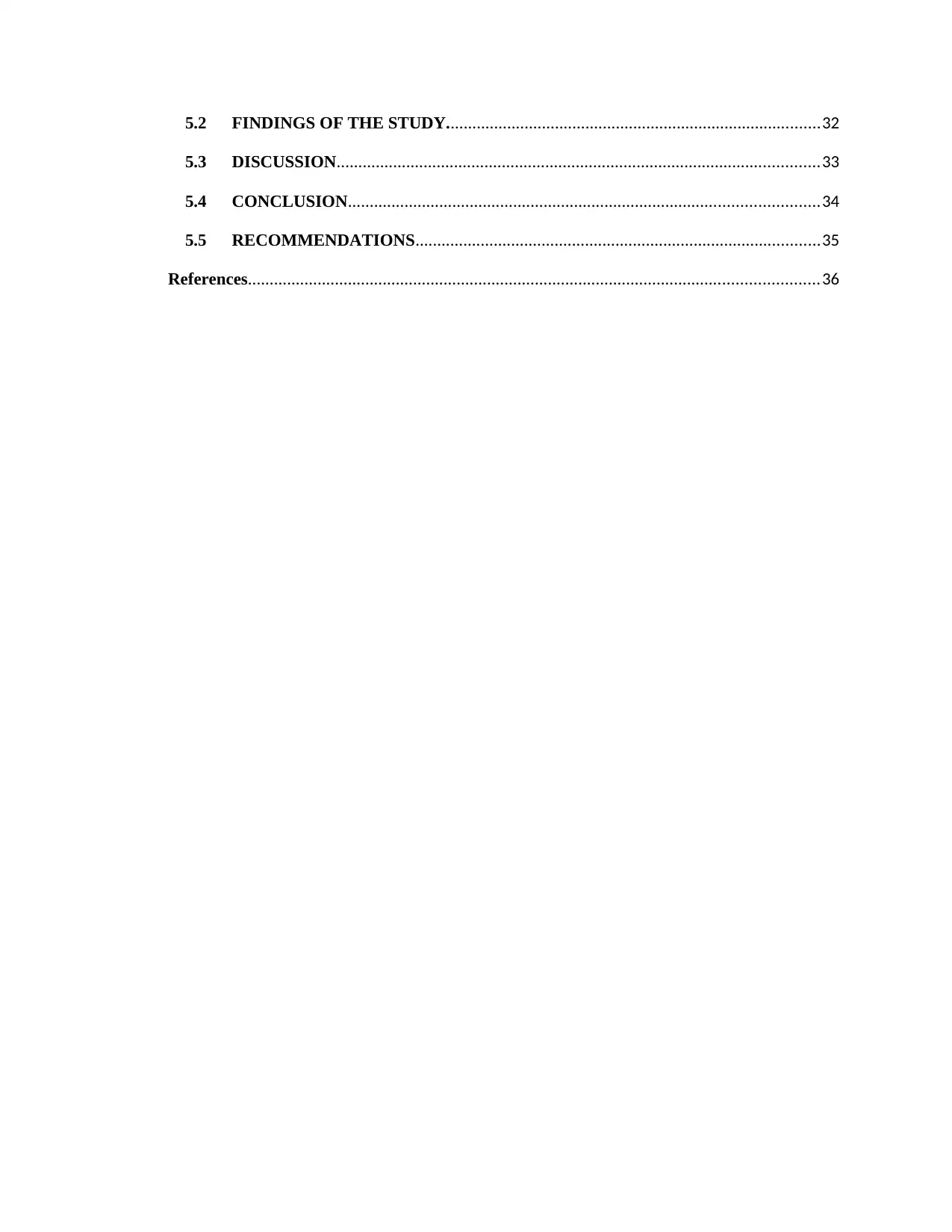
5.2 FINDINGS OF THE STUDY......................................................................................32
5.3 DISCUSSION...............................................................................................................33
5.4 CONCLUSION............................................................................................................34
5.5 RECOMMENDATIONS.............................................................................................35
References...................................................................................................................................36
5.3 DISCUSSION...............................................................................................................33
5.4 CONCLUSION............................................................................................................34
5.5 RECOMMENDATIONS.............................................................................................35
References...................................................................................................................................36
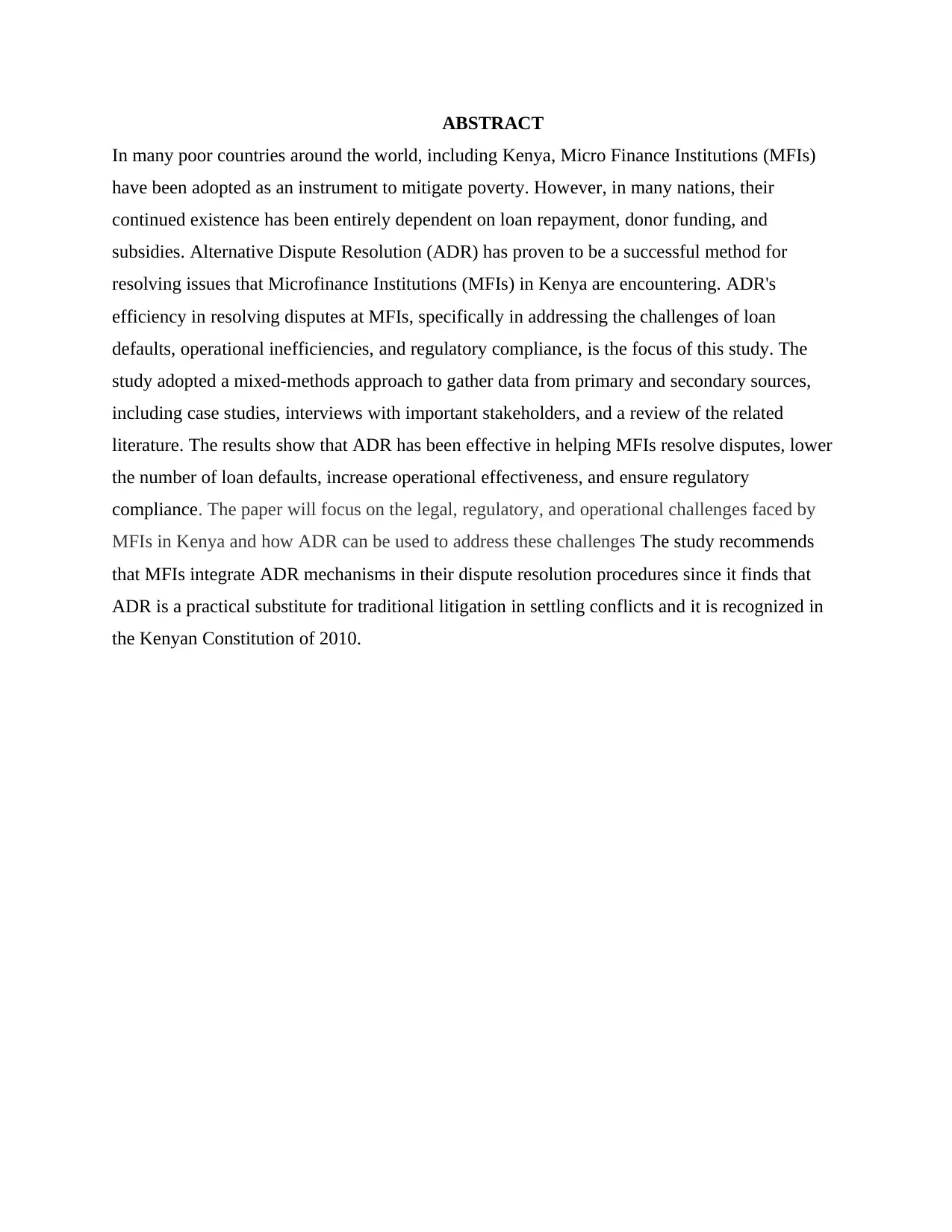
ABSTRACT
In many poor countries around the world, including Kenya, Micro Finance Institutions (MFIs)
have been adopted as an instrument to mitigate poverty. However, in many nations, their
continued existence has been entirely dependent on loan repayment, donor funding, and
subsidies. Alternative Dispute Resolution (ADR) has proven to be a successful method for
resolving issues that Microfinance Institutions (MFIs) in Kenya are encountering. ADR's
efficiency in resolving disputes at MFIs, specifically in addressing the challenges of loan
defaults, operational inefficiencies, and regulatory compliance, is the focus of this study. The
study adopted a mixed-methods approach to gather data from primary and secondary sources,
including case studies, interviews with important stakeholders, and a review of the related
literature. The results show that ADR has been effective in helping MFIs resolve disputes, lower
the number of loan defaults, increase operational effectiveness, and ensure regulatory
compliance. The paper will focus on the legal, regulatory, and operational challenges faced by
MFIs in Kenya and how ADR can be used to address these challenges The study recommends
that MFIs integrate ADR mechanisms in their dispute resolution procedures since it finds that
ADR is a practical substitute for traditional litigation in settling conflicts and it is recognized in
the Kenyan Constitution of 2010.
In many poor countries around the world, including Kenya, Micro Finance Institutions (MFIs)
have been adopted as an instrument to mitigate poverty. However, in many nations, their
continued existence has been entirely dependent on loan repayment, donor funding, and
subsidies. Alternative Dispute Resolution (ADR) has proven to be a successful method for
resolving issues that Microfinance Institutions (MFIs) in Kenya are encountering. ADR's
efficiency in resolving disputes at MFIs, specifically in addressing the challenges of loan
defaults, operational inefficiencies, and regulatory compliance, is the focus of this study. The
study adopted a mixed-methods approach to gather data from primary and secondary sources,
including case studies, interviews with important stakeholders, and a review of the related
literature. The results show that ADR has been effective in helping MFIs resolve disputes, lower
the number of loan defaults, increase operational effectiveness, and ensure regulatory
compliance. The paper will focus on the legal, regulatory, and operational challenges faced by
MFIs in Kenya and how ADR can be used to address these challenges The study recommends
that MFIs integrate ADR mechanisms in their dispute resolution procedures since it finds that
ADR is a practical substitute for traditional litigation in settling conflicts and it is recognized in
the Kenyan Constitution of 2010.
Paraphrase This Document
Need a fresh take? Get an instant paraphrase of this document with our AI Paraphraser

ACKNOWLEDGEMENT
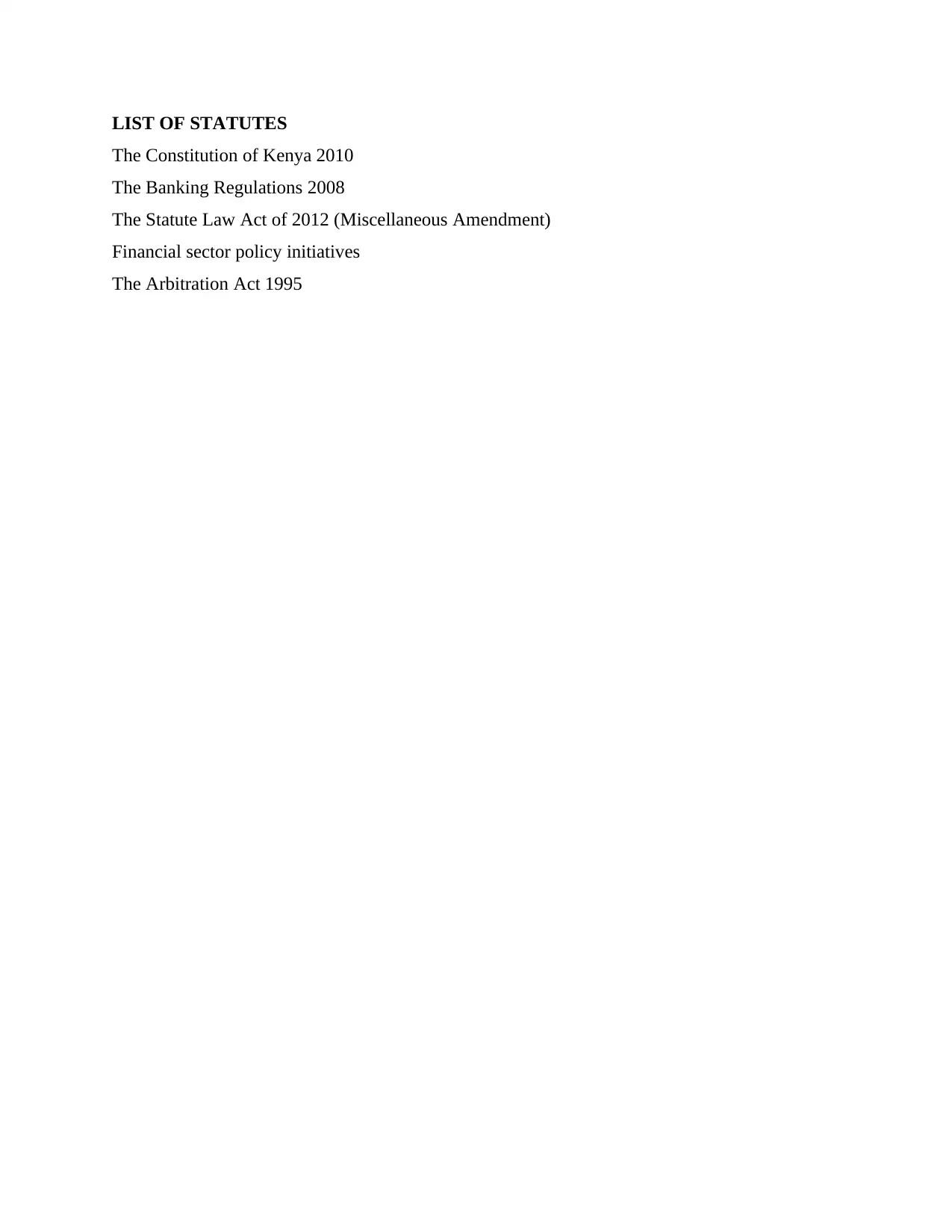
LIST OF STATUTES
The Constitution of Kenya 2010
The Banking Regulations 2008
The Statute Law Act of 2012 (Miscellaneous Amendment)
Financial sector policy initiatives
The Arbitration Act 1995
The Constitution of Kenya 2010
The Banking Regulations 2008
The Statute Law Act of 2012 (Miscellaneous Amendment)
Financial sector policy initiatives
The Arbitration Act 1995
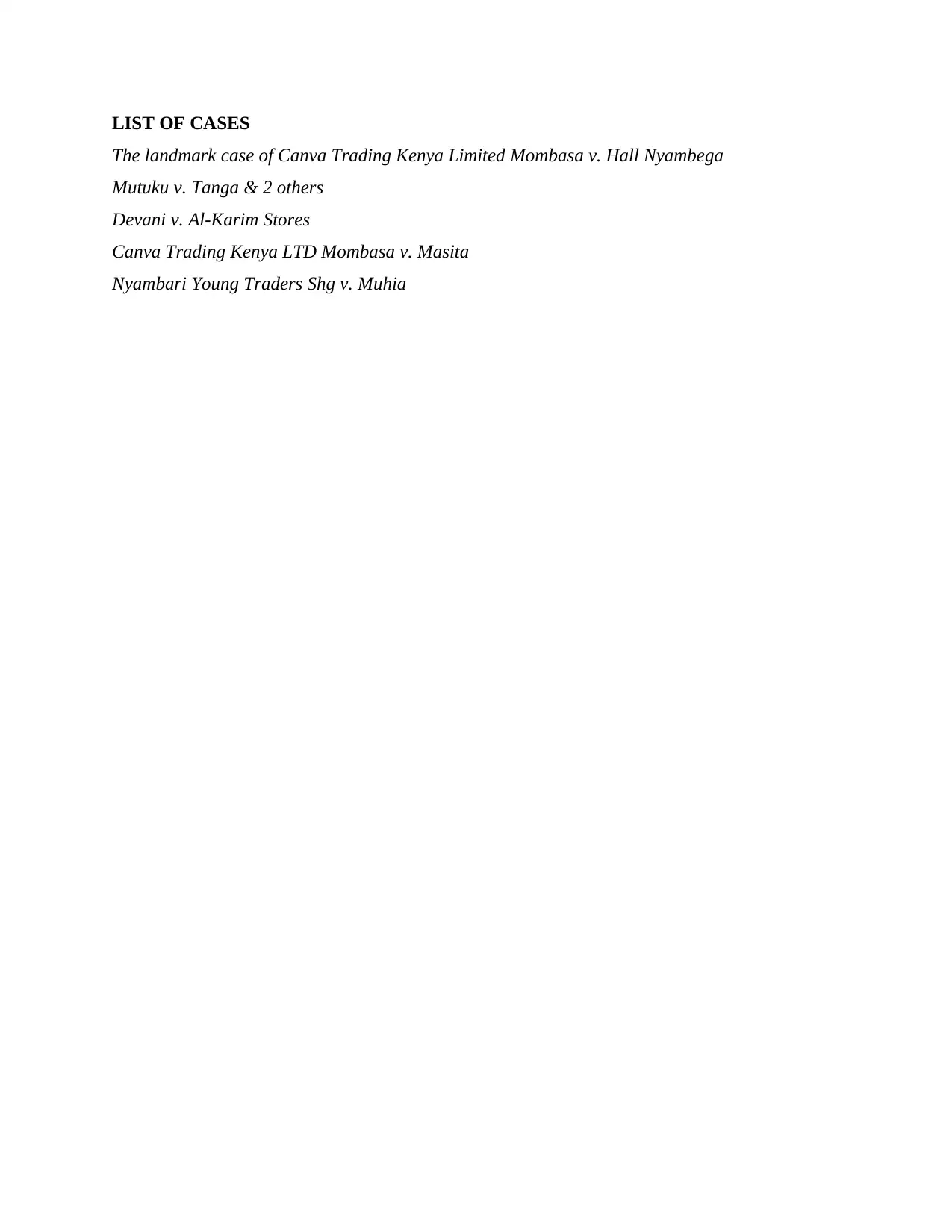
LIST OF CASES
The landmark case of Canva Trading Kenya Limited Mombasa v. Hall Nyambega
Mutuku v. Tanga & 2 others
Devani v. Al-Karim Stores
Canva Trading Kenya LTD Mombasa v. Masita
Nyambari Young Traders Shg v. Muhia
The landmark case of Canva Trading Kenya Limited Mombasa v. Hall Nyambega
Mutuku v. Tanga & 2 others
Devani v. Al-Karim Stores
Canva Trading Kenya LTD Mombasa v. Masita
Nyambari Young Traders Shg v. Muhia
Secure Best Marks with AI Grader
Need help grading? Try our AI Grader for instant feedback on your assignments.
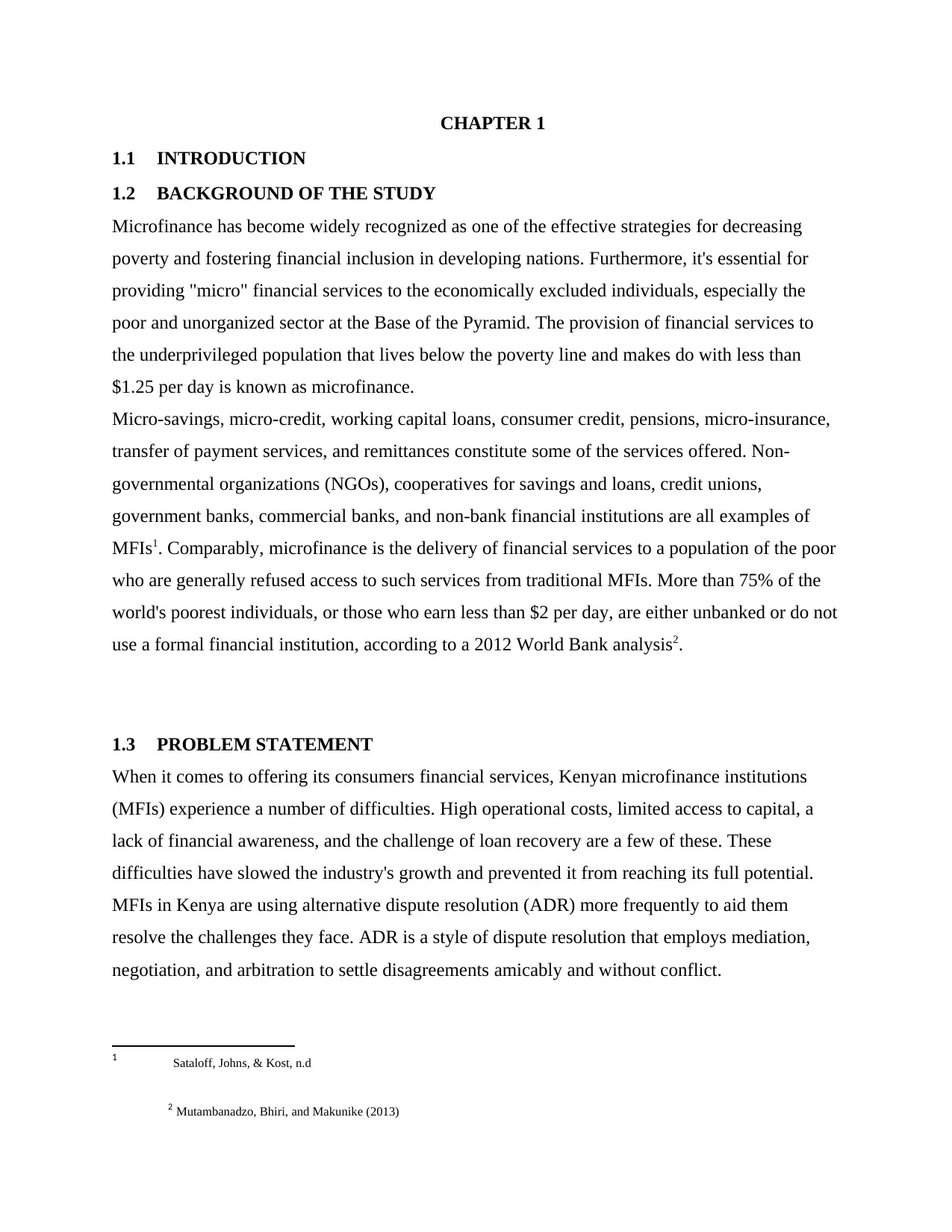
CHAPTER 1
1.1 INTRODUCTION
1.2 BACKGROUND OF THE STUDY
Microfinance has become widely recognized as one of the effective strategies for decreasing
poverty and fostering financial inclusion in developing nations. Furthermore, it's essential for
providing "micro" financial services to the economically excluded individuals, especially the
poor and unorganized sector at the Base of the Pyramid. The provision of financial services to
the underprivileged population that lives below the poverty line and makes do with less than
$1.25 per day is known as microfinance.
Micro-savings, micro-credit, working capital loans, consumer credit, pensions, micro-insurance,
transfer of payment services, and remittances constitute some of the services offered. Non-
governmental organizations (NGOs), cooperatives for savings and loans, credit unions,
government banks, commercial banks, and non-bank financial institutions are all examples of
MFIs1. Comparably, microfinance is the delivery of financial services to a population of the poor
who are generally refused access to such services from traditional MFIs. More than 75% of the
world's poorest individuals, or those who earn less than $2 per day, are either unbanked or do not
use a formal financial institution, according to a 2012 World Bank analysis2.
1.3 PROBLEM STATEMENT
When it comes to offering its consumers financial services, Kenyan microfinance institutions
(MFIs) experience a number of difficulties. High operational costs, limited access to capital, a
lack of financial awareness, and the challenge of loan recovery are a few of these. These
difficulties have slowed the industry's growth and prevented it from reaching its full potential.
MFIs in Kenya are using alternative dispute resolution (ADR) more frequently to aid them
resolve the challenges they face. ADR is a style of dispute resolution that employs mediation,
negotiation, and arbitration to settle disagreements amicably and without conflict.
1 Sataloff, Johns, & Kost, n.d
2 Mutambanadzo, Bhiri, and Makunike (2013)
1.1 INTRODUCTION
1.2 BACKGROUND OF THE STUDY
Microfinance has become widely recognized as one of the effective strategies for decreasing
poverty and fostering financial inclusion in developing nations. Furthermore, it's essential for
providing "micro" financial services to the economically excluded individuals, especially the
poor and unorganized sector at the Base of the Pyramid. The provision of financial services to
the underprivileged population that lives below the poverty line and makes do with less than
$1.25 per day is known as microfinance.
Micro-savings, micro-credit, working capital loans, consumer credit, pensions, micro-insurance,
transfer of payment services, and remittances constitute some of the services offered. Non-
governmental organizations (NGOs), cooperatives for savings and loans, credit unions,
government banks, commercial banks, and non-bank financial institutions are all examples of
MFIs1. Comparably, microfinance is the delivery of financial services to a population of the poor
who are generally refused access to such services from traditional MFIs. More than 75% of the
world's poorest individuals, or those who earn less than $2 per day, are either unbanked or do not
use a formal financial institution, according to a 2012 World Bank analysis2.
1.3 PROBLEM STATEMENT
When it comes to offering its consumers financial services, Kenyan microfinance institutions
(MFIs) experience a number of difficulties. High operational costs, limited access to capital, a
lack of financial awareness, and the challenge of loan recovery are a few of these. These
difficulties have slowed the industry's growth and prevented it from reaching its full potential.
MFIs in Kenya are using alternative dispute resolution (ADR) more frequently to aid them
resolve the challenges they face. ADR is a style of dispute resolution that employs mediation,
negotiation, and arbitration to settle disagreements amicably and without conflict.
1 Sataloff, Johns, & Kost, n.d
2 Mutambanadzo, Bhiri, and Makunike (2013)
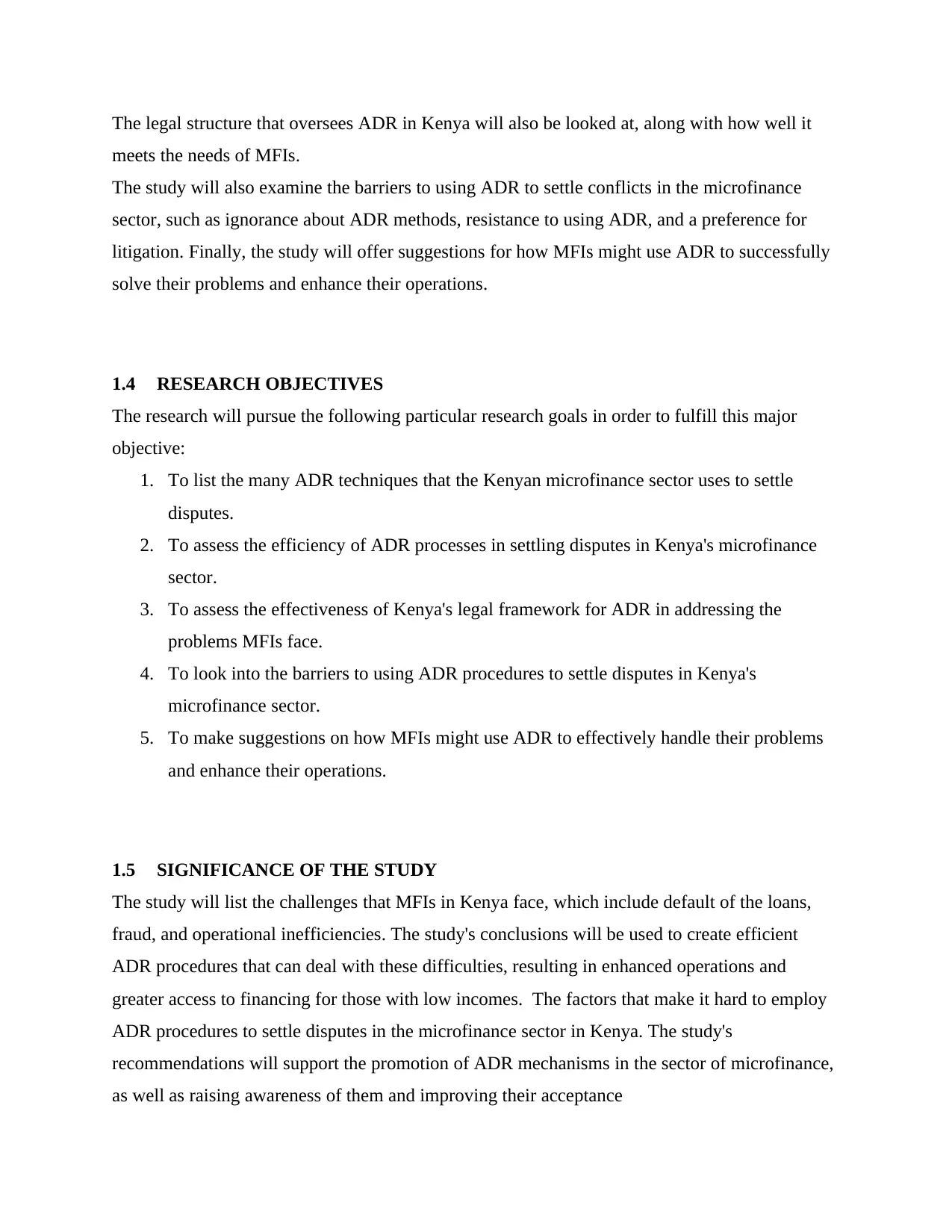
The legal structure that oversees ADR in Kenya will also be looked at, along with how well it
meets the needs of MFIs.
The study will also examine the barriers to using ADR to settle conflicts in the microfinance
sector, such as ignorance about ADR methods, resistance to using ADR, and a preference for
litigation. Finally, the study will offer suggestions for how MFIs might use ADR to successfully
solve their problems and enhance their operations.
1.4 RESEARCH OBJECTIVES
The research will pursue the following particular research goals in order to fulfill this major
objective:
1. To list the many ADR techniques that the Kenyan microfinance sector uses to settle
disputes.
2. To assess the efficiency of ADR processes in settling disputes in Kenya's microfinance
sector.
3. To assess the effectiveness of Kenya's legal framework for ADR in addressing the
problems MFIs face.
4. To look into the barriers to using ADR procedures to settle disputes in Kenya's
microfinance sector.
5. To make suggestions on how MFIs might use ADR to effectively handle their problems
and enhance their operations.
1.5 SIGNIFICANCE OF THE STUDY
The study will list the challenges that MFIs in Kenya face, which include default of the loans,
fraud, and operational inefficiencies. The study's conclusions will be used to create efficient
ADR procedures that can deal with these difficulties, resulting in enhanced operations and
greater access to financing for those with low incomes. The factors that make it hard to employ
ADR procedures to settle disputes in the microfinance sector in Kenya. The study's
recommendations will support the promotion of ADR mechanisms in the sector of microfinance,
as well as raising awareness of them and improving their acceptance
meets the needs of MFIs.
The study will also examine the barriers to using ADR to settle conflicts in the microfinance
sector, such as ignorance about ADR methods, resistance to using ADR, and a preference for
litigation. Finally, the study will offer suggestions for how MFIs might use ADR to successfully
solve their problems and enhance their operations.
1.4 RESEARCH OBJECTIVES
The research will pursue the following particular research goals in order to fulfill this major
objective:
1. To list the many ADR techniques that the Kenyan microfinance sector uses to settle
disputes.
2. To assess the efficiency of ADR processes in settling disputes in Kenya's microfinance
sector.
3. To assess the effectiveness of Kenya's legal framework for ADR in addressing the
problems MFIs face.
4. To look into the barriers to using ADR procedures to settle disputes in Kenya's
microfinance sector.
5. To make suggestions on how MFIs might use ADR to effectively handle their problems
and enhance their operations.
1.5 SIGNIFICANCE OF THE STUDY
The study will list the challenges that MFIs in Kenya face, which include default of the loans,
fraud, and operational inefficiencies. The study's conclusions will be used to create efficient
ADR procedures that can deal with these difficulties, resulting in enhanced operations and
greater access to financing for those with low incomes. The factors that make it hard to employ
ADR procedures to settle disputes in the microfinance sector in Kenya. The study's
recommendations will support the promotion of ADR mechanisms in the sector of microfinance,
as well as raising awareness of them and improving their acceptance
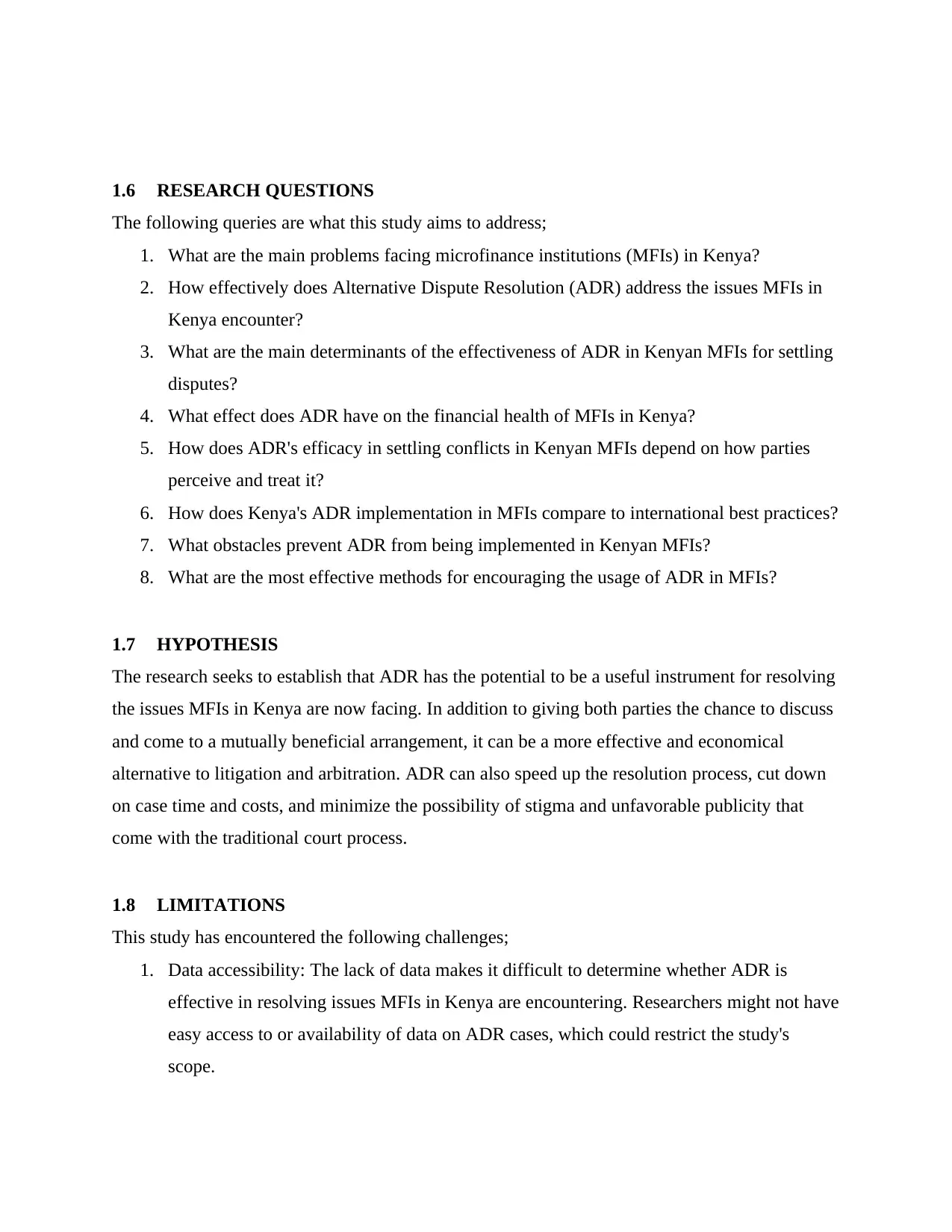
1.6 RESEARCH QUESTIONS
The following queries are what this study aims to address;
1. What are the main problems facing microfinance institutions (MFIs) in Kenya?
2. How effectively does Alternative Dispute Resolution (ADR) address the issues MFIs in
Kenya encounter?
3. What are the main determinants of the effectiveness of ADR in Kenyan MFIs for settling
disputes?
4. What effect does ADR have on the financial health of MFIs in Kenya?
5. How does ADR's efficacy in settling conflicts in Kenyan MFIs depend on how parties
perceive and treat it?
6. How does Kenya's ADR implementation in MFIs compare to international best practices?
7. What obstacles prevent ADR from being implemented in Kenyan MFIs?
8. What are the most effective methods for encouraging the usage of ADR in MFIs?
1.7 HYPOTHESIS
The research seeks to establish that ADR has the potential to be a useful instrument for resolving
the issues MFIs in Kenya are now facing. In addition to giving both parties the chance to discuss
and come to a mutually beneficial arrangement, it can be a more effective and economical
alternative to litigation and arbitration. ADR can also speed up the resolution process, cut down
on case time and costs, and minimize the possibility of stigma and unfavorable publicity that
come with the traditional court process.
1.8 LIMITATIONS
This study has encountered the following challenges;
1. Data accessibility: The lack of data makes it difficult to determine whether ADR is
effective in resolving issues MFIs in Kenya are encountering. Researchers might not have
easy access to or availability of data on ADR cases, which could restrict the study's
scope.
The following queries are what this study aims to address;
1. What are the main problems facing microfinance institutions (MFIs) in Kenya?
2. How effectively does Alternative Dispute Resolution (ADR) address the issues MFIs in
Kenya encounter?
3. What are the main determinants of the effectiveness of ADR in Kenyan MFIs for settling
disputes?
4. What effect does ADR have on the financial health of MFIs in Kenya?
5. How does ADR's efficacy in settling conflicts in Kenyan MFIs depend on how parties
perceive and treat it?
6. How does Kenya's ADR implementation in MFIs compare to international best practices?
7. What obstacles prevent ADR from being implemented in Kenyan MFIs?
8. What are the most effective methods for encouraging the usage of ADR in MFIs?
1.7 HYPOTHESIS
The research seeks to establish that ADR has the potential to be a useful instrument for resolving
the issues MFIs in Kenya are now facing. In addition to giving both parties the chance to discuss
and come to a mutually beneficial arrangement, it can be a more effective and economical
alternative to litigation and arbitration. ADR can also speed up the resolution process, cut down
on case time and costs, and minimize the possibility of stigma and unfavorable publicity that
come with the traditional court process.
1.8 LIMITATIONS
This study has encountered the following challenges;
1. Data accessibility: The lack of data makes it difficult to determine whether ADR is
effective in resolving issues MFIs in Kenya are encountering. Researchers might not have
easy access to or availability of data on ADR cases, which could restrict the study's
scope.
Paraphrase This Document
Need a fresh take? Get an instant paraphrase of this document with our AI Paraphraser
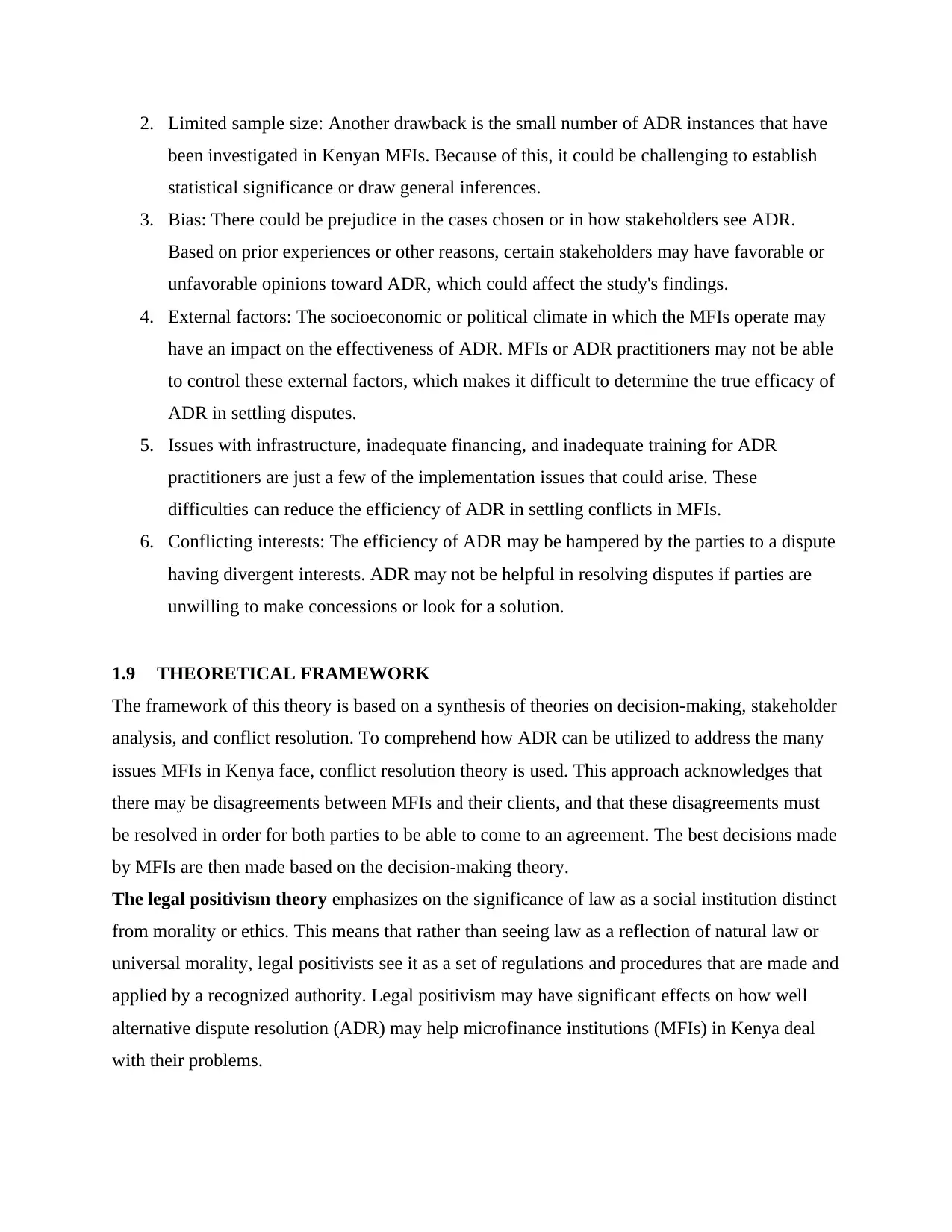
2. Limited sample size: Another drawback is the small number of ADR instances that have
been investigated in Kenyan MFIs. Because of this, it could be challenging to establish
statistical significance or draw general inferences.
3. Bias: There could be prejudice in the cases chosen or in how stakeholders see ADR.
Based on prior experiences or other reasons, certain stakeholders may have favorable or
unfavorable opinions toward ADR, which could affect the study's findings.
4. External factors: The socioeconomic or political climate in which the MFIs operate may
have an impact on the effectiveness of ADR. MFIs or ADR practitioners may not be able
to control these external factors, which makes it difficult to determine the true efficacy of
ADR in settling disputes.
5. Issues with infrastructure, inadequate financing, and inadequate training for ADR
practitioners are just a few of the implementation issues that could arise. These
difficulties can reduce the efficiency of ADR in settling conflicts in MFIs.
6. Conflicting interests: The efficiency of ADR may be hampered by the parties to a dispute
having divergent interests. ADR may not be helpful in resolving disputes if parties are
unwilling to make concessions or look for a solution.
1.9 THEORETICAL FRAMEWORK
The framework of this theory is based on a synthesis of theories on decision-making, stakeholder
analysis, and conflict resolution. To comprehend how ADR can be utilized to address the many
issues MFIs in Kenya face, conflict resolution theory is used. This approach acknowledges that
there may be disagreements between MFIs and their clients, and that these disagreements must
be resolved in order for both parties to be able to come to an agreement. The best decisions made
by MFIs are then made based on the decision-making theory.
The legal positivism theory emphasizes on the significance of law as a social institution distinct
from morality or ethics. This means that rather than seeing law as a reflection of natural law or
universal morality, legal positivists see it as a set of regulations and procedures that are made and
applied by a recognized authority. Legal positivism may have significant effects on how well
alternative dispute resolution (ADR) may help microfinance institutions (MFIs) in Kenya deal
with their problems.
been investigated in Kenyan MFIs. Because of this, it could be challenging to establish
statistical significance or draw general inferences.
3. Bias: There could be prejudice in the cases chosen or in how stakeholders see ADR.
Based on prior experiences or other reasons, certain stakeholders may have favorable or
unfavorable opinions toward ADR, which could affect the study's findings.
4. External factors: The socioeconomic or political climate in which the MFIs operate may
have an impact on the effectiveness of ADR. MFIs or ADR practitioners may not be able
to control these external factors, which makes it difficult to determine the true efficacy of
ADR in settling disputes.
5. Issues with infrastructure, inadequate financing, and inadequate training for ADR
practitioners are just a few of the implementation issues that could arise. These
difficulties can reduce the efficiency of ADR in settling conflicts in MFIs.
6. Conflicting interests: The efficiency of ADR may be hampered by the parties to a dispute
having divergent interests. ADR may not be helpful in resolving disputes if parties are
unwilling to make concessions or look for a solution.
1.9 THEORETICAL FRAMEWORK
The framework of this theory is based on a synthesis of theories on decision-making, stakeholder
analysis, and conflict resolution. To comprehend how ADR can be utilized to address the many
issues MFIs in Kenya face, conflict resolution theory is used. This approach acknowledges that
there may be disagreements between MFIs and their clients, and that these disagreements must
be resolved in order for both parties to be able to come to an agreement. The best decisions made
by MFIs are then made based on the decision-making theory.
The legal positivism theory emphasizes on the significance of law as a social institution distinct
from morality or ethics. This means that rather than seeing law as a reflection of natural law or
universal morality, legal positivists see it as a set of regulations and procedures that are made and
applied by a recognized authority. Legal positivism may have significant effects on how well
alternative dispute resolution (ADR) may help microfinance institutions (MFIs) in Kenya deal
with their problems.
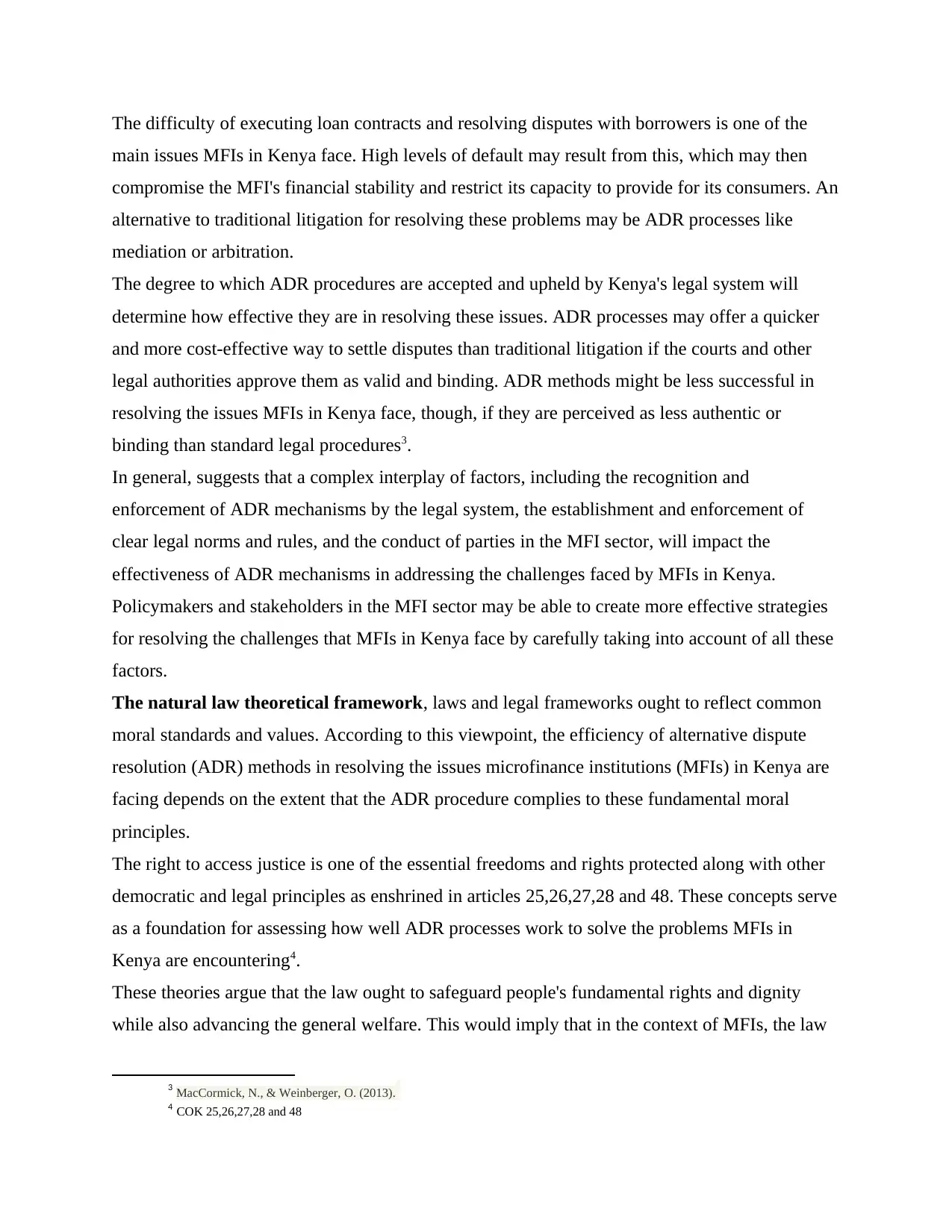
The difficulty of executing loan contracts and resolving disputes with borrowers is one of the
main issues MFIs in Kenya face. High levels of default may result from this, which may then
compromise the MFI's financial stability and restrict its capacity to provide for its consumers. An
alternative to traditional litigation for resolving these problems may be ADR processes like
mediation or arbitration.
The degree to which ADR procedures are accepted and upheld by Kenya's legal system will
determine how effective they are in resolving these issues. ADR processes may offer a quicker
and more cost-effective way to settle disputes than traditional litigation if the courts and other
legal authorities approve them as valid and binding. ADR methods might be less successful in
resolving the issues MFIs in Kenya face, though, if they are perceived as less authentic or
binding than standard legal procedures3.
In general, suggests that a complex interplay of factors, including the recognition and
enforcement of ADR mechanisms by the legal system, the establishment and enforcement of
clear legal norms and rules, and the conduct of parties in the MFI sector, will impact the
effectiveness of ADR mechanisms in addressing the challenges faced by MFIs in Kenya.
Policymakers and stakeholders in the MFI sector may be able to create more effective strategies
for resolving the challenges that MFIs in Kenya face by carefully taking into account of all these
factors.
The natural law theoretical framework, laws and legal frameworks ought to reflect common
moral standards and values. According to this viewpoint, the efficiency of alternative dispute
resolution (ADR) methods in resolving the issues microfinance institutions (MFIs) in Kenya are
facing depends on the extent that the ADR procedure complies to these fundamental moral
principles.
The right to access justice is one of the essential freedoms and rights protected along with other
democratic and legal principles as enshrined in articles 25,26,27,28 and 48. These concepts serve
as a foundation for assessing how well ADR processes work to solve the problems MFIs in
Kenya are encountering4.
These theories argue that the law ought to safeguard people's fundamental rights and dignity
while also advancing the general welfare. This would imply that in the context of MFIs, the law
3 MacCormick, N., & Weinberger, O. (2013).
4 COK 25,26,27,28 and 48
main issues MFIs in Kenya face. High levels of default may result from this, which may then
compromise the MFI's financial stability and restrict its capacity to provide for its consumers. An
alternative to traditional litigation for resolving these problems may be ADR processes like
mediation or arbitration.
The degree to which ADR procedures are accepted and upheld by Kenya's legal system will
determine how effective they are in resolving these issues. ADR processes may offer a quicker
and more cost-effective way to settle disputes than traditional litigation if the courts and other
legal authorities approve them as valid and binding. ADR methods might be less successful in
resolving the issues MFIs in Kenya face, though, if they are perceived as less authentic or
binding than standard legal procedures3.
In general, suggests that a complex interplay of factors, including the recognition and
enforcement of ADR mechanisms by the legal system, the establishment and enforcement of
clear legal norms and rules, and the conduct of parties in the MFI sector, will impact the
effectiveness of ADR mechanisms in addressing the challenges faced by MFIs in Kenya.
Policymakers and stakeholders in the MFI sector may be able to create more effective strategies
for resolving the challenges that MFIs in Kenya face by carefully taking into account of all these
factors.
The natural law theoretical framework, laws and legal frameworks ought to reflect common
moral standards and values. According to this viewpoint, the efficiency of alternative dispute
resolution (ADR) methods in resolving the issues microfinance institutions (MFIs) in Kenya are
facing depends on the extent that the ADR procedure complies to these fundamental moral
principles.
The right to access justice is one of the essential freedoms and rights protected along with other
democratic and legal principles as enshrined in articles 25,26,27,28 and 48. These concepts serve
as a foundation for assessing how well ADR processes work to solve the problems MFIs in
Kenya are encountering4.
These theories argue that the law ought to safeguard people's fundamental rights and dignity
while also advancing the general welfare. This would imply that in the context of MFIs, the law
3 MacCormick, N., & Weinberger, O. (2013).
4 COK 25,26,27,28 and 48
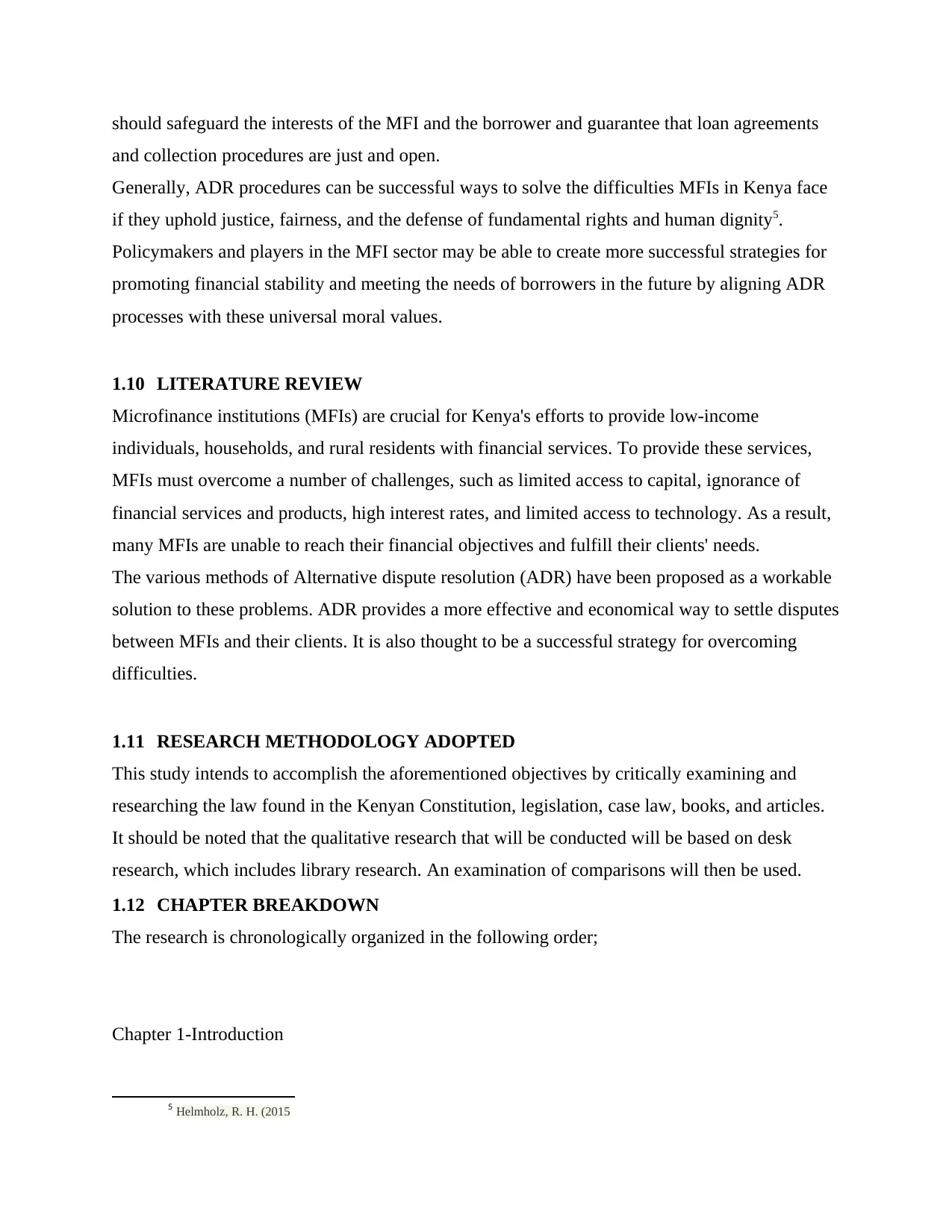
should safeguard the interests of the MFI and the borrower and guarantee that loan agreements
and collection procedures are just and open.
Generally, ADR procedures can be successful ways to solve the difficulties MFIs in Kenya face
if they uphold justice, fairness, and the defense of fundamental rights and human dignity5.
Policymakers and players in the MFI sector may be able to create more successful strategies for
promoting financial stability and meeting the needs of borrowers in the future by aligning ADR
processes with these universal moral values.
1.10 LITERATURE REVIEW
Microfinance institutions (MFIs) are crucial for Kenya's efforts to provide low-income
individuals, households, and rural residents with financial services. To provide these services,
MFIs must overcome a number of challenges, such as limited access to capital, ignorance of
financial services and products, high interest rates, and limited access to technology. As a result,
many MFIs are unable to reach their financial objectives and fulfill their clients' needs.
The various methods of Alternative dispute resolution (ADR) have been proposed as a workable
solution to these problems. ADR provides a more effective and economical way to settle disputes
between MFIs and their clients. It is also thought to be a successful strategy for overcoming
difficulties.
1.11 RESEARCH METHODOLOGY ADOPTED
This study intends to accomplish the aforementioned objectives by critically examining and
researching the law found in the Kenyan Constitution, legislation, case law, books, and articles.
It should be noted that the qualitative research that will be conducted will be based on desk
research, which includes library research. An examination of comparisons will then be used.
1.12 CHAPTER BREAKDOWN
The research is chronologically organized in the following order;
Chapter 1-Introduction
5 Helmholz, R. H. (2015
and collection procedures are just and open.
Generally, ADR procedures can be successful ways to solve the difficulties MFIs in Kenya face
if they uphold justice, fairness, and the defense of fundamental rights and human dignity5.
Policymakers and players in the MFI sector may be able to create more successful strategies for
promoting financial stability and meeting the needs of borrowers in the future by aligning ADR
processes with these universal moral values.
1.10 LITERATURE REVIEW
Microfinance institutions (MFIs) are crucial for Kenya's efforts to provide low-income
individuals, households, and rural residents with financial services. To provide these services,
MFIs must overcome a number of challenges, such as limited access to capital, ignorance of
financial services and products, high interest rates, and limited access to technology. As a result,
many MFIs are unable to reach their financial objectives and fulfill their clients' needs.
The various methods of Alternative dispute resolution (ADR) have been proposed as a workable
solution to these problems. ADR provides a more effective and economical way to settle disputes
between MFIs and their clients. It is also thought to be a successful strategy for overcoming
difficulties.
1.11 RESEARCH METHODOLOGY ADOPTED
This study intends to accomplish the aforementioned objectives by critically examining and
researching the law found in the Kenyan Constitution, legislation, case law, books, and articles.
It should be noted that the qualitative research that will be conducted will be based on desk
research, which includes library research. An examination of comparisons will then be used.
1.12 CHAPTER BREAKDOWN
The research is chronologically organized in the following order;
Chapter 1-Introduction
5 Helmholz, R. H. (2015
Secure Best Marks with AI Grader
Need help grading? Try our AI Grader for instant feedback on your assignments.
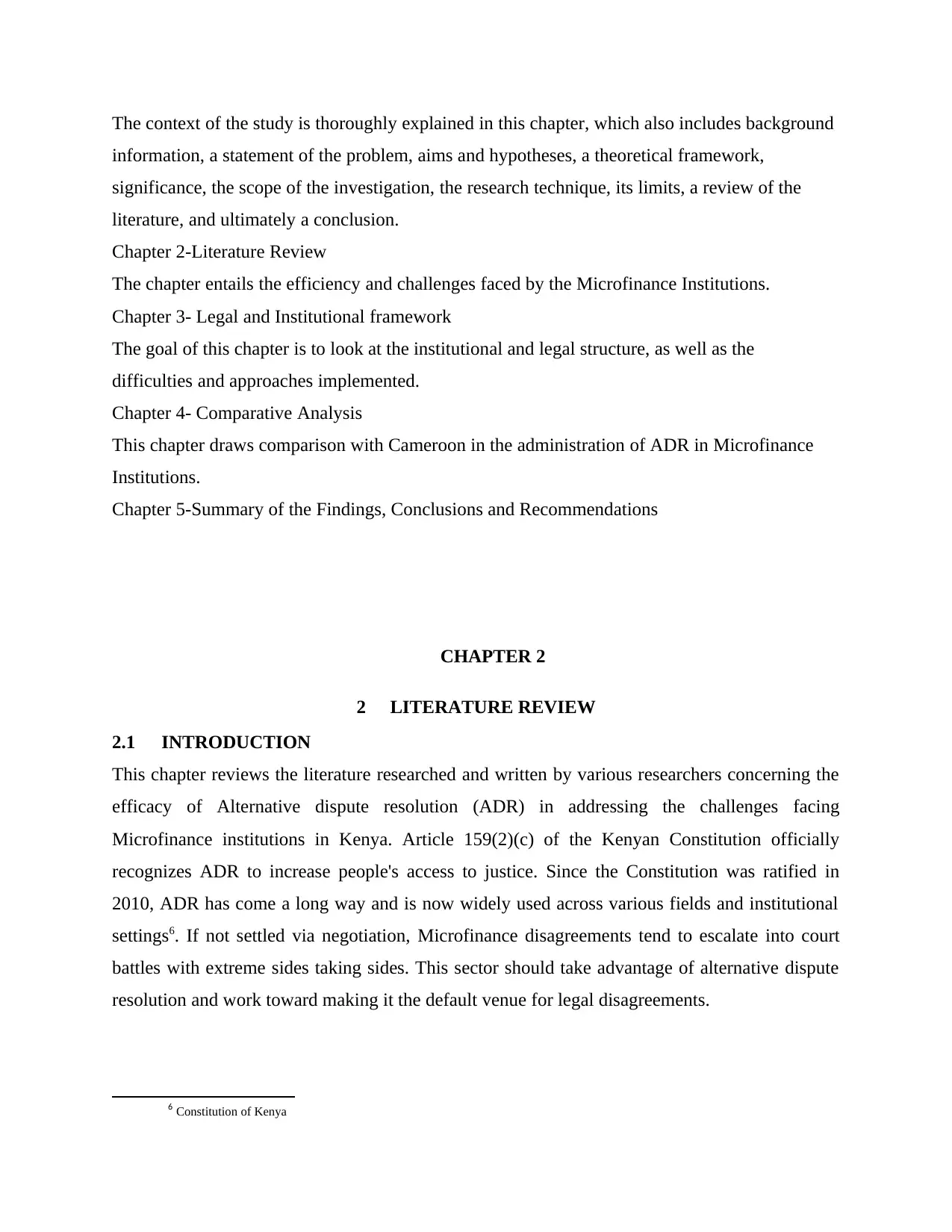
The context of the study is thoroughly explained in this chapter, which also includes background
information, a statement of the problem, aims and hypotheses, a theoretical framework,
significance, the scope of the investigation, the research technique, its limits, a review of the
literature, and ultimately a conclusion.
Chapter 2-Literature Review
The chapter entails the efficiency and challenges faced by the Microfinance Institutions.
Chapter 3- Legal and Institutional framework
The goal of this chapter is to look at the institutional and legal structure, as well as the
difficulties and approaches implemented.
Chapter 4- Comparative Analysis
This chapter draws comparison with Cameroon in the administration of ADR in Microfinance
Institutions.
Chapter 5-Summary of the Findings, Conclusions and Recommendations
CHAPTER 2
2 LITERATURE REVIEW
2.1 INTRODUCTION
This chapter reviews the literature researched and written by various researchers concerning the
efficacy of Alternative dispute resolution (ADR) in addressing the challenges facing
Microfinance institutions in Kenya. Article 159(2)(c) of the Kenyan Constitution officially
recognizes ADR to increase people's access to justice. Since the Constitution was ratified in
2010, ADR has come a long way and is now widely used across various fields and institutional
settings6. If not settled via negotiation, Microfinance disagreements tend to escalate into court
battles with extreme sides taking sides. This sector should take advantage of alternative dispute
resolution and work toward making it the default venue for legal disagreements.
6 Constitution of Kenya
information, a statement of the problem, aims and hypotheses, a theoretical framework,
significance, the scope of the investigation, the research technique, its limits, a review of the
literature, and ultimately a conclusion.
Chapter 2-Literature Review
The chapter entails the efficiency and challenges faced by the Microfinance Institutions.
Chapter 3- Legal and Institutional framework
The goal of this chapter is to look at the institutional and legal structure, as well as the
difficulties and approaches implemented.
Chapter 4- Comparative Analysis
This chapter draws comparison with Cameroon in the administration of ADR in Microfinance
Institutions.
Chapter 5-Summary of the Findings, Conclusions and Recommendations
CHAPTER 2
2 LITERATURE REVIEW
2.1 INTRODUCTION
This chapter reviews the literature researched and written by various researchers concerning the
efficacy of Alternative dispute resolution (ADR) in addressing the challenges facing
Microfinance institutions in Kenya. Article 159(2)(c) of the Kenyan Constitution officially
recognizes ADR to increase people's access to justice. Since the Constitution was ratified in
2010, ADR has come a long way and is now widely used across various fields and institutional
settings6. If not settled via negotiation, Microfinance disagreements tend to escalate into court
battles with extreme sides taking sides. This sector should take advantage of alternative dispute
resolution and work toward making it the default venue for legal disagreements.
6 Constitution of Kenya
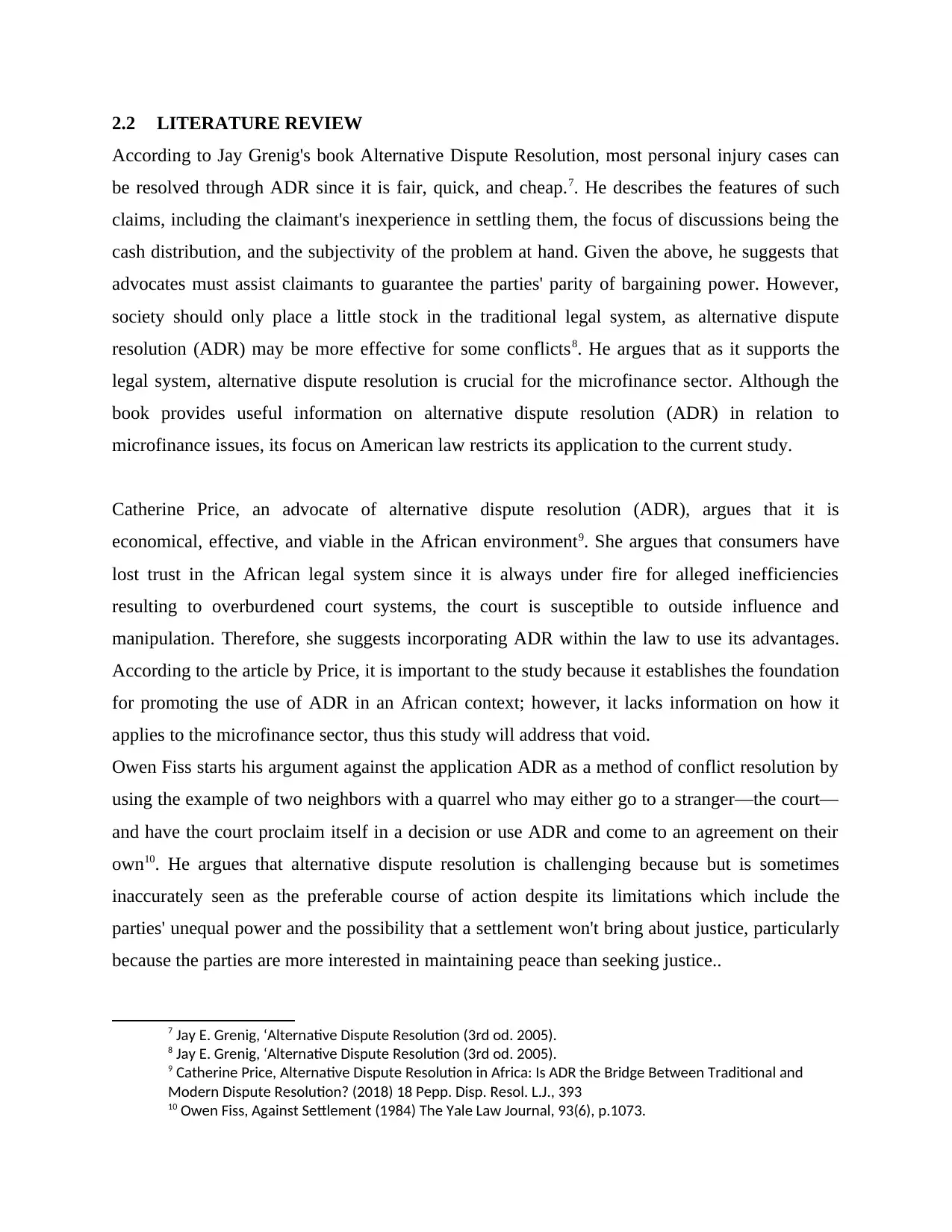
2.2 LITERATURE REVIEW
According to Jay Grenig's book Alternative Dispute Resolution, most personal injury cases can
be resolved through ADR since it is fair, quick, and cheap.7. He describes the features of such
claims, including the claimant's inexperience in settling them, the focus of discussions being the
cash distribution, and the subjectivity of the problem at hand. Given the above, he suggests that
advocates must assist claimants to guarantee the parties' parity of bargaining power. However,
society should only place a little stock in the traditional legal system, as alternative dispute
resolution (ADR) may be more effective for some conflicts8. He argues that as it supports the
legal system, alternative dispute resolution is crucial for the microfinance sector. Although the
book provides useful information on alternative dispute resolution (ADR) in relation to
microfinance issues, its focus on American law restricts its application to the current study.
Catherine Price, an advocate of alternative dispute resolution (ADR), argues that it is
economical, effective, and viable in the African environment9. She argues that consumers have
lost trust in the African legal system since it is always under fire for alleged inefficiencies
resulting to overburdened court systems, the court is susceptible to outside influence and
manipulation. Therefore, she suggests incorporating ADR within the law to use its advantages.
According to the article by Price, it is important to the study because it establishes the foundation
for promoting the use of ADR in an African context; however, it lacks information on how it
applies to the microfinance sector, thus this study will address that void.
Owen Fiss starts his argument against the application ADR as a method of conflict resolution by
using the example of two neighbors with a quarrel who may either go to a stranger—the court—
and have the court proclaim itself in a decision or use ADR and come to an agreement on their
own10. He argues that alternative dispute resolution is challenging because but is sometimes
inaccurately seen as the preferable course of action despite its limitations which include the
parties' unequal power and the possibility that a settlement won't bring about justice, particularly
because the parties are more interested in maintaining peace than seeking justice..
7 Jay E. Grenig, ‘Alternative Dispute Resolution (3rd od. 2005).
8 Jay E. Grenig, ‘Alternative Dispute Resolution (3rd od. 2005).
9 Catherine Price, Alternative Dispute Resolution in Africa: Is ADR the Bridge Between Traditional and
Modern Dispute Resolution? (2018) 18 Pepp. Disp. Resol. L.J., 393
10 Owen Fiss, Against Settlement (1984) The Yale Law Journal, 93(6), p.1073.
According to Jay Grenig's book Alternative Dispute Resolution, most personal injury cases can
be resolved through ADR since it is fair, quick, and cheap.7. He describes the features of such
claims, including the claimant's inexperience in settling them, the focus of discussions being the
cash distribution, and the subjectivity of the problem at hand. Given the above, he suggests that
advocates must assist claimants to guarantee the parties' parity of bargaining power. However,
society should only place a little stock in the traditional legal system, as alternative dispute
resolution (ADR) may be more effective for some conflicts8. He argues that as it supports the
legal system, alternative dispute resolution is crucial for the microfinance sector. Although the
book provides useful information on alternative dispute resolution (ADR) in relation to
microfinance issues, its focus on American law restricts its application to the current study.
Catherine Price, an advocate of alternative dispute resolution (ADR), argues that it is
economical, effective, and viable in the African environment9. She argues that consumers have
lost trust in the African legal system since it is always under fire for alleged inefficiencies
resulting to overburdened court systems, the court is susceptible to outside influence and
manipulation. Therefore, she suggests incorporating ADR within the law to use its advantages.
According to the article by Price, it is important to the study because it establishes the foundation
for promoting the use of ADR in an African context; however, it lacks information on how it
applies to the microfinance sector, thus this study will address that void.
Owen Fiss starts his argument against the application ADR as a method of conflict resolution by
using the example of two neighbors with a quarrel who may either go to a stranger—the court—
and have the court proclaim itself in a decision or use ADR and come to an agreement on their
own10. He argues that alternative dispute resolution is challenging because but is sometimes
inaccurately seen as the preferable course of action despite its limitations which include the
parties' unequal power and the possibility that a settlement won't bring about justice, particularly
because the parties are more interested in maintaining peace than seeking justice..
7 Jay E. Grenig, ‘Alternative Dispute Resolution (3rd od. 2005).
8 Jay E. Grenig, ‘Alternative Dispute Resolution (3rd od. 2005).
9 Catherine Price, Alternative Dispute Resolution in Africa: Is ADR the Bridge Between Traditional and
Modern Dispute Resolution? (2018) 18 Pepp. Disp. Resol. L.J., 393
10 Owen Fiss, Against Settlement (1984) The Yale Law Journal, 93(6), p.1073.
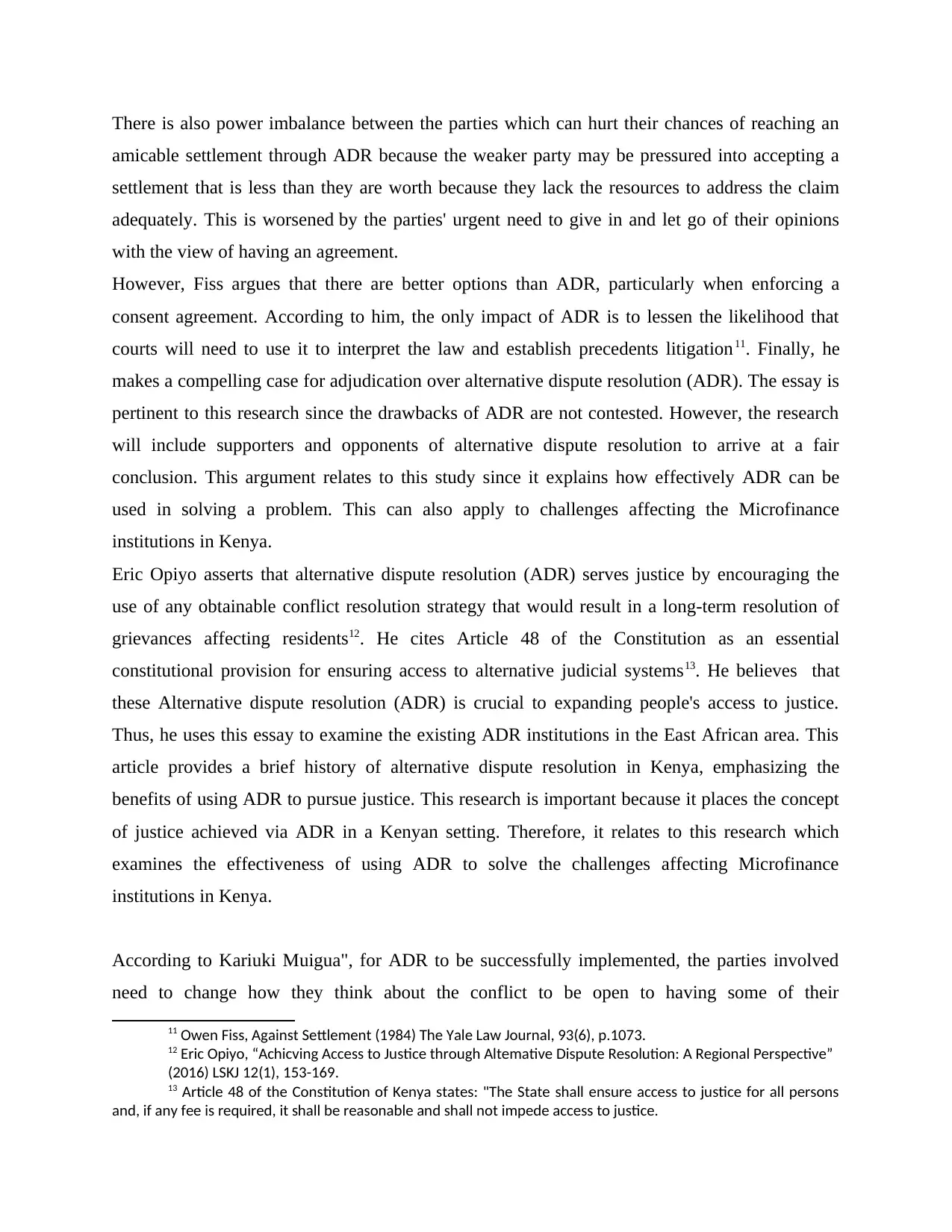
There is also power imbalance between the parties which can hurt their chances of reaching an
amicable settlement through ADR because the weaker party may be pressured into accepting a
settlement that is less than they are worth because they lack the resources to address the claim
adequately. This is worsened by the parties' urgent need to give in and let go of their opinions
with the view of having an agreement.
However, Fiss argues that there are better options than ADR, particularly when enforcing a
consent agreement. According to him, the only impact of ADR is to lessen the likelihood that
courts will need to use it to interpret the law and establish precedents litigation11. Finally, he
makes a compelling case for adjudication over alternative dispute resolution (ADR). The essay is
pertinent to this research since the drawbacks of ADR are not contested. However, the research
will include supporters and opponents of alternative dispute resolution to arrive at a fair
conclusion. This argument relates to this study since it explains how effectively ADR can be
used in solving a problem. This can also apply to challenges affecting the Microfinance
institutions in Kenya.
Eric Opiyo asserts that alternative dispute resolution (ADR) serves justice by encouraging the
use of any obtainable conflict resolution strategy that would result in a long-term resolution of
grievances affecting residents12. He cites Article 48 of the Constitution as an essential
constitutional provision for ensuring access to alternative judicial systems13. He believes that
these Alternative dispute resolution (ADR) is crucial to expanding people's access to justice.
Thus, he uses this essay to examine the existing ADR institutions in the East African area. This
article provides a brief history of alternative dispute resolution in Kenya, emphasizing the
benefits of using ADR to pursue justice. This research is important because it places the concept
of justice achieved via ADR in a Kenyan setting. Therefore, it relates to this research which
examines the effectiveness of using ADR to solve the challenges affecting Microfinance
institutions in Kenya.
According to Kariuki Muigua", for ADR to be successfully implemented, the parties involved
need to change how they think about the conflict to be open to having some of their
11 Owen Fiss, Against Settlement (1984) The Yale Law Journal, 93(6), p.1073.
12 Eric Opiyo, “Achicving Access to Justice through Altemative Dispute Resolution: A Regional Perspective”
(2016) LSKJ 12(1), 153-169.
13 Article 48 of the Constitution of Kenya states: "The State shall ensure access to justice for all persons
and, if any fee is required, it shall be reasonable and shall not impede access to justice.
amicable settlement through ADR because the weaker party may be pressured into accepting a
settlement that is less than they are worth because they lack the resources to address the claim
adequately. This is worsened by the parties' urgent need to give in and let go of their opinions
with the view of having an agreement.
However, Fiss argues that there are better options than ADR, particularly when enforcing a
consent agreement. According to him, the only impact of ADR is to lessen the likelihood that
courts will need to use it to interpret the law and establish precedents litigation11. Finally, he
makes a compelling case for adjudication over alternative dispute resolution (ADR). The essay is
pertinent to this research since the drawbacks of ADR are not contested. However, the research
will include supporters and opponents of alternative dispute resolution to arrive at a fair
conclusion. This argument relates to this study since it explains how effectively ADR can be
used in solving a problem. This can also apply to challenges affecting the Microfinance
institutions in Kenya.
Eric Opiyo asserts that alternative dispute resolution (ADR) serves justice by encouraging the
use of any obtainable conflict resolution strategy that would result in a long-term resolution of
grievances affecting residents12. He cites Article 48 of the Constitution as an essential
constitutional provision for ensuring access to alternative judicial systems13. He believes that
these Alternative dispute resolution (ADR) is crucial to expanding people's access to justice.
Thus, he uses this essay to examine the existing ADR institutions in the East African area. This
article provides a brief history of alternative dispute resolution in Kenya, emphasizing the
benefits of using ADR to pursue justice. This research is important because it places the concept
of justice achieved via ADR in a Kenyan setting. Therefore, it relates to this research which
examines the effectiveness of using ADR to solve the challenges affecting Microfinance
institutions in Kenya.
According to Kariuki Muigua", for ADR to be successfully implemented, the parties involved
need to change how they think about the conflict to be open to having some of their
11 Owen Fiss, Against Settlement (1984) The Yale Law Journal, 93(6), p.1073.
12 Eric Opiyo, “Achicving Access to Justice through Altemative Dispute Resolution: A Regional Perspective”
(2016) LSKJ 12(1), 153-169.
13 Article 48 of the Constitution of Kenya states: "The State shall ensure access to justice for all persons
and, if any fee is required, it shall be reasonable and shall not impede access to justice.
Paraphrase This Document
Need a fresh take? Get an instant paraphrase of this document with our AI Paraphraser
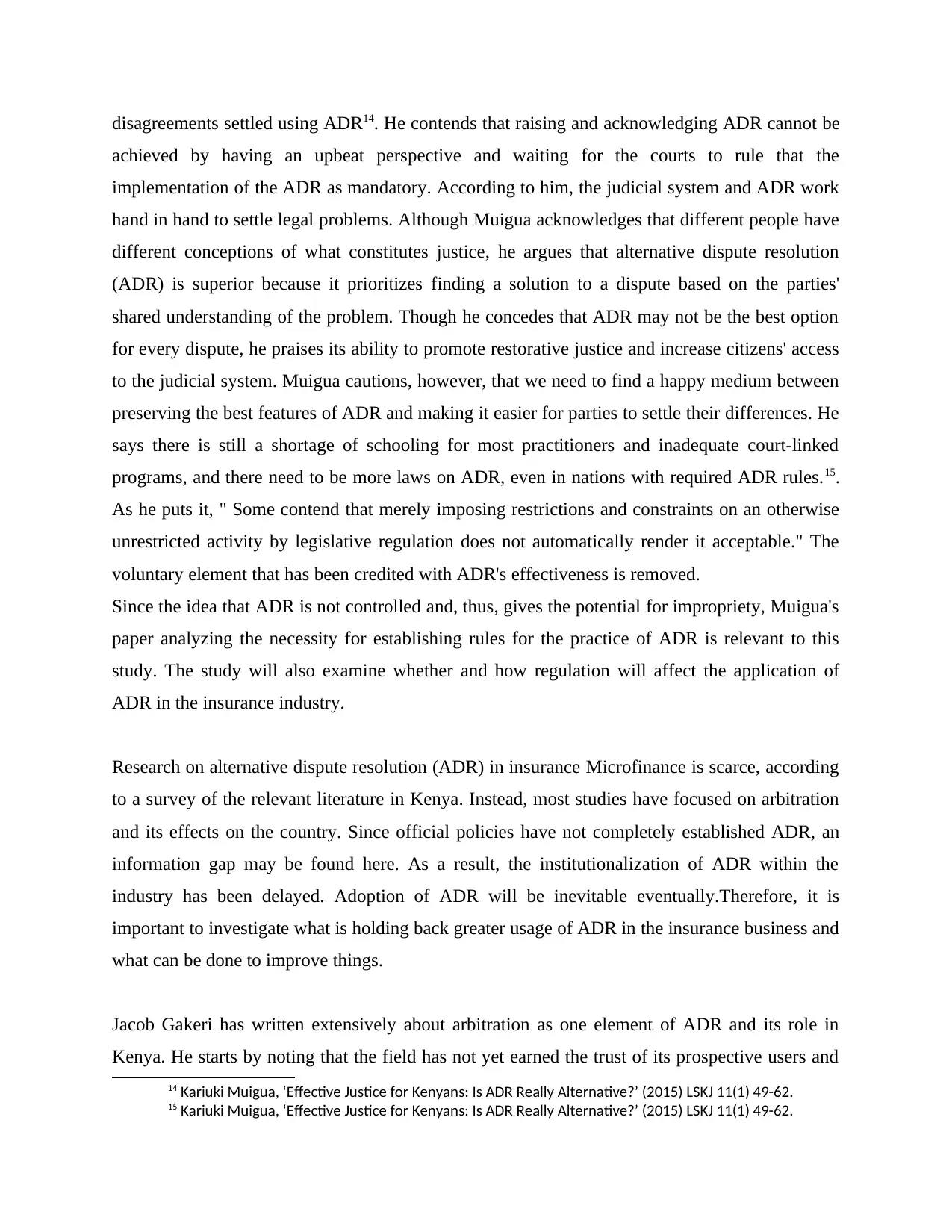
disagreements settled using ADR14. He contends that raising and acknowledging ADR cannot be
achieved by having an upbeat perspective and waiting for the courts to rule that the
implementation of the ADR as mandatory. According to him, the judicial system and ADR work
hand in hand to settle legal problems. Although Muigua acknowledges that different people have
different conceptions of what constitutes justice, he argues that alternative dispute resolution
(ADR) is superior because it prioritizes finding a solution to a dispute based on the parties'
shared understanding of the problem. Though he concedes that ADR may not be the best option
for every dispute, he praises its ability to promote restorative justice and increase citizens' access
to the judicial system. Muigua cautions, however, that we need to find a happy medium between
preserving the best features of ADR and making it easier for parties to settle their differences. He
says there is still a shortage of schooling for most practitioners and inadequate court-linked
programs, and there need to be more laws on ADR, even in nations with required ADR rules.15.
As he puts it, " Some contend that merely imposing restrictions and constraints on an otherwise
unrestricted activity by legislative regulation does not automatically render it acceptable." The
voluntary element that has been credited with ADR's effectiveness is removed.
Since the idea that ADR is not controlled and, thus, gives the potential for impropriety, Muigua's
paper analyzing the necessity for establishing rules for the practice of ADR is relevant to this
study. The study will also examine whether and how regulation will affect the application of
ADR in the insurance industry.
Research on alternative dispute resolution (ADR) in insurance Microfinance is scarce, according
to a survey of the relevant literature in Kenya. Instead, most studies have focused on arbitration
and its effects on the country. Since official policies have not completely established ADR, an
information gap may be found here. As a result, the institutionalization of ADR within the
industry has been delayed. Adoption of ADR will be inevitable eventually.Therefore, it is
important to investigate what is holding back greater usage of ADR in the insurance business and
what can be done to improve things.
Jacob Gakeri has written extensively about arbitration as one element of ADR and its role in
Kenya. He starts by noting that the field has not yet earned the trust of its prospective users and
14 Kariuki Muigua, ‘Effective Justice for Kenyans: Is ADR Really Alternative?’ (2015) LSKJ 11(1) 49-62.
15 Kariuki Muigua, ‘Effective Justice for Kenyans: Is ADR Really Alternative?’ (2015) LSKJ 11(1) 49-62.
achieved by having an upbeat perspective and waiting for the courts to rule that the
implementation of the ADR as mandatory. According to him, the judicial system and ADR work
hand in hand to settle legal problems. Although Muigua acknowledges that different people have
different conceptions of what constitutes justice, he argues that alternative dispute resolution
(ADR) is superior because it prioritizes finding a solution to a dispute based on the parties'
shared understanding of the problem. Though he concedes that ADR may not be the best option
for every dispute, he praises its ability to promote restorative justice and increase citizens' access
to the judicial system. Muigua cautions, however, that we need to find a happy medium between
preserving the best features of ADR and making it easier for parties to settle their differences. He
says there is still a shortage of schooling for most practitioners and inadequate court-linked
programs, and there need to be more laws on ADR, even in nations with required ADR rules.15.
As he puts it, " Some contend that merely imposing restrictions and constraints on an otherwise
unrestricted activity by legislative regulation does not automatically render it acceptable." The
voluntary element that has been credited with ADR's effectiveness is removed.
Since the idea that ADR is not controlled and, thus, gives the potential for impropriety, Muigua's
paper analyzing the necessity for establishing rules for the practice of ADR is relevant to this
study. The study will also examine whether and how regulation will affect the application of
ADR in the insurance industry.
Research on alternative dispute resolution (ADR) in insurance Microfinance is scarce, according
to a survey of the relevant literature in Kenya. Instead, most studies have focused on arbitration
and its effects on the country. Since official policies have not completely established ADR, an
information gap may be found here. As a result, the institutionalization of ADR within the
industry has been delayed. Adoption of ADR will be inevitable eventually.Therefore, it is
important to investigate what is holding back greater usage of ADR in the insurance business and
what can be done to improve things.
Jacob Gakeri has written extensively about arbitration as one element of ADR and its role in
Kenya. He starts by noting that the field has not yet earned the trust of its prospective users and
14 Kariuki Muigua, ‘Effective Justice for Kenyans: Is ADR Really Alternative?’ (2015) LSKJ 11(1) 49-62.
15 Kariuki Muigua, ‘Effective Justice for Kenyans: Is ADR Really Alternative?’ (2015) LSKJ 11(1) 49-62.
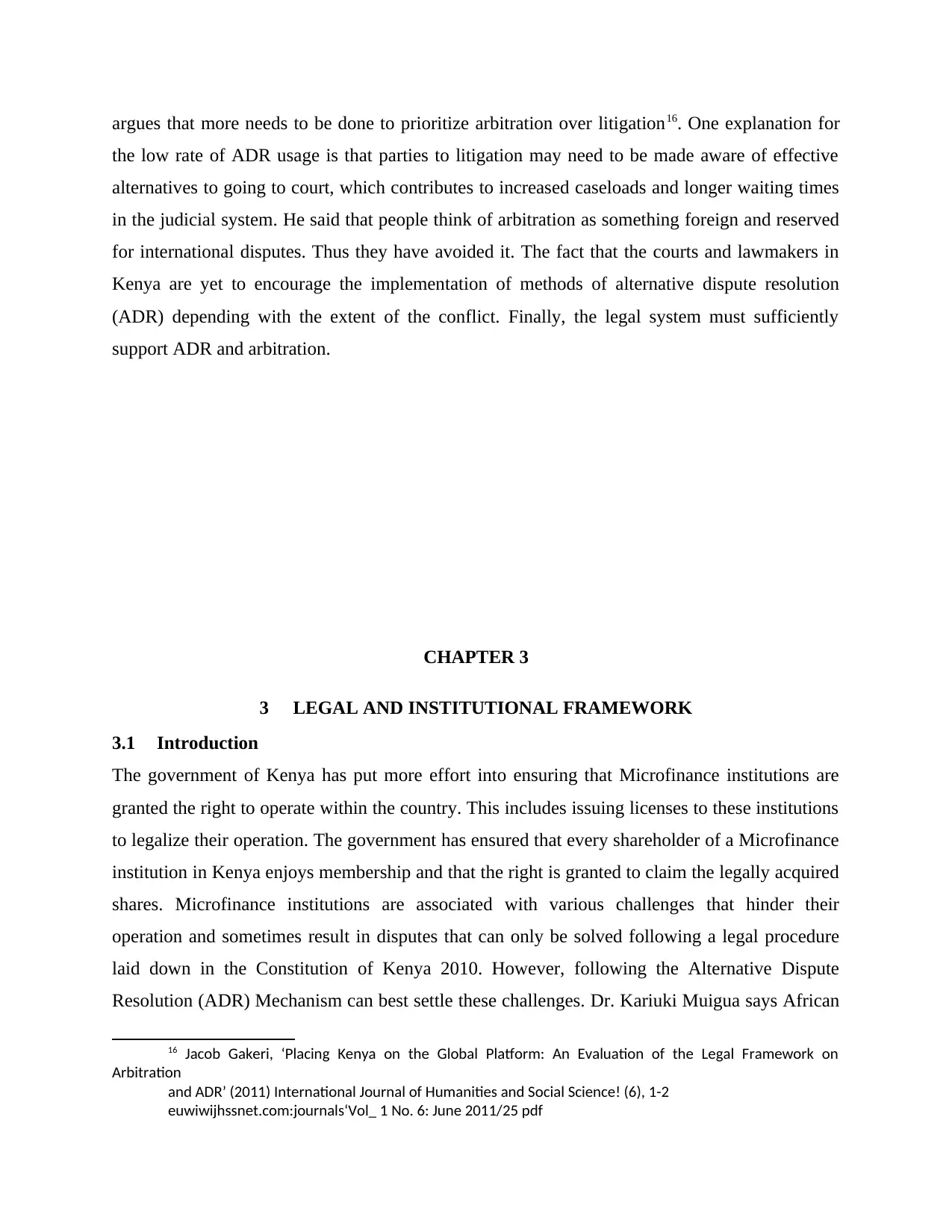
argues that more needs to be done to prioritize arbitration over litigation16. One explanation for
the low rate of ADR usage is that parties to litigation may need to be made aware of effective
alternatives to going to court, which contributes to increased caseloads and longer waiting times
in the judicial system. He said that people think of arbitration as something foreign and reserved
for international disputes. Thus they have avoided it. The fact that the courts and lawmakers in
Kenya are yet to encourage the implementation of methods of alternative dispute resolution
(ADR) depending with the extent of the conflict. Finally, the legal system must sufficiently
support ADR and arbitration.
CHAPTER 3
3 LEGAL AND INSTITUTIONAL FRAMEWORK
3.1 Introduction
The government of Kenya has put more effort into ensuring that Microfinance institutions are
granted the right to operate within the country. This includes issuing licenses to these institutions
to legalize their operation. The government has ensured that every shareholder of a Microfinance
institution in Kenya enjoys membership and that the right is granted to claim the legally acquired
shares. Microfinance institutions are associated with various challenges that hinder their
operation and sometimes result in disputes that can only be solved following a legal procedure
laid down in the Constitution of Kenya 2010. However, following the Alternative Dispute
Resolution (ADR) Mechanism can best settle these challenges. Dr. Kariuki Muigua says African
16 Jacob Gakeri, ‘Placing Kenya on the Global Platform: An Evaluation of the Legal Framework on
Arbitration
and ADR’ (2011) International Journal of Humanities and Social Science! (6), 1-2
euwiwijhssnet.com:journals‘Vol_ 1 No. 6: June 2011/25 pdf
the low rate of ADR usage is that parties to litigation may need to be made aware of effective
alternatives to going to court, which contributes to increased caseloads and longer waiting times
in the judicial system. He said that people think of arbitration as something foreign and reserved
for international disputes. Thus they have avoided it. The fact that the courts and lawmakers in
Kenya are yet to encourage the implementation of methods of alternative dispute resolution
(ADR) depending with the extent of the conflict. Finally, the legal system must sufficiently
support ADR and arbitration.
CHAPTER 3
3 LEGAL AND INSTITUTIONAL FRAMEWORK
3.1 Introduction
The government of Kenya has put more effort into ensuring that Microfinance institutions are
granted the right to operate within the country. This includes issuing licenses to these institutions
to legalize their operation. The government has ensured that every shareholder of a Microfinance
institution in Kenya enjoys membership and that the right is granted to claim the legally acquired
shares. Microfinance institutions are associated with various challenges that hinder their
operation and sometimes result in disputes that can only be solved following a legal procedure
laid down in the Constitution of Kenya 2010. However, following the Alternative Dispute
Resolution (ADR) Mechanism can best settle these challenges. Dr. Kariuki Muigua says African
16 Jacob Gakeri, ‘Placing Kenya on the Global Platform: An Evaluation of the Legal Framework on
Arbitration
and ADR’ (2011) International Journal of Humanities and Social Science! (6), 1-2
euwiwijhssnet.com:journals‘Vol_ 1 No. 6: June 2011/25 pdf
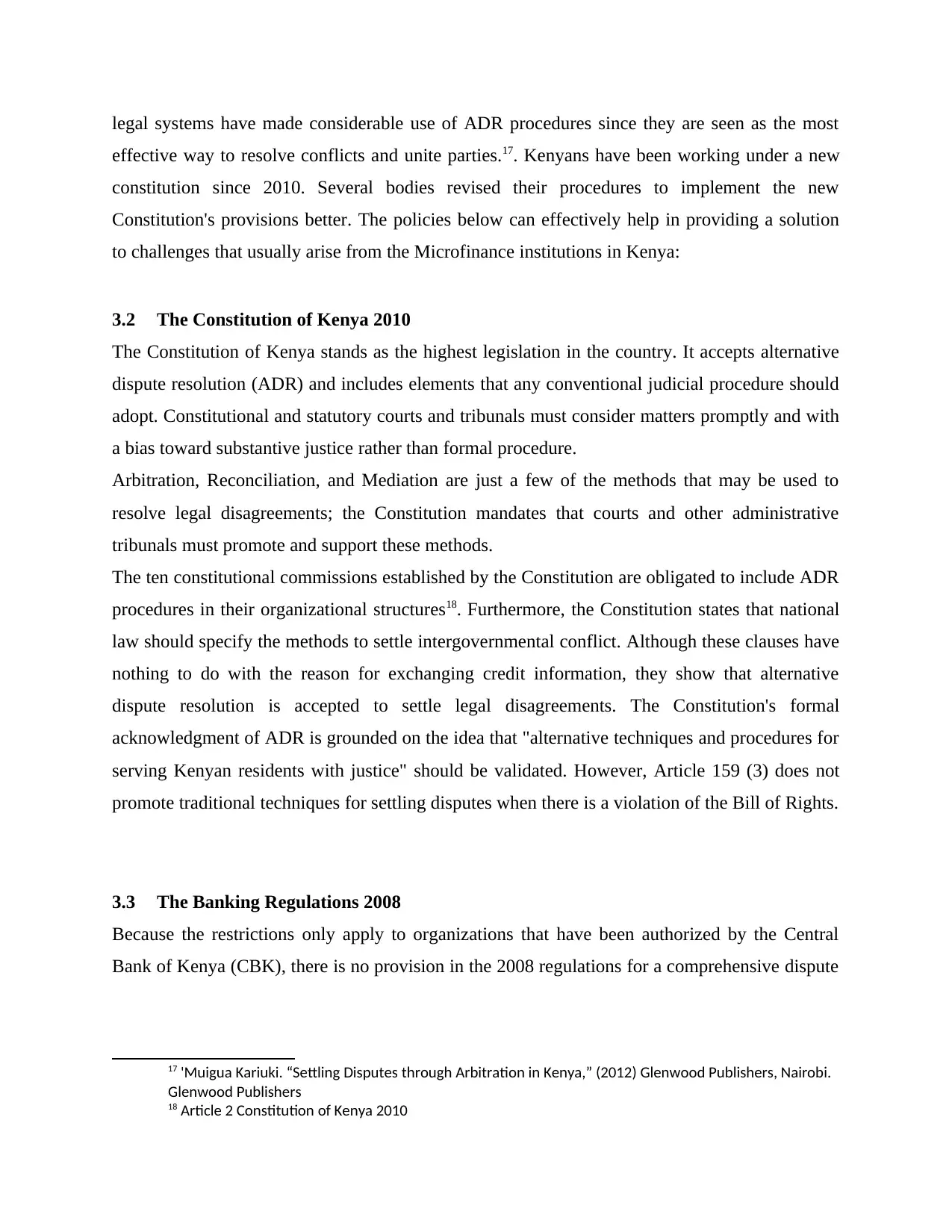
legal systems have made considerable use of ADR procedures since they are seen as the most
effective way to resolve conflicts and unite parties.17. Kenyans have been working under a new
constitution since 2010. Several bodies revised their procedures to implement the new
Constitution's provisions better. The policies below can effectively help in providing a solution
to challenges that usually arise from the Microfinance institutions in Kenya:
3.2 The Constitution of Kenya 2010
The Constitution of Kenya stands as the highest legislation in the country. It accepts alternative
dispute resolution (ADR) and includes elements that any conventional judicial procedure should
adopt. Constitutional and statutory courts and tribunals must consider matters promptly and with
a bias toward substantive justice rather than formal procedure.
Arbitration, Reconciliation, and Mediation are just a few of the methods that may be used to
resolve legal disagreements; the Constitution mandates that courts and other administrative
tribunals must promote and support these methods.
The ten constitutional commissions established by the Constitution are obligated to include ADR
procedures in their organizational structures18. Furthermore, the Constitution states that national
law should specify the methods to settle intergovernmental conflict. Although these clauses have
nothing to do with the reason for exchanging credit information, they show that alternative
dispute resolution is accepted to settle legal disagreements. The Constitution's formal
acknowledgment of ADR is grounded on the idea that "alternative techniques and procedures for
serving Kenyan residents with justice" should be validated. However, Article 159 (3) does not
promote traditional techniques for settling disputes when there is a violation of the Bill of Rights.
3.3 The Banking Regulations 2008
Because the restrictions only apply to organizations that have been authorized by the Central
Bank of Kenya (CBK), there is no provision in the 2008 regulations for a comprehensive dispute
17 'Muigua Kariuki. “Settling Disputes through Arbitration in Kenya,” (2012) Glenwood Publishers, Nairobi.
Glenwood Publishers
18 Article 2 Constitution of Kenya 2010
effective way to resolve conflicts and unite parties.17. Kenyans have been working under a new
constitution since 2010. Several bodies revised their procedures to implement the new
Constitution's provisions better. The policies below can effectively help in providing a solution
to challenges that usually arise from the Microfinance institutions in Kenya:
3.2 The Constitution of Kenya 2010
The Constitution of Kenya stands as the highest legislation in the country. It accepts alternative
dispute resolution (ADR) and includes elements that any conventional judicial procedure should
adopt. Constitutional and statutory courts and tribunals must consider matters promptly and with
a bias toward substantive justice rather than formal procedure.
Arbitration, Reconciliation, and Mediation are just a few of the methods that may be used to
resolve legal disagreements; the Constitution mandates that courts and other administrative
tribunals must promote and support these methods.
The ten constitutional commissions established by the Constitution are obligated to include ADR
procedures in their organizational structures18. Furthermore, the Constitution states that national
law should specify the methods to settle intergovernmental conflict. Although these clauses have
nothing to do with the reason for exchanging credit information, they show that alternative
dispute resolution is accepted to settle legal disagreements. The Constitution's formal
acknowledgment of ADR is grounded on the idea that "alternative techniques and procedures for
serving Kenyan residents with justice" should be validated. However, Article 159 (3) does not
promote traditional techniques for settling disputes when there is a violation of the Bill of Rights.
3.3 The Banking Regulations 2008
Because the restrictions only apply to organizations that have been authorized by the Central
Bank of Kenya (CBK), there is no provision in the 2008 regulations for a comprehensive dispute
17 'Muigua Kariuki. “Settling Disputes through Arbitration in Kenya,” (2012) Glenwood Publishers, Nairobi.
Glenwood Publishers
18 Article 2 Constitution of Kenya 2010
Secure Best Marks with AI Grader
Need help grading? Try our AI Grader for instant feedback on your assignments.
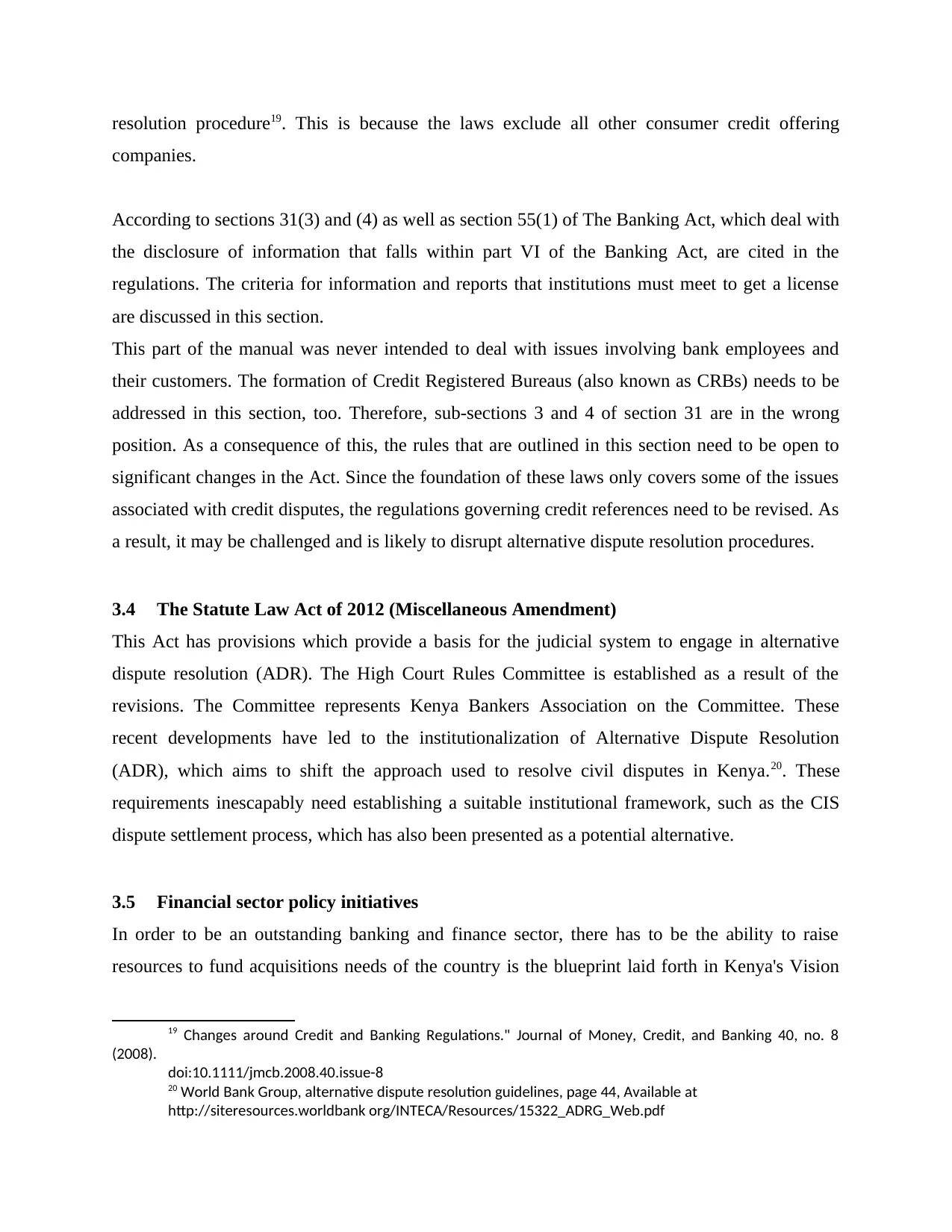
resolution procedure19. This is because the laws exclude all other consumer credit offering
companies.
According to sections 31(3) and (4) as well as section 55(1) of The Banking Act, which deal with
the disclosure of information that falls within part VI of the Banking Act, are cited in the
regulations. The criteria for information and reports that institutions must meet to get a license
are discussed in this section.
This part of the manual was never intended to deal with issues involving bank employees and
their customers. The formation of Credit Registered Bureaus (also known as CRBs) needs to be
addressed in this section, too. Therefore, sub-sections 3 and 4 of section 31 are in the wrong
position. As a consequence of this, the rules that are outlined in this section need to be open to
significant changes in the Act. Since the foundation of these laws only covers some of the issues
associated with credit disputes, the regulations governing credit references need to be revised. As
a result, it may be challenged and is likely to disrupt alternative dispute resolution procedures.
3.4 The Statute Law Act of 2012 (Miscellaneous Amendment)
This Act has provisions which provide a basis for the judicial system to engage in alternative
dispute resolution (ADR). The High Court Rules Committee is established as a result of the
revisions. The Committee represents Kenya Bankers Association on the Committee. These
recent developments have led to the institutionalization of Alternative Dispute Resolution
(ADR), which aims to shift the approach used to resolve civil disputes in Kenya.20. These
requirements inescapably need establishing a suitable institutional framework, such as the CIS
dispute settlement process, which has also been presented as a potential alternative.
3.5 Financial sector policy initiatives
In order to be an outstanding banking and finance sector, there has to be the ability to raise
resources to fund acquisitions needs of the country is the blueprint laid forth in Kenya's Vision
19 Changes around Credit and Banking Regulations." Journal of Money, Credit, and Banking 40, no. 8
(2008).
doi:10.1111/jmcb.2008.40.issue-8
20 World Bank Group, alternative dispute resolution guidelines, page 44, Available at
http://siteresources.worldbank org/INTECA/Resources/15322_ADRG_Web.pdf
companies.
According to sections 31(3) and (4) as well as section 55(1) of The Banking Act, which deal with
the disclosure of information that falls within part VI of the Banking Act, are cited in the
regulations. The criteria for information and reports that institutions must meet to get a license
are discussed in this section.
This part of the manual was never intended to deal with issues involving bank employees and
their customers. The formation of Credit Registered Bureaus (also known as CRBs) needs to be
addressed in this section, too. Therefore, sub-sections 3 and 4 of section 31 are in the wrong
position. As a consequence of this, the rules that are outlined in this section need to be open to
significant changes in the Act. Since the foundation of these laws only covers some of the issues
associated with credit disputes, the regulations governing credit references need to be revised. As
a result, it may be challenged and is likely to disrupt alternative dispute resolution procedures.
3.4 The Statute Law Act of 2012 (Miscellaneous Amendment)
This Act has provisions which provide a basis for the judicial system to engage in alternative
dispute resolution (ADR). The High Court Rules Committee is established as a result of the
revisions. The Committee represents Kenya Bankers Association on the Committee. These
recent developments have led to the institutionalization of Alternative Dispute Resolution
(ADR), which aims to shift the approach used to resolve civil disputes in Kenya.20. These
requirements inescapably need establishing a suitable institutional framework, such as the CIS
dispute settlement process, which has also been presented as a potential alternative.
3.5 Financial sector policy initiatives
In order to be an outstanding banking and finance sector, there has to be the ability to raise
resources to fund acquisitions needs of the country is the blueprint laid forth in Kenya's Vision
19 Changes around Credit and Banking Regulations." Journal of Money, Credit, and Banking 40, no. 8
(2008).
doi:10.1111/jmcb.2008.40.issue-8
20 World Bank Group, alternative dispute resolution guidelines, page 44, Available at
http://siteresources.worldbank org/INTECA/Resources/15322_ADRG_Web.pdf
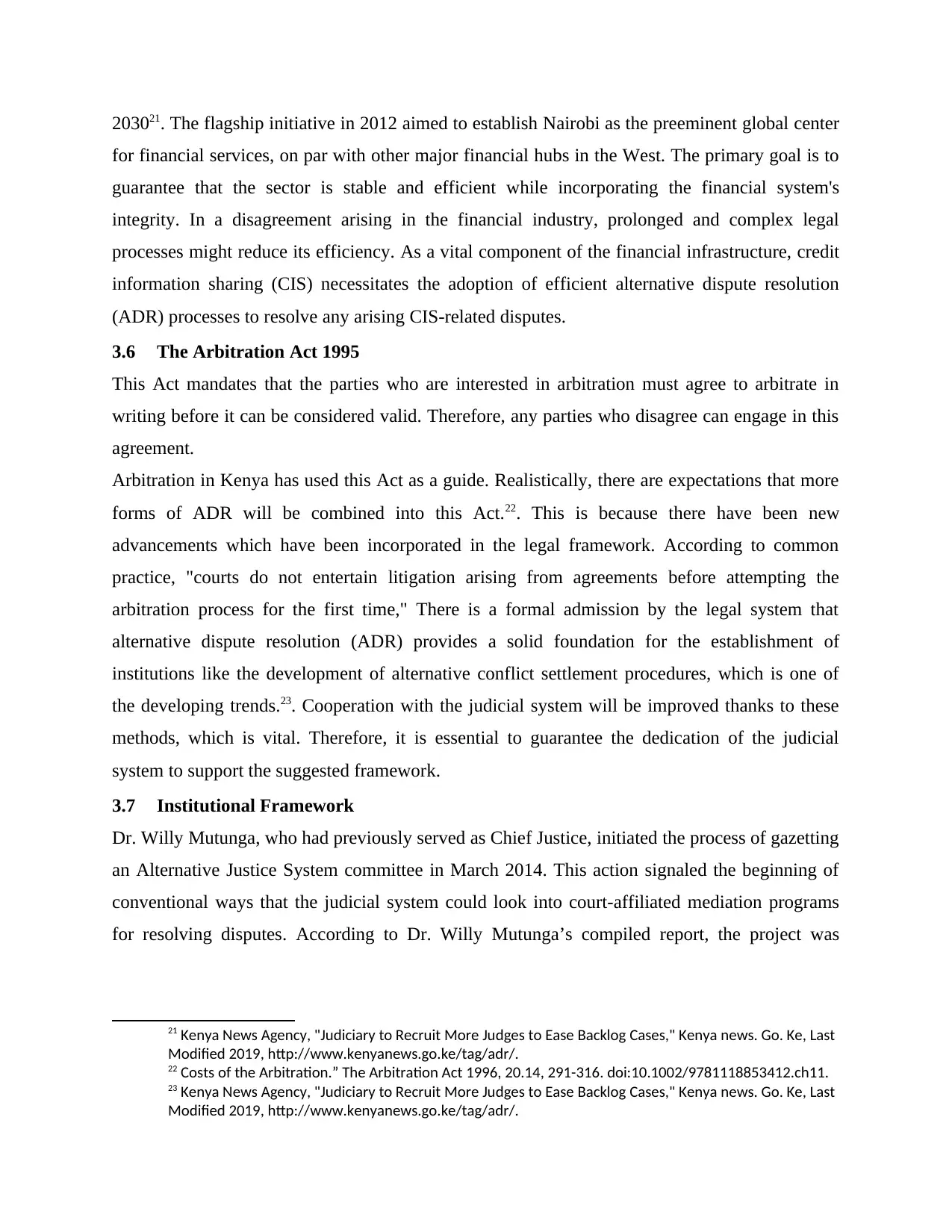
203021. The flagship initiative in 2012 aimed to establish Nairobi as the preeminent global center
for financial services, on par with other major financial hubs in the West. The primary goal is to
guarantee that the sector is stable and efficient while incorporating the financial system's
integrity. In a disagreement arising in the financial industry, prolonged and complex legal
processes might reduce its efficiency. As a vital component of the financial infrastructure, credit
information sharing (CIS) necessitates the adoption of efficient alternative dispute resolution
(ADR) processes to resolve any arising CIS-related disputes.
3.6 The Arbitration Act 1995
This Act mandates that the parties who are interested in arbitration must agree to arbitrate in
writing before it can be considered valid. Therefore, any parties who disagree can engage in this
agreement.
Arbitration in Kenya has used this Act as a guide. Realistically, there are expectations that more
forms of ADR will be combined into this Act.22. This is because there have been new
advancements which have been incorporated in the legal framework. According to common
practice, "courts do not entertain litigation arising from agreements before attempting the
arbitration process for the first time," There is a formal admission by the legal system that
alternative dispute resolution (ADR) provides a solid foundation for the establishment of
institutions like the development of alternative conflict settlement procedures, which is one of
the developing trends.23. Cooperation with the judicial system will be improved thanks to these
methods, which is vital. Therefore, it is essential to guarantee the dedication of the judicial
system to support the suggested framework.
3.7 Institutional Framework
Dr. Willy Mutunga, who had previously served as Chief Justice, initiated the process of gazetting
an Alternative Justice System committee in March 2014. This action signaled the beginning of
conventional ways that the judicial system could look into court-affiliated mediation programs
for resolving disputes. According to Dr. Willy Mutunga’s compiled report, the project was
21 Kenya News Agency, "Judiciary to Recruit More Judges to Ease Backlog Cases," Kenya news. Go. Ke, Last
Modified 2019, http://www.kenyanews.go.ke/tag/adr/.
22 Costs of the Arbitration.” The Arbitration Act 1996, 20.14, 291-316. doi:10.1002/9781118853412.ch11.
23 Kenya News Agency, "Judiciary to Recruit More Judges to Ease Backlog Cases," Kenya news. Go. Ke, Last
Modified 2019, http://www.kenyanews.go.ke/tag/adr/.
for financial services, on par with other major financial hubs in the West. The primary goal is to
guarantee that the sector is stable and efficient while incorporating the financial system's
integrity. In a disagreement arising in the financial industry, prolonged and complex legal
processes might reduce its efficiency. As a vital component of the financial infrastructure, credit
information sharing (CIS) necessitates the adoption of efficient alternative dispute resolution
(ADR) processes to resolve any arising CIS-related disputes.
3.6 The Arbitration Act 1995
This Act mandates that the parties who are interested in arbitration must agree to arbitrate in
writing before it can be considered valid. Therefore, any parties who disagree can engage in this
agreement.
Arbitration in Kenya has used this Act as a guide. Realistically, there are expectations that more
forms of ADR will be combined into this Act.22. This is because there have been new
advancements which have been incorporated in the legal framework. According to common
practice, "courts do not entertain litigation arising from agreements before attempting the
arbitration process for the first time," There is a formal admission by the legal system that
alternative dispute resolution (ADR) provides a solid foundation for the establishment of
institutions like the development of alternative conflict settlement procedures, which is one of
the developing trends.23. Cooperation with the judicial system will be improved thanks to these
methods, which is vital. Therefore, it is essential to guarantee the dedication of the judicial
system to support the suggested framework.
3.7 Institutional Framework
Dr. Willy Mutunga, who had previously served as Chief Justice, initiated the process of gazetting
an Alternative Justice System committee in March 2014. This action signaled the beginning of
conventional ways that the judicial system could look into court-affiliated mediation programs
for resolving disputes. According to Dr. Willy Mutunga’s compiled report, the project was
21 Kenya News Agency, "Judiciary to Recruit More Judges to Ease Backlog Cases," Kenya news. Go. Ke, Last
Modified 2019, http://www.kenyanews.go.ke/tag/adr/.
22 Costs of the Arbitration.” The Arbitration Act 1996, 20.14, 291-316. doi:10.1002/9781118853412.ch11.
23 Kenya News Agency, "Judiciary to Recruit More Judges to Ease Backlog Cases," Kenya news. Go. Ke, Last
Modified 2019, http://www.kenyanews.go.ke/tag/adr/.
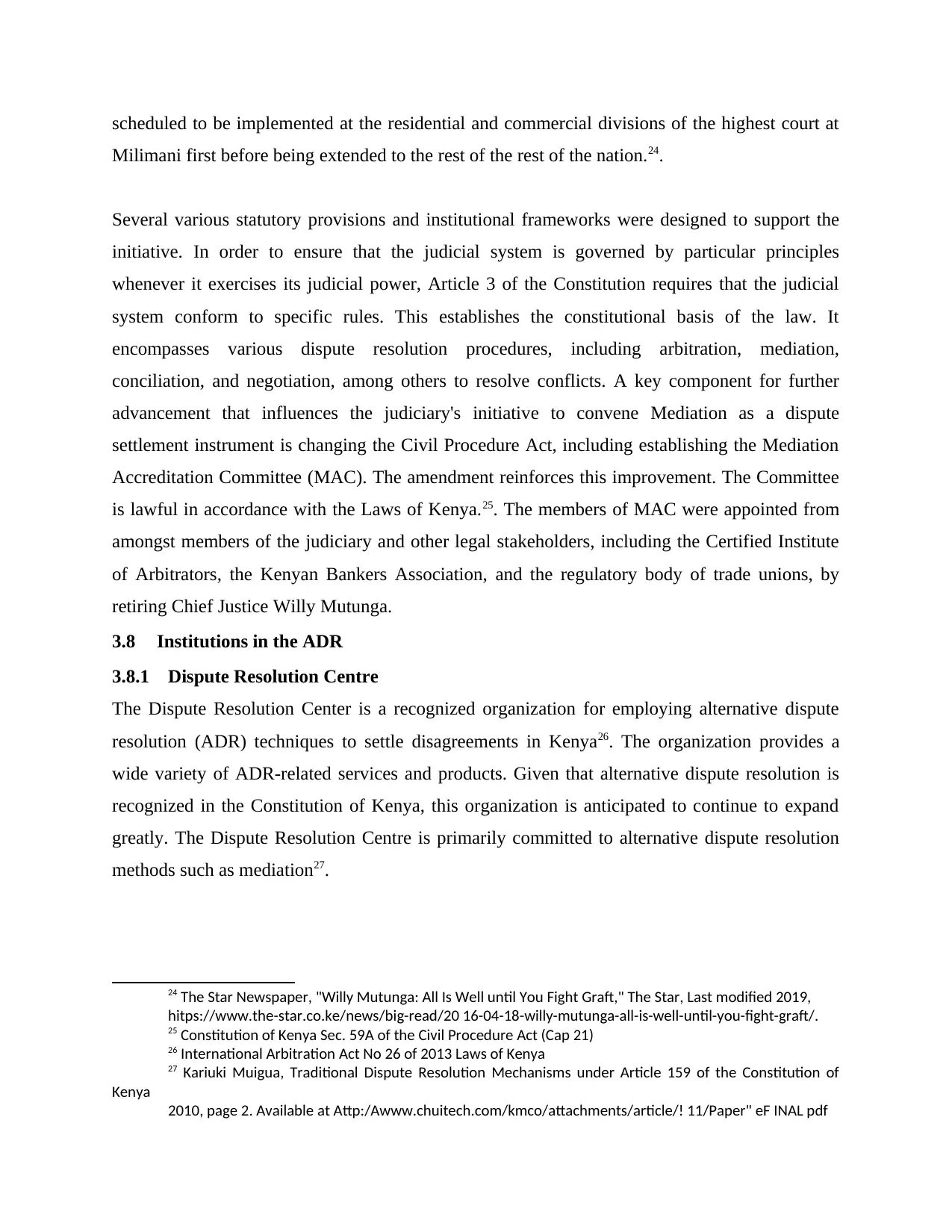
scheduled to be implemented at the residential and commercial divisions of the highest court at
Milimani first before being extended to the rest of the rest of the nation.24.
Several various statutory provisions and institutional frameworks were designed to support the
initiative. In order to ensure that the judicial system is governed by particular principles
whenever it exercises its judicial power, Article 3 of the Constitution requires that the judicial
system conform to specific rules. This establishes the constitutional basis of the law. It
encompasses various dispute resolution procedures, including arbitration, mediation,
conciliation, and negotiation, among others to resolve conflicts. A key component for further
advancement that influences the judiciary's initiative to convene Mediation as a dispute
settlement instrument is changing the Civil Procedure Act, including establishing the Mediation
Accreditation Committee (MAC). The amendment reinforces this improvement. The Committee
is lawful in accordance with the Laws of Kenya.25. The members of MAC were appointed from
amongst members of the judiciary and other legal stakeholders, including the Certified Institute
of Arbitrators, the Kenyan Bankers Association, and the regulatory body of trade unions, by
retiring Chief Justice Willy Mutunga.
3.8 Institutions in the ADR
3.8.1 Dispute Resolution Centre
The Dispute Resolution Center is a recognized organization for employing alternative dispute
resolution (ADR) techniques to settle disagreements in Kenya26. The organization provides a
wide variety of ADR-related services and products. Given that alternative dispute resolution is
recognized in the Constitution of Kenya, this organization is anticipated to continue to expand
greatly. The Dispute Resolution Centre is primarily committed to alternative dispute resolution
methods such as mediation27.
24 The Star Newspaper, "Willy Mutunga: All Is Well until You Fight Graft," The Star, Last modified 2019,
hitps://www.the-star.co.ke/news/big-read/20 16-04-18-willy-mutunga-all-is-well-until-you-fight-graft/.
25 Constitution of Kenya Sec. 59A of the Civil Procedure Act (Cap 21)
26 International Arbitration Act No 26 of 2013 Laws of Kenya
27 Kariuki Muigua, Traditional Dispute Resolution Mechanisms under Article 159 of the Constitution of
Kenya
2010, page 2. Available at Attp:/Awww.chuitech.com/kmco/attachments/article/! 11/Paper" eF INAL pdf
Milimani first before being extended to the rest of the rest of the nation.24.
Several various statutory provisions and institutional frameworks were designed to support the
initiative. In order to ensure that the judicial system is governed by particular principles
whenever it exercises its judicial power, Article 3 of the Constitution requires that the judicial
system conform to specific rules. This establishes the constitutional basis of the law. It
encompasses various dispute resolution procedures, including arbitration, mediation,
conciliation, and negotiation, among others to resolve conflicts. A key component for further
advancement that influences the judiciary's initiative to convene Mediation as a dispute
settlement instrument is changing the Civil Procedure Act, including establishing the Mediation
Accreditation Committee (MAC). The amendment reinforces this improvement. The Committee
is lawful in accordance with the Laws of Kenya.25. The members of MAC were appointed from
amongst members of the judiciary and other legal stakeholders, including the Certified Institute
of Arbitrators, the Kenyan Bankers Association, and the regulatory body of trade unions, by
retiring Chief Justice Willy Mutunga.
3.8 Institutions in the ADR
3.8.1 Dispute Resolution Centre
The Dispute Resolution Center is a recognized organization for employing alternative dispute
resolution (ADR) techniques to settle disagreements in Kenya26. The organization provides a
wide variety of ADR-related services and products. Given that alternative dispute resolution is
recognized in the Constitution of Kenya, this organization is anticipated to continue to expand
greatly. The Dispute Resolution Centre is primarily committed to alternative dispute resolution
methods such as mediation27.
24 The Star Newspaper, "Willy Mutunga: All Is Well until You Fight Graft," The Star, Last modified 2019,
hitps://www.the-star.co.ke/news/big-read/20 16-04-18-willy-mutunga-all-is-well-until-you-fight-graft/.
25 Constitution of Kenya Sec. 59A of the Civil Procedure Act (Cap 21)
26 International Arbitration Act No 26 of 2013 Laws of Kenya
27 Kariuki Muigua, Traditional Dispute Resolution Mechanisms under Article 159 of the Constitution of
Kenya
2010, page 2. Available at Attp:/Awww.chuitech.com/kmco/attachments/article/! 11/Paper" eF INAL pdf
Paraphrase This Document
Need a fresh take? Get an instant paraphrase of this document with our AI Paraphraser
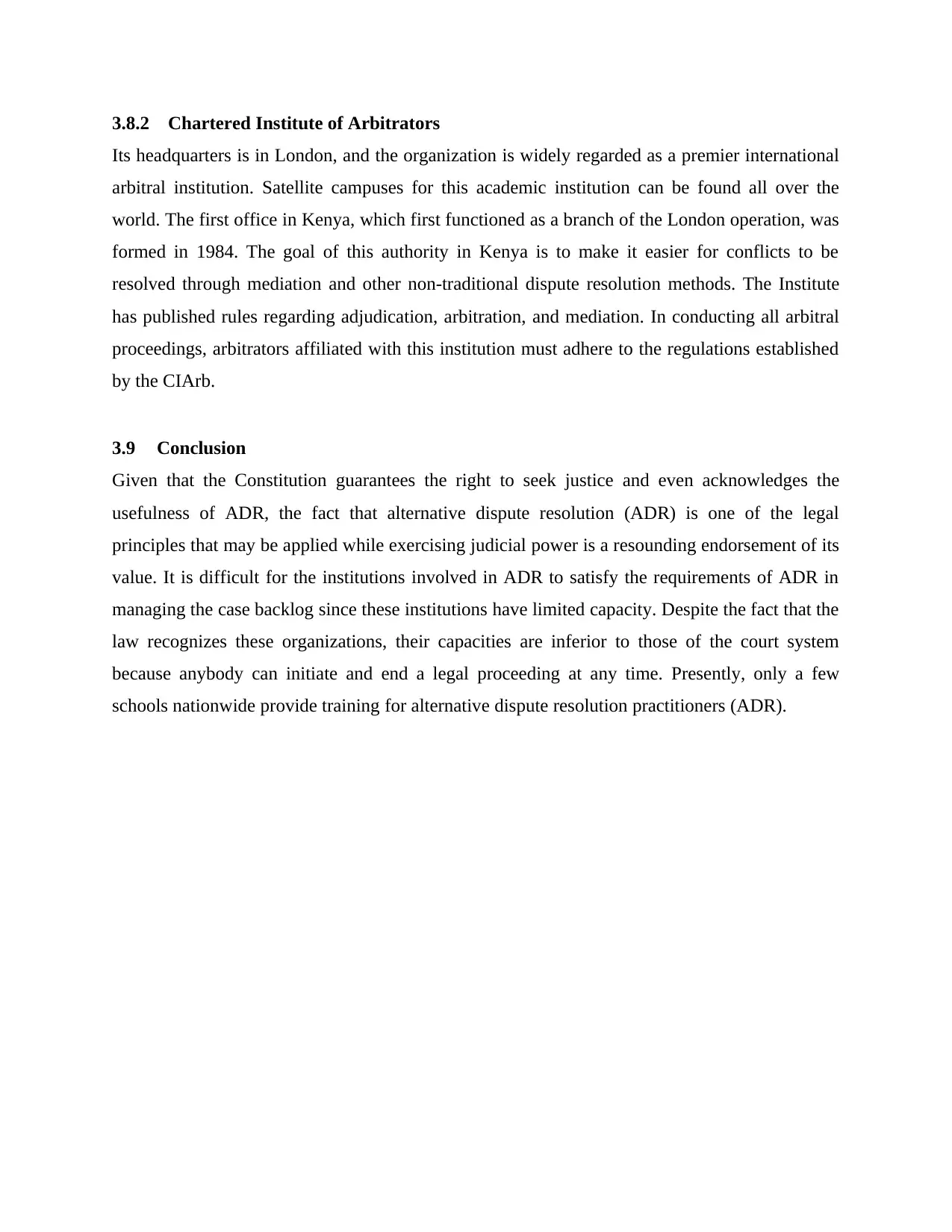
3.8.2 Chartered Institute of Arbitrators
Its headquarters is in London, and the organization is widely regarded as a premier international
arbitral institution. Satellite campuses for this academic institution can be found all over the
world. The first office in Kenya, which first functioned as a branch of the London operation, was
formed in 1984. The goal of this authority in Kenya is to make it easier for conflicts to be
resolved through mediation and other non-traditional dispute resolution methods. The Institute
has published rules regarding adjudication, arbitration, and mediation. In conducting all arbitral
proceedings, arbitrators affiliated with this institution must adhere to the regulations established
by the CIArb.
3.9 Conclusion
Given that the Constitution guarantees the right to seek justice and even acknowledges the
usefulness of ADR, the fact that alternative dispute resolution (ADR) is one of the legal
principles that may be applied while exercising judicial power is a resounding endorsement of its
value. It is difficult for the institutions involved in ADR to satisfy the requirements of ADR in
managing the case backlog since these institutions have limited capacity. Despite the fact that the
law recognizes these organizations, their capacities are inferior to those of the court system
because anybody can initiate and end a legal proceeding at any time. Presently, only a few
schools nationwide provide training for alternative dispute resolution practitioners (ADR).
Its headquarters is in London, and the organization is widely regarded as a premier international
arbitral institution. Satellite campuses for this academic institution can be found all over the
world. The first office in Kenya, which first functioned as a branch of the London operation, was
formed in 1984. The goal of this authority in Kenya is to make it easier for conflicts to be
resolved through mediation and other non-traditional dispute resolution methods. The Institute
has published rules regarding adjudication, arbitration, and mediation. In conducting all arbitral
proceedings, arbitrators affiliated with this institution must adhere to the regulations established
by the CIArb.
3.9 Conclusion
Given that the Constitution guarantees the right to seek justice and even acknowledges the
usefulness of ADR, the fact that alternative dispute resolution (ADR) is one of the legal
principles that may be applied while exercising judicial power is a resounding endorsement of its
value. It is difficult for the institutions involved in ADR to satisfy the requirements of ADR in
managing the case backlog since these institutions have limited capacity. Despite the fact that the
law recognizes these organizations, their capacities are inferior to those of the court system
because anybody can initiate and end a legal proceeding at any time. Presently, only a few
schools nationwide provide training for alternative dispute resolution practitioners (ADR).
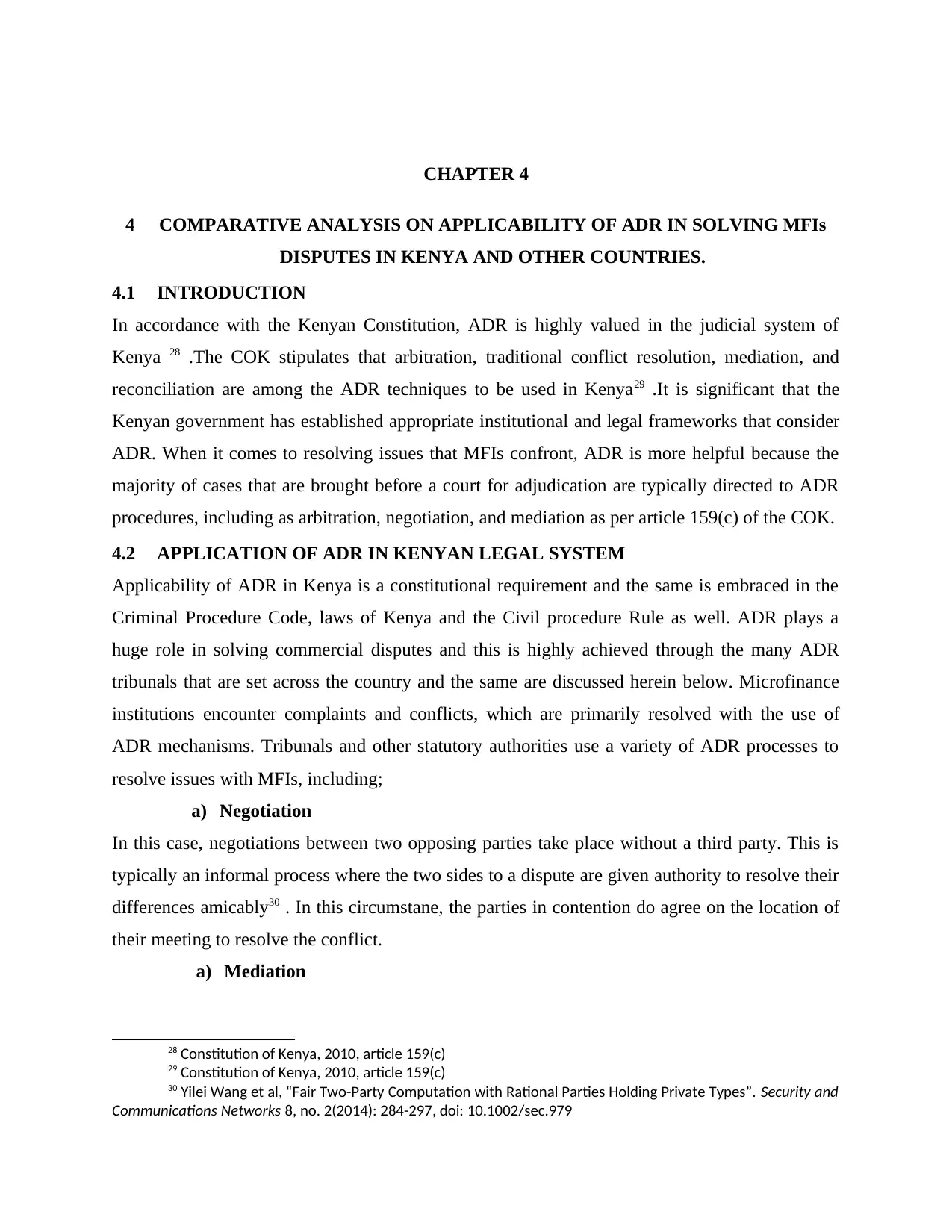
CHAPTER 4
4 COMPARATIVE ANALYSIS ON APPLICABILITY OF ADR IN SOLVING MFIs
DISPUTES IN KENYA AND OTHER COUNTRIES.
4.1 INTRODUCTION
In accordance with the Kenyan Constitution, ADR is highly valued in the judicial system of
Kenya 28 .The COK stipulates that arbitration, traditional conflict resolution, mediation, and
reconciliation are among the ADR techniques to be used in Kenya29 .It is significant that the
Kenyan government has established appropriate institutional and legal frameworks that consider
ADR. When it comes to resolving issues that MFIs confront, ADR is more helpful because the
majority of cases that are brought before a court for adjudication are typically directed to ADR
procedures, including as arbitration, negotiation, and mediation as per article 159(c) of the COK.
4.2 APPLICATION OF ADR IN KENYAN LEGAL SYSTEM
Applicability of ADR in Kenya is a constitutional requirement and the same is embraced in the
Criminal Procedure Code, laws of Kenya and the Civil procedure Rule as well. ADR plays a
huge role in solving commercial disputes and this is highly achieved through the many ADR
tribunals that are set across the country and the same are discussed herein below. Microfinance
institutions encounter complaints and conflicts, which are primarily resolved with the use of
ADR mechanisms. Tribunals and other statutory authorities use a variety of ADR processes to
resolve issues with MFIs, including;
a) Negotiation
In this case, negotiations between two opposing parties take place without a third party. This is
typically an informal process where the two sides to a dispute are given authority to resolve their
differences amicably30 . In this circumstane, the parties in contention do agree on the location of
their meeting to resolve the conflict.
a) Mediation
28 Constitution of Kenya, 2010, article 159(c)
29 Constitution of Kenya, 2010, article 159(c)
30 Yilei Wang et al, “Fair Two-Party Computation with Rational Parties Holding Private Types”. Security and
Communications Networks 8, no. 2(2014): 284-297, doi: 10.1002/sec.979
4 COMPARATIVE ANALYSIS ON APPLICABILITY OF ADR IN SOLVING MFIs
DISPUTES IN KENYA AND OTHER COUNTRIES.
4.1 INTRODUCTION
In accordance with the Kenyan Constitution, ADR is highly valued in the judicial system of
Kenya 28 .The COK stipulates that arbitration, traditional conflict resolution, mediation, and
reconciliation are among the ADR techniques to be used in Kenya29 .It is significant that the
Kenyan government has established appropriate institutional and legal frameworks that consider
ADR. When it comes to resolving issues that MFIs confront, ADR is more helpful because the
majority of cases that are brought before a court for adjudication are typically directed to ADR
procedures, including as arbitration, negotiation, and mediation as per article 159(c) of the COK.
4.2 APPLICATION OF ADR IN KENYAN LEGAL SYSTEM
Applicability of ADR in Kenya is a constitutional requirement and the same is embraced in the
Criminal Procedure Code, laws of Kenya and the Civil procedure Rule as well. ADR plays a
huge role in solving commercial disputes and this is highly achieved through the many ADR
tribunals that are set across the country and the same are discussed herein below. Microfinance
institutions encounter complaints and conflicts, which are primarily resolved with the use of
ADR mechanisms. Tribunals and other statutory authorities use a variety of ADR processes to
resolve issues with MFIs, including;
a) Negotiation
In this case, negotiations between two opposing parties take place without a third party. This is
typically an informal process where the two sides to a dispute are given authority to resolve their
differences amicably30 . In this circumstane, the parties in contention do agree on the location of
their meeting to resolve the conflict.
a) Mediation
28 Constitution of Kenya, 2010, article 159(c)
29 Constitution of Kenya, 2010, article 159(c)
30 Yilei Wang et al, “Fair Two-Party Computation with Rational Parties Holding Private Types”. Security and
Communications Networks 8, no. 2(2014): 284-297, doi: 10.1002/sec.979
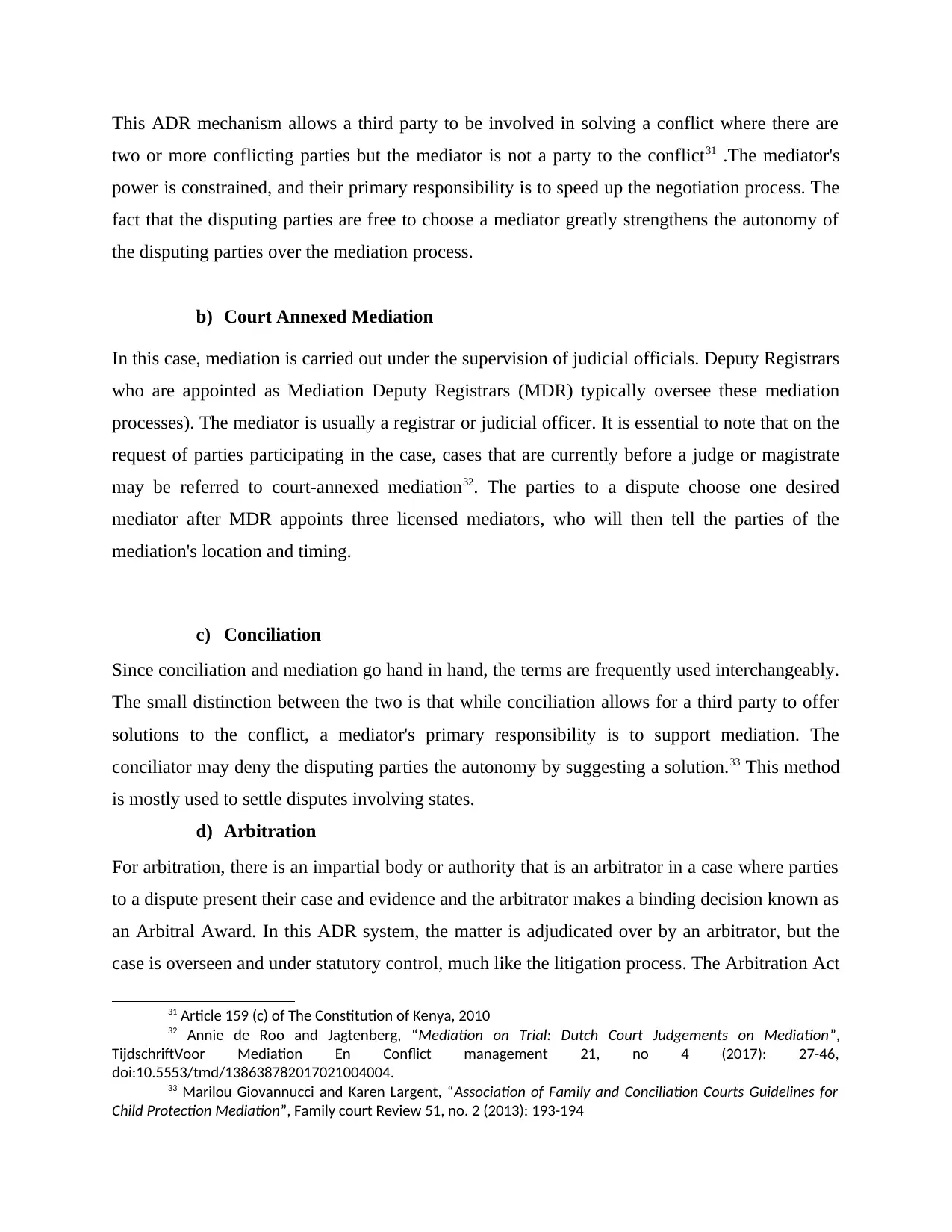
This ADR mechanism allows a third party to be involved in solving a conflict where there are
two or more conflicting parties but the mediator is not a party to the conflict31 .The mediator's
power is constrained, and their primary responsibility is to speed up the negotiation process. The
fact that the disputing parties are free to choose a mediator greatly strengthens the autonomy of
the disputing parties over the mediation process.
b) Court Annexed Mediation
In this case, mediation is carried out under the supervision of judicial officials. Deputy Registrars
who are appointed as Mediation Deputy Registrars (MDR) typically oversee these mediation
processes). The mediator is usually a registrar or judicial officer. It is essential to note that on the
request of parties participating in the case, cases that are currently before a judge or magistrate
may be referred to court-annexed mediation32. The parties to a dispute choose one desired
mediator after MDR appoints three licensed mediators, who will then tell the parties of the
mediation's location and timing.
c) Conciliation
Since conciliation and mediation go hand in hand, the terms are frequently used interchangeably.
The small distinction between the two is that while conciliation allows for a third party to offer
solutions to the conflict, a mediator's primary responsibility is to support mediation. The
conciliator may deny the disputing parties the autonomy by suggesting a solution.33 This method
is mostly used to settle disputes involving states.
d) Arbitration
For arbitration, there is an impartial body or authority that is an arbitrator in a case where parties
to a dispute present their case and evidence and the arbitrator makes a binding decision known as
an Arbitral Award. In this ADR system, the matter is adjudicated over by an arbitrator, but the
case is overseen and under statutory control, much like the litigation process. The Arbitration Act
31 Article 159 (c) of The Constitution of Kenya, 2010
32 Annie de Roo and Jagtenberg, “Mediation on Trial: Dutch Court Judgements on Mediation”,
TijdschriftVoor Mediation En Conflict management 21, no 4 (2017): 27-46,
doi:10.5553/tmd/138638782017021004004.
33 Marilou Giovannucci and Karen Largent, “Association of Family and Conciliation Courts Guidelines for
Child Protection Mediation”, Family court Review 51, no. 2 (2013): 193-194
two or more conflicting parties but the mediator is not a party to the conflict31 .The mediator's
power is constrained, and their primary responsibility is to speed up the negotiation process. The
fact that the disputing parties are free to choose a mediator greatly strengthens the autonomy of
the disputing parties over the mediation process.
b) Court Annexed Mediation
In this case, mediation is carried out under the supervision of judicial officials. Deputy Registrars
who are appointed as Mediation Deputy Registrars (MDR) typically oversee these mediation
processes). The mediator is usually a registrar or judicial officer. It is essential to note that on the
request of parties participating in the case, cases that are currently before a judge or magistrate
may be referred to court-annexed mediation32. The parties to a dispute choose one desired
mediator after MDR appoints three licensed mediators, who will then tell the parties of the
mediation's location and timing.
c) Conciliation
Since conciliation and mediation go hand in hand, the terms are frequently used interchangeably.
The small distinction between the two is that while conciliation allows for a third party to offer
solutions to the conflict, a mediator's primary responsibility is to support mediation. The
conciliator may deny the disputing parties the autonomy by suggesting a solution.33 This method
is mostly used to settle disputes involving states.
d) Arbitration
For arbitration, there is an impartial body or authority that is an arbitrator in a case where parties
to a dispute present their case and evidence and the arbitrator makes a binding decision known as
an Arbitral Award. In this ADR system, the matter is adjudicated over by an arbitrator, but the
case is overseen and under statutory control, much like the litigation process. The Arbitration Act
31 Article 159 (c) of The Constitution of Kenya, 2010
32 Annie de Roo and Jagtenberg, “Mediation on Trial: Dutch Court Judgements on Mediation”,
TijdschriftVoor Mediation En Conflict management 21, no 4 (2017): 27-46,
doi:10.5553/tmd/138638782017021004004.
33 Marilou Giovannucci and Karen Largent, “Association of Family and Conciliation Courts Guidelines for
Child Protection Mediation”, Family court Review 51, no. 2 (2013): 193-194
Secure Best Marks with AI Grader
Need help grading? Try our AI Grader for instant feedback on your assignments.
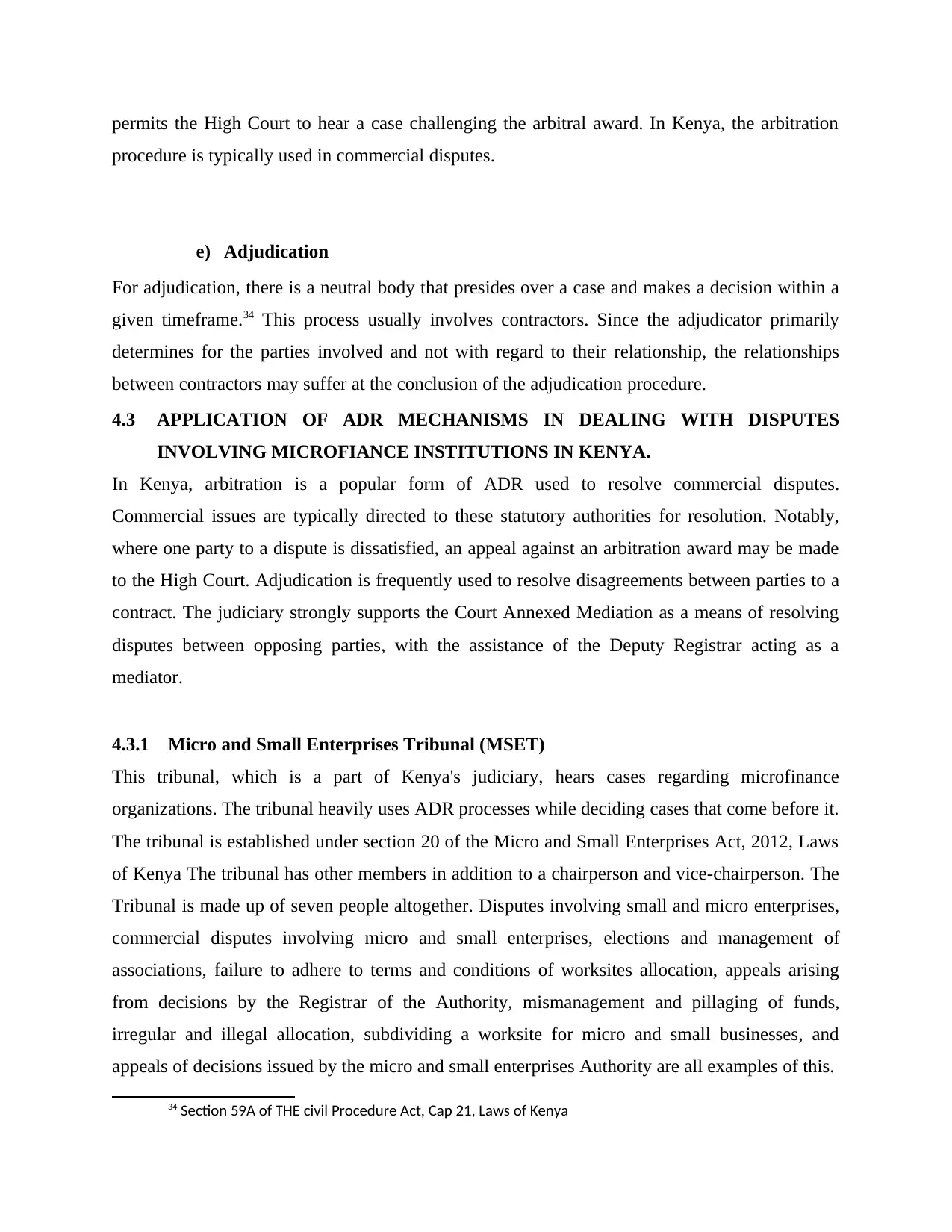
permits the High Court to hear a case challenging the arbitral award. In Kenya, the arbitration
procedure is typically used in commercial disputes.
e) Adjudication
For adjudication, there is a neutral body that presides over a case and makes a decision within a
given timeframe.34 This process usually involves contractors. Since the adjudicator primarily
determines for the parties involved and not with regard to their relationship, the relationships
between contractors may suffer at the conclusion of the adjudication procedure.
4.3 APPLICATION OF ADR MECHANISMS IN DEALING WITH DISPUTES
INVOLVING MICROFIANCE INSTITUTIONS IN KENYA.
In Kenya, arbitration is a popular form of ADR used to resolve commercial disputes.
Commercial issues are typically directed to these statutory authorities for resolution. Notably,
where one party to a dispute is dissatisfied, an appeal against an arbitration award may be made
to the High Court. Adjudication is frequently used to resolve disagreements between parties to a
contract. The judiciary strongly supports the Court Annexed Mediation as a means of resolving
disputes between opposing parties, with the assistance of the Deputy Registrar acting as a
mediator.
4.3.1 Micro and Small Enterprises Tribunal (MSET)
This tribunal, which is a part of Kenya's judiciary, hears cases regarding microfinance
organizations. The tribunal heavily uses ADR processes while deciding cases that come before it.
The tribunal is established under section 20 of the Micro and Small Enterprises Act, 2012, Laws
of Kenya The tribunal has other members in addition to a chairperson and vice-chairperson. The
Tribunal is made up of seven people altogether. Disputes involving small and micro enterprises,
commercial disputes involving micro and small enterprises, elections and management of
associations, failure to adhere to terms and conditions of worksites allocation, appeals arising
from decisions by the Registrar of the Authority, mismanagement and pillaging of funds,
irregular and illegal allocation, subdividing a worksite for micro and small businesses, and
appeals of decisions issued by the micro and small enterprises Authority are all examples of this.
34 Section 59A of THE civil Procedure Act, Cap 21, Laws of Kenya
procedure is typically used in commercial disputes.
e) Adjudication
For adjudication, there is a neutral body that presides over a case and makes a decision within a
given timeframe.34 This process usually involves contractors. Since the adjudicator primarily
determines for the parties involved and not with regard to their relationship, the relationships
between contractors may suffer at the conclusion of the adjudication procedure.
4.3 APPLICATION OF ADR MECHANISMS IN DEALING WITH DISPUTES
INVOLVING MICROFIANCE INSTITUTIONS IN KENYA.
In Kenya, arbitration is a popular form of ADR used to resolve commercial disputes.
Commercial issues are typically directed to these statutory authorities for resolution. Notably,
where one party to a dispute is dissatisfied, an appeal against an arbitration award may be made
to the High Court. Adjudication is frequently used to resolve disagreements between parties to a
contract. The judiciary strongly supports the Court Annexed Mediation as a means of resolving
disputes between opposing parties, with the assistance of the Deputy Registrar acting as a
mediator.
4.3.1 Micro and Small Enterprises Tribunal (MSET)
This tribunal, which is a part of Kenya's judiciary, hears cases regarding microfinance
organizations. The tribunal heavily uses ADR processes while deciding cases that come before it.
The tribunal is established under section 20 of the Micro and Small Enterprises Act, 2012, Laws
of Kenya The tribunal has other members in addition to a chairperson and vice-chairperson. The
Tribunal is made up of seven people altogether. Disputes involving small and micro enterprises,
commercial disputes involving micro and small enterprises, elections and management of
associations, failure to adhere to terms and conditions of worksites allocation, appeals arising
from decisions by the Registrar of the Authority, mismanagement and pillaging of funds,
irregular and illegal allocation, subdividing a worksite for micro and small businesses, and
appeals of decisions issued by the micro and small enterprises Authority are all examples of this.
34 Section 59A of THE civil Procedure Act, Cap 21, Laws of Kenya
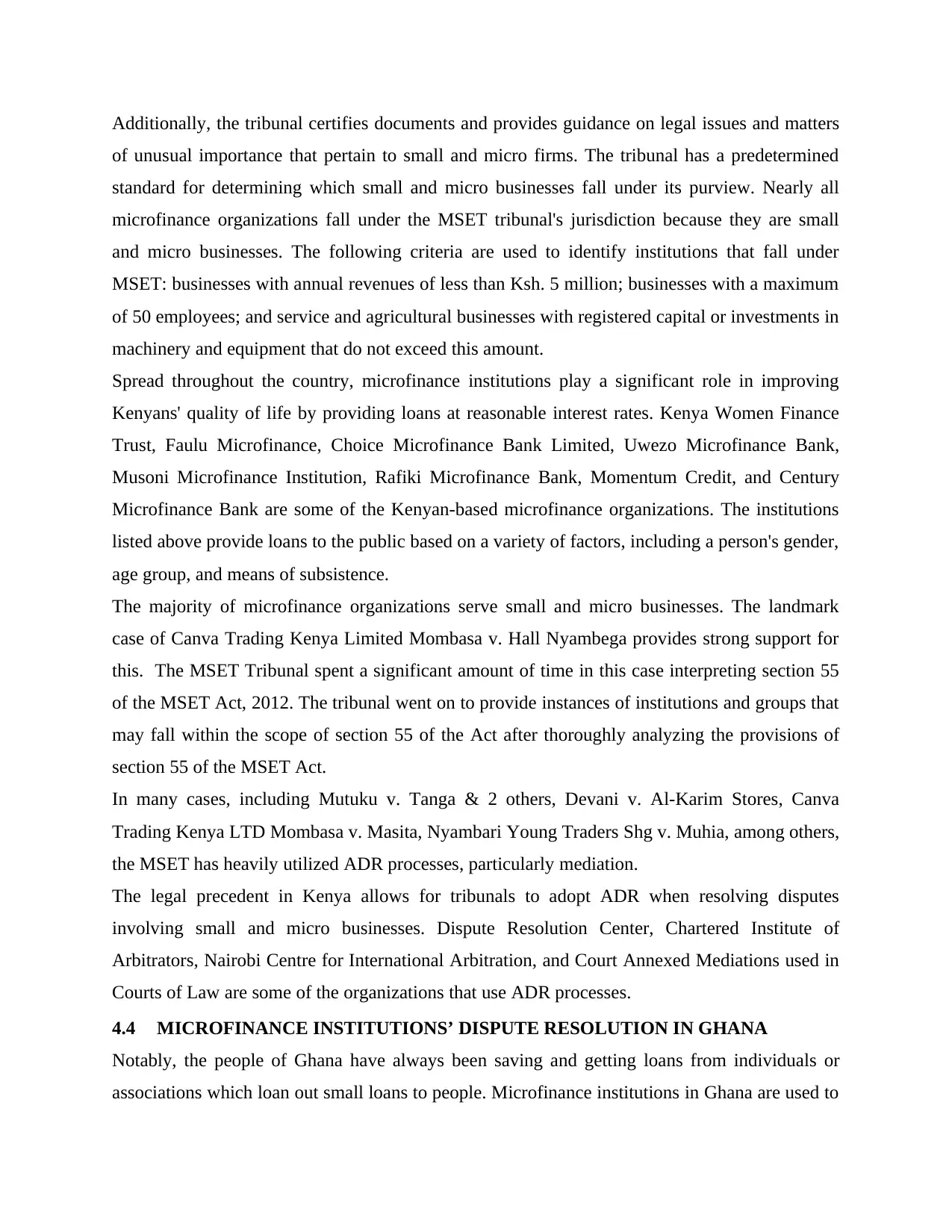
Additionally, the tribunal certifies documents and provides guidance on legal issues and matters
of unusual importance that pertain to small and micro firms. The tribunal has a predetermined
standard for determining which small and micro businesses fall under its purview. Nearly all
microfinance organizations fall under the MSET tribunal's jurisdiction because they are small
and micro businesses. The following criteria are used to identify institutions that fall under
MSET: businesses with annual revenues of less than Ksh. 5 million; businesses with a maximum
of 50 employees; and service and agricultural businesses with registered capital or investments in
machinery and equipment that do not exceed this amount.
Spread throughout the country, microfinance institutions play a significant role in improving
Kenyans' quality of life by providing loans at reasonable interest rates. Kenya Women Finance
Trust, Faulu Microfinance, Choice Microfinance Bank Limited, Uwezo Microfinance Bank,
Musoni Microfinance Institution, Rafiki Microfinance Bank, Momentum Credit, and Century
Microfinance Bank are some of the Kenyan-based microfinance organizations. The institutions
listed above provide loans to the public based on a variety of factors, including a person's gender,
age group, and means of subsistence.
The majority of microfinance organizations serve small and micro businesses. The landmark
case of Canva Trading Kenya Limited Mombasa v. Hall Nyambega provides strong support for
this. The MSET Tribunal spent a significant amount of time in this case interpreting section 55
of the MSET Act, 2012. The tribunal went on to provide instances of institutions and groups that
may fall within the scope of section 55 of the Act after thoroughly analyzing the provisions of
section 55 of the MSET Act.
In many cases, including Mutuku v. Tanga & 2 others, Devani v. Al-Karim Stores, Canva
Trading Kenya LTD Mombasa v. Masita, Nyambari Young Traders Shg v. Muhia, among others,
the MSET has heavily utilized ADR processes, particularly mediation.
The legal precedent in Kenya allows for tribunals to adopt ADR when resolving disputes
involving small and micro businesses. Dispute Resolution Center, Chartered Institute of
Arbitrators, Nairobi Centre for International Arbitration, and Court Annexed Mediations used in
Courts of Law are some of the organizations that use ADR processes.
4.4 MICROFINANCE INSTITUTIONS’ DISPUTE RESOLUTION IN GHANA
Notably, the people of Ghana have always been saving and getting loans from individuals or
associations which loan out small loans to people. Microfinance institutions in Ghana are used to
of unusual importance that pertain to small and micro firms. The tribunal has a predetermined
standard for determining which small and micro businesses fall under its purview. Nearly all
microfinance organizations fall under the MSET tribunal's jurisdiction because they are small
and micro businesses. The following criteria are used to identify institutions that fall under
MSET: businesses with annual revenues of less than Ksh. 5 million; businesses with a maximum
of 50 employees; and service and agricultural businesses with registered capital or investments in
machinery and equipment that do not exceed this amount.
Spread throughout the country, microfinance institutions play a significant role in improving
Kenyans' quality of life by providing loans at reasonable interest rates. Kenya Women Finance
Trust, Faulu Microfinance, Choice Microfinance Bank Limited, Uwezo Microfinance Bank,
Musoni Microfinance Institution, Rafiki Microfinance Bank, Momentum Credit, and Century
Microfinance Bank are some of the Kenyan-based microfinance organizations. The institutions
listed above provide loans to the public based on a variety of factors, including a person's gender,
age group, and means of subsistence.
The majority of microfinance organizations serve small and micro businesses. The landmark
case of Canva Trading Kenya Limited Mombasa v. Hall Nyambega provides strong support for
this. The MSET Tribunal spent a significant amount of time in this case interpreting section 55
of the MSET Act, 2012. The tribunal went on to provide instances of institutions and groups that
may fall within the scope of section 55 of the Act after thoroughly analyzing the provisions of
section 55 of the MSET Act.
In many cases, including Mutuku v. Tanga & 2 others, Devani v. Al-Karim Stores, Canva
Trading Kenya LTD Mombasa v. Masita, Nyambari Young Traders Shg v. Muhia, among others,
the MSET has heavily utilized ADR processes, particularly mediation.
The legal precedent in Kenya allows for tribunals to adopt ADR when resolving disputes
involving small and micro businesses. Dispute Resolution Center, Chartered Institute of
Arbitrators, Nairobi Centre for International Arbitration, and Court Annexed Mediations used in
Courts of Law are some of the organizations that use ADR processes.
4.4 MICROFINANCE INSTITUTIONS’ DISPUTE RESOLUTION IN GHANA
Notably, the people of Ghana have always been saving and getting loans from individuals or
associations which loan out small loans to people. Microfinance institutions in Ghana are used to
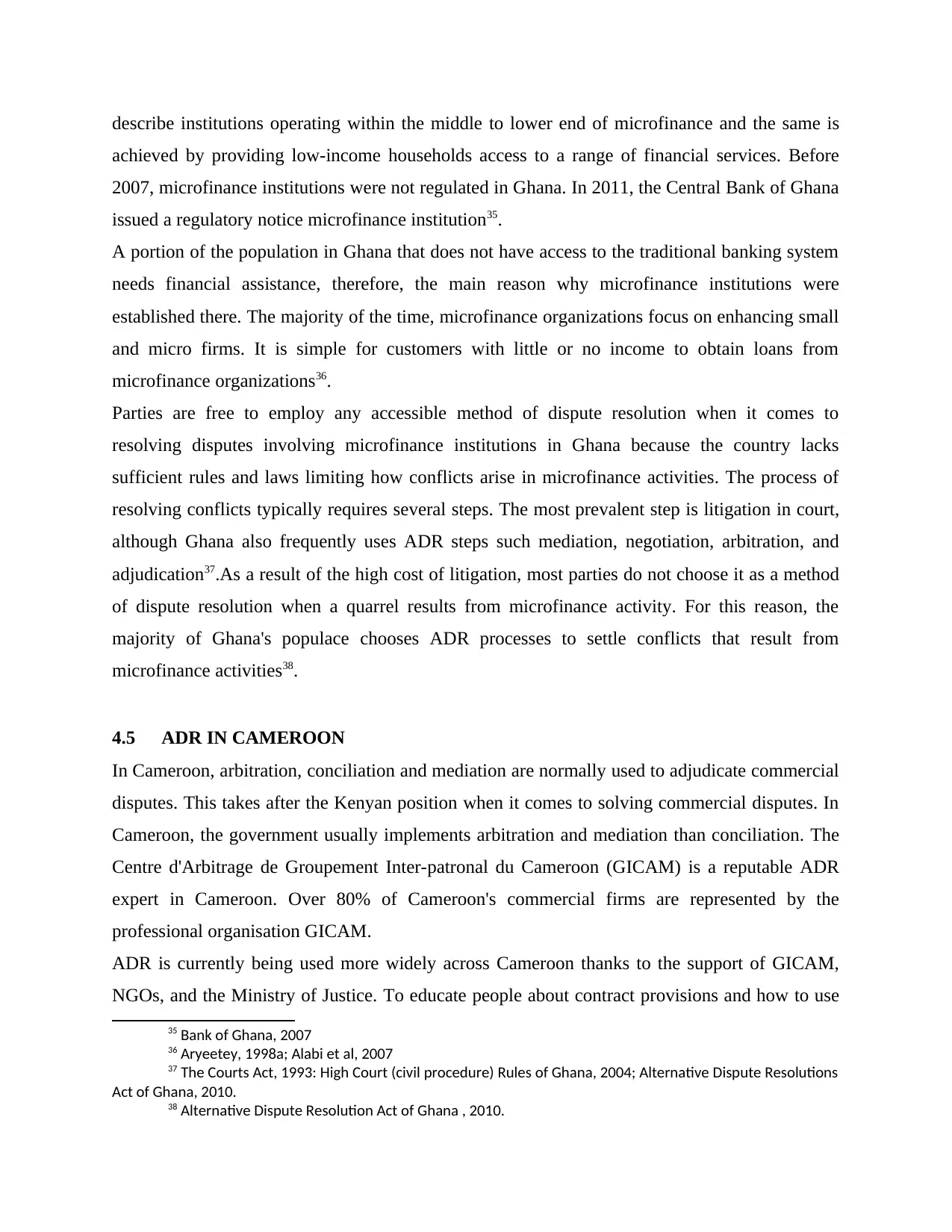
describe institutions operating within the middle to lower end of microfinance and the same is
achieved by providing low-income households access to a range of financial services. Before
2007, microfinance institutions were not regulated in Ghana. In 2011, the Central Bank of Ghana
issued a regulatory notice microfinance institution35.
A portion of the population in Ghana that does not have access to the traditional banking system
needs financial assistance, therefore, the main reason why microfinance institutions were
established there. The majority of the time, microfinance organizations focus on enhancing small
and micro firms. It is simple for customers with little or no income to obtain loans from
microfinance organizations36.
Parties are free to employ any accessible method of dispute resolution when it comes to
resolving disputes involving microfinance institutions in Ghana because the country lacks
sufficient rules and laws limiting how conflicts arise in microfinance activities. The process of
resolving conflicts typically requires several steps. The most prevalent step is litigation in court,
although Ghana also frequently uses ADR steps such mediation, negotiation, arbitration, and
adjudication37.As a result of the high cost of litigation, most parties do not choose it as a method
of dispute resolution when a quarrel results from microfinance activity. For this reason, the
majority of Ghana's populace chooses ADR processes to settle conflicts that result from
microfinance activities38.
4.5 ADR IN CAMEROON
In Cameroon, arbitration, conciliation and mediation are normally used to adjudicate commercial
disputes. This takes after the Kenyan position when it comes to solving commercial disputes. In
Cameroon, the government usually implements arbitration and mediation than conciliation. The
Centre d'Arbitrage de Groupement Inter-patronal du Cameroon (GICAM) is a reputable ADR
expert in Cameroon. Over 80% of Cameroon's commercial firms are represented by the
professional organisation GICAM.
ADR is currently being used more widely across Cameroon thanks to the support of GICAM,
NGOs, and the Ministry of Justice. To educate people about contract provisions and how to use
35 Bank of Ghana, 2007
36 Aryeetey, 1998a; Alabi et al, 2007
37 The Courts Act, 1993: High Court (civil procedure) Rules of Ghana, 2004; Alternative Dispute Resolutions
Act of Ghana, 2010.
38 Alternative Dispute Resolution Act of Ghana , 2010.
achieved by providing low-income households access to a range of financial services. Before
2007, microfinance institutions were not regulated in Ghana. In 2011, the Central Bank of Ghana
issued a regulatory notice microfinance institution35.
A portion of the population in Ghana that does not have access to the traditional banking system
needs financial assistance, therefore, the main reason why microfinance institutions were
established there. The majority of the time, microfinance organizations focus on enhancing small
and micro firms. It is simple for customers with little or no income to obtain loans from
microfinance organizations36.
Parties are free to employ any accessible method of dispute resolution when it comes to
resolving disputes involving microfinance institutions in Ghana because the country lacks
sufficient rules and laws limiting how conflicts arise in microfinance activities. The process of
resolving conflicts typically requires several steps. The most prevalent step is litigation in court,
although Ghana also frequently uses ADR steps such mediation, negotiation, arbitration, and
adjudication37.As a result of the high cost of litigation, most parties do not choose it as a method
of dispute resolution when a quarrel results from microfinance activity. For this reason, the
majority of Ghana's populace chooses ADR processes to settle conflicts that result from
microfinance activities38.
4.5 ADR IN CAMEROON
In Cameroon, arbitration, conciliation and mediation are normally used to adjudicate commercial
disputes. This takes after the Kenyan position when it comes to solving commercial disputes. In
Cameroon, the government usually implements arbitration and mediation than conciliation. The
Centre d'Arbitrage de Groupement Inter-patronal du Cameroon (GICAM) is a reputable ADR
expert in Cameroon. Over 80% of Cameroon's commercial firms are represented by the
professional organisation GICAM.
ADR is currently being used more widely across Cameroon thanks to the support of GICAM,
NGOs, and the Ministry of Justice. To educate people about contract provisions and how to use
35 Bank of Ghana, 2007
36 Aryeetey, 1998a; Alabi et al, 2007
37 The Courts Act, 1993: High Court (civil procedure) Rules of Ghana, 2004; Alternative Dispute Resolutions
Act of Ghana, 2010.
38 Alternative Dispute Resolution Act of Ghana , 2010.
Paraphrase This Document
Need a fresh take? Get an instant paraphrase of this document with our AI Paraphraser
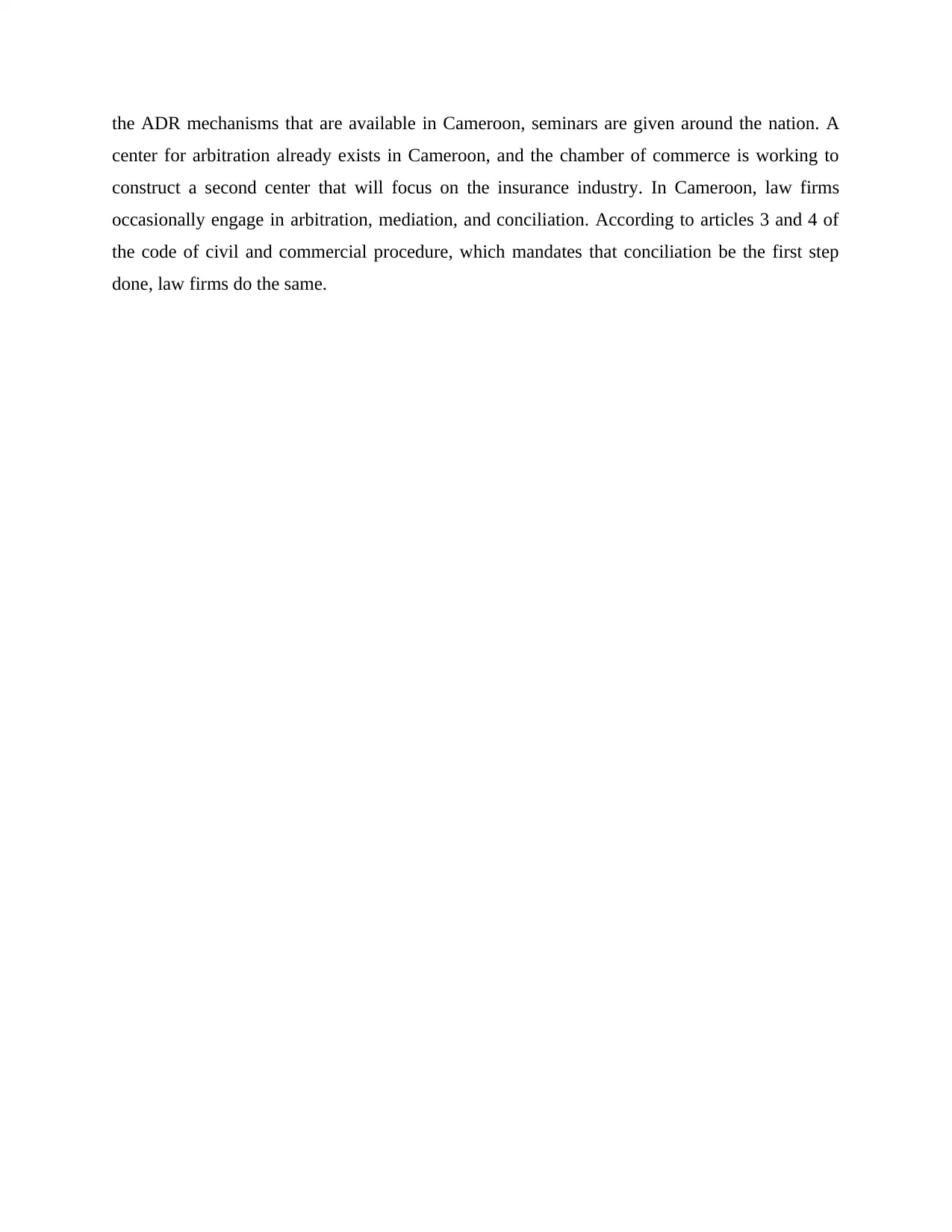
the ADR mechanisms that are available in Cameroon, seminars are given around the nation. A
center for arbitration already exists in Cameroon, and the chamber of commerce is working to
construct a second center that will focus on the insurance industry. In Cameroon, law firms
occasionally engage in arbitration, mediation, and conciliation. According to articles 3 and 4 of
the code of civil and commercial procedure, which mandates that conciliation be the first step
done, law firms do the same.
center for arbitration already exists in Cameroon, and the chamber of commerce is working to
construct a second center that will focus on the insurance industry. In Cameroon, law firms
occasionally engage in arbitration, mediation, and conciliation. According to articles 3 and 4 of
the code of civil and commercial procedure, which mandates that conciliation be the first step
done, law firms do the same.
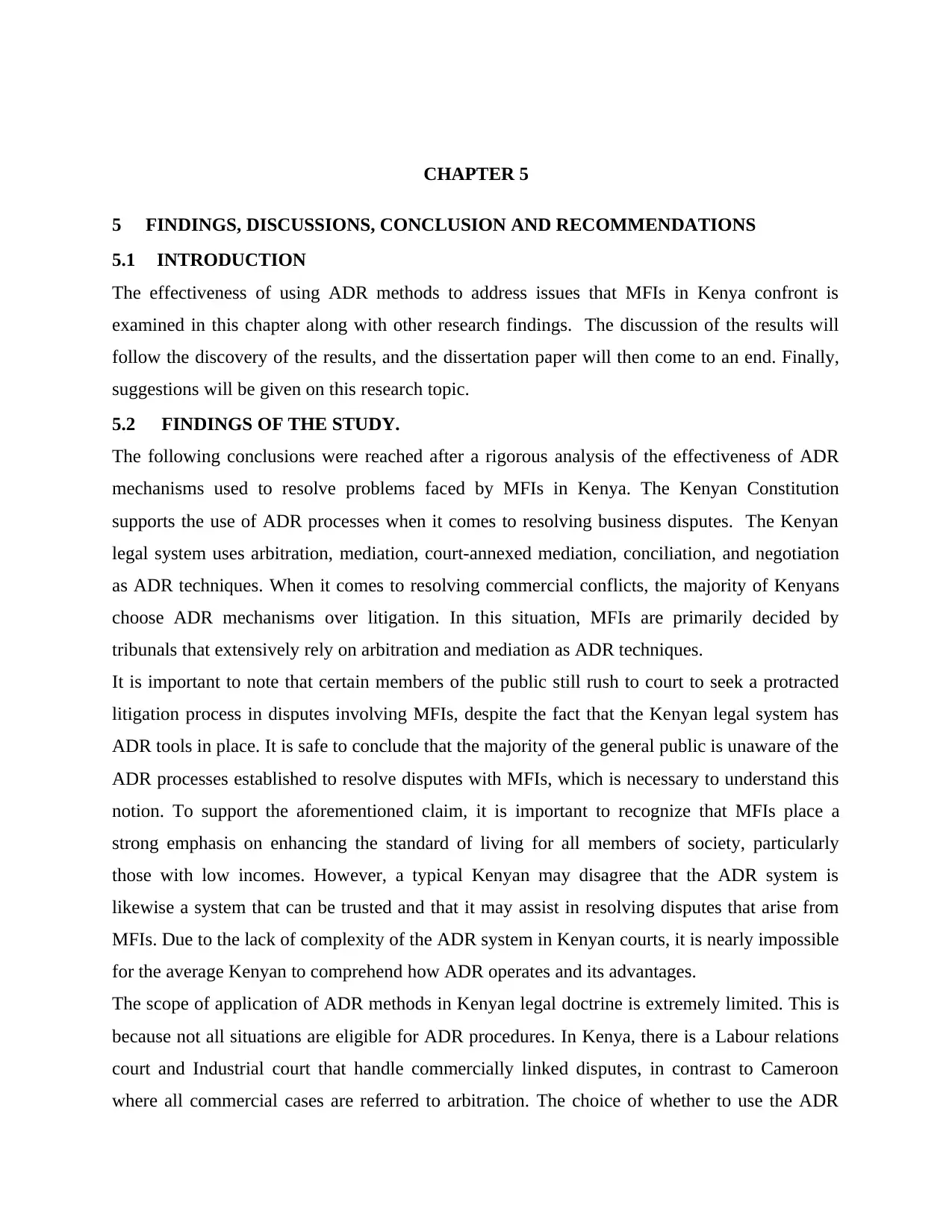
CHAPTER 5
5 FINDINGS, DISCUSSIONS, CONCLUSION AND RECOMMENDATIONS
5.1 INTRODUCTION
The effectiveness of using ADR methods to address issues that MFIs in Kenya confront is
examined in this chapter along with other research findings. The discussion of the results will
follow the discovery of the results, and the dissertation paper will then come to an end. Finally,
suggestions will be given on this research topic.
5.2 FINDINGS OF THE STUDY.
The following conclusions were reached after a rigorous analysis of the effectiveness of ADR
mechanisms used to resolve problems faced by MFIs in Kenya. The Kenyan Constitution
supports the use of ADR processes when it comes to resolving business disputes. The Kenyan
legal system uses arbitration, mediation, court-annexed mediation, conciliation, and negotiation
as ADR techniques. When it comes to resolving commercial conflicts, the majority of Kenyans
choose ADR mechanisms over litigation. In this situation, MFIs are primarily decided by
tribunals that extensively rely on arbitration and mediation as ADR techniques.
It is important to note that certain members of the public still rush to court to seek a protracted
litigation process in disputes involving MFIs, despite the fact that the Kenyan legal system has
ADR tools in place. It is safe to conclude that the majority of the general public is unaware of the
ADR processes established to resolve disputes with MFIs, which is necessary to understand this
notion. To support the aforementioned claim, it is important to recognize that MFIs place a
strong emphasis on enhancing the standard of living for all members of society, particularly
those with low incomes. However, a typical Kenyan may disagree that the ADR system is
likewise a system that can be trusted and that it may assist in resolving disputes that arise from
MFIs. Due to the lack of complexity of the ADR system in Kenyan courts, it is nearly impossible
for the average Kenyan to comprehend how ADR operates and its advantages.
The scope of application of ADR methods in Kenyan legal doctrine is extremely limited. This is
because not all situations are eligible for ADR procedures. In Kenya, there is a Labour relations
court and Industrial court that handle commercially linked disputes, in contrast to Cameroon
where all commercial cases are referred to arbitration. The choice of whether to use the ADR
5 FINDINGS, DISCUSSIONS, CONCLUSION AND RECOMMENDATIONS
5.1 INTRODUCTION
The effectiveness of using ADR methods to address issues that MFIs in Kenya confront is
examined in this chapter along with other research findings. The discussion of the results will
follow the discovery of the results, and the dissertation paper will then come to an end. Finally,
suggestions will be given on this research topic.
5.2 FINDINGS OF THE STUDY.
The following conclusions were reached after a rigorous analysis of the effectiveness of ADR
mechanisms used to resolve problems faced by MFIs in Kenya. The Kenyan Constitution
supports the use of ADR processes when it comes to resolving business disputes. The Kenyan
legal system uses arbitration, mediation, court-annexed mediation, conciliation, and negotiation
as ADR techniques. When it comes to resolving commercial conflicts, the majority of Kenyans
choose ADR mechanisms over litigation. In this situation, MFIs are primarily decided by
tribunals that extensively rely on arbitration and mediation as ADR techniques.
It is important to note that certain members of the public still rush to court to seek a protracted
litigation process in disputes involving MFIs, despite the fact that the Kenyan legal system has
ADR tools in place. It is safe to conclude that the majority of the general public is unaware of the
ADR processes established to resolve disputes with MFIs, which is necessary to understand this
notion. To support the aforementioned claim, it is important to recognize that MFIs place a
strong emphasis on enhancing the standard of living for all members of society, particularly
those with low incomes. However, a typical Kenyan may disagree that the ADR system is
likewise a system that can be trusted and that it may assist in resolving disputes that arise from
MFIs. Due to the lack of complexity of the ADR system in Kenyan courts, it is nearly impossible
for the average Kenyan to comprehend how ADR operates and its advantages.
The scope of application of ADR methods in Kenyan legal doctrine is extremely limited. This is
because not all situations are eligible for ADR procedures. In Kenya, there is a Labour relations
court and Industrial court that handle commercially linked disputes, in contrast to Cameroon
where all commercial cases are referred to arbitration. The choice of whether to use the ADR

mechanism or the court system becomes difficult. Litigation will always be used to resolve
criminal cases.
This study reveals that the law views alternative dispute resolution (ADR) methods as a choice,
hence when managing problems with MFIs, one may choose to use an ADR system or not. This
is mostly due to Kenya's Constitutional clause that no one may be forced to use the ADR system.
Another reason why ADR is less frequently utilized to resolve issues with MFIs is because any
decisions reached in a case through ADR methods are usually never legally binding at all and
can be readily contested in the High Court.
The credit risk is yet another important consideration when addressing the issues MFIs are
experiencing. It is important to note that Kenyan MFIs are subject to a number of credit risk
exposure concerns, including lending to the general population. Due to the borrowers' low credit
requirements, the majority of MFIs encounter difficulties when it comes to loan borrowers. MFIs
also struggle with poor portfolio risk management issues and a failure to pay attention to
changing economic conditions. MFIs rely heavily on loans as a source of credit risk, which
increases the possibility of disputes with borrowers. Current inflation rates, current interest rates,
group loans, and investments in bonds and stocks are other elements that affect credit risk in
MFIs.
In Kenya, MFIs do provide a variety of services, such as working capital loans, pensions,
consumer lending, remittance transfer services, and Micro-savings and microcredit. MFIs can
take on several shapes. They can take the shape of commercial banks, government banks,
cooperative savings and loan institutions, non-profit organizations, or non-bank financial
institutions. The Central Bank of Kenya oversees the regulation of MFIs.
5.3 DISCUSSION
By virtue of Article 159 of the Kenyan Constitution of 2010, ADR processes are widely used to
resolve commercial disputes in Kenya. Comparatively, ADR methods are used to resolve
commercial conflicts in Kenya, Ghana, and Cameroon. The Kenyan judicial system is set up in a
way that makes ADR techniques applicable. The MSET tribunal, for instance, examines issues
pertaining to micro and small businesses. By virtue of Section 55 of the MSET Act, which
describes how an entity qualifies to come under the micro and small enterprise category,
microfinance institutions also belong to such firms.
criminal cases.
This study reveals that the law views alternative dispute resolution (ADR) methods as a choice,
hence when managing problems with MFIs, one may choose to use an ADR system or not. This
is mostly due to Kenya's Constitutional clause that no one may be forced to use the ADR system.
Another reason why ADR is less frequently utilized to resolve issues with MFIs is because any
decisions reached in a case through ADR methods are usually never legally binding at all and
can be readily contested in the High Court.
The credit risk is yet another important consideration when addressing the issues MFIs are
experiencing. It is important to note that Kenyan MFIs are subject to a number of credit risk
exposure concerns, including lending to the general population. Due to the borrowers' low credit
requirements, the majority of MFIs encounter difficulties when it comes to loan borrowers. MFIs
also struggle with poor portfolio risk management issues and a failure to pay attention to
changing economic conditions. MFIs rely heavily on loans as a source of credit risk, which
increases the possibility of disputes with borrowers. Current inflation rates, current interest rates,
group loans, and investments in bonds and stocks are other elements that affect credit risk in
MFIs.
In Kenya, MFIs do provide a variety of services, such as working capital loans, pensions,
consumer lending, remittance transfer services, and Micro-savings and microcredit. MFIs can
take on several shapes. They can take the shape of commercial banks, government banks,
cooperative savings and loan institutions, non-profit organizations, or non-bank financial
institutions. The Central Bank of Kenya oversees the regulation of MFIs.
5.3 DISCUSSION
By virtue of Article 159 of the Kenyan Constitution of 2010, ADR processes are widely used to
resolve commercial disputes in Kenya. Comparatively, ADR methods are used to resolve
commercial conflicts in Kenya, Ghana, and Cameroon. The Kenyan judicial system is set up in a
way that makes ADR techniques applicable. The MSET tribunal, for instance, examines issues
pertaining to micro and small businesses. By virtue of Section 55 of the MSET Act, which
describes how an entity qualifies to come under the micro and small enterprise category,
microfinance institutions also belong to such firms.
Secure Best Marks with AI Grader
Need help grading? Try our AI Grader for instant feedback on your assignments.
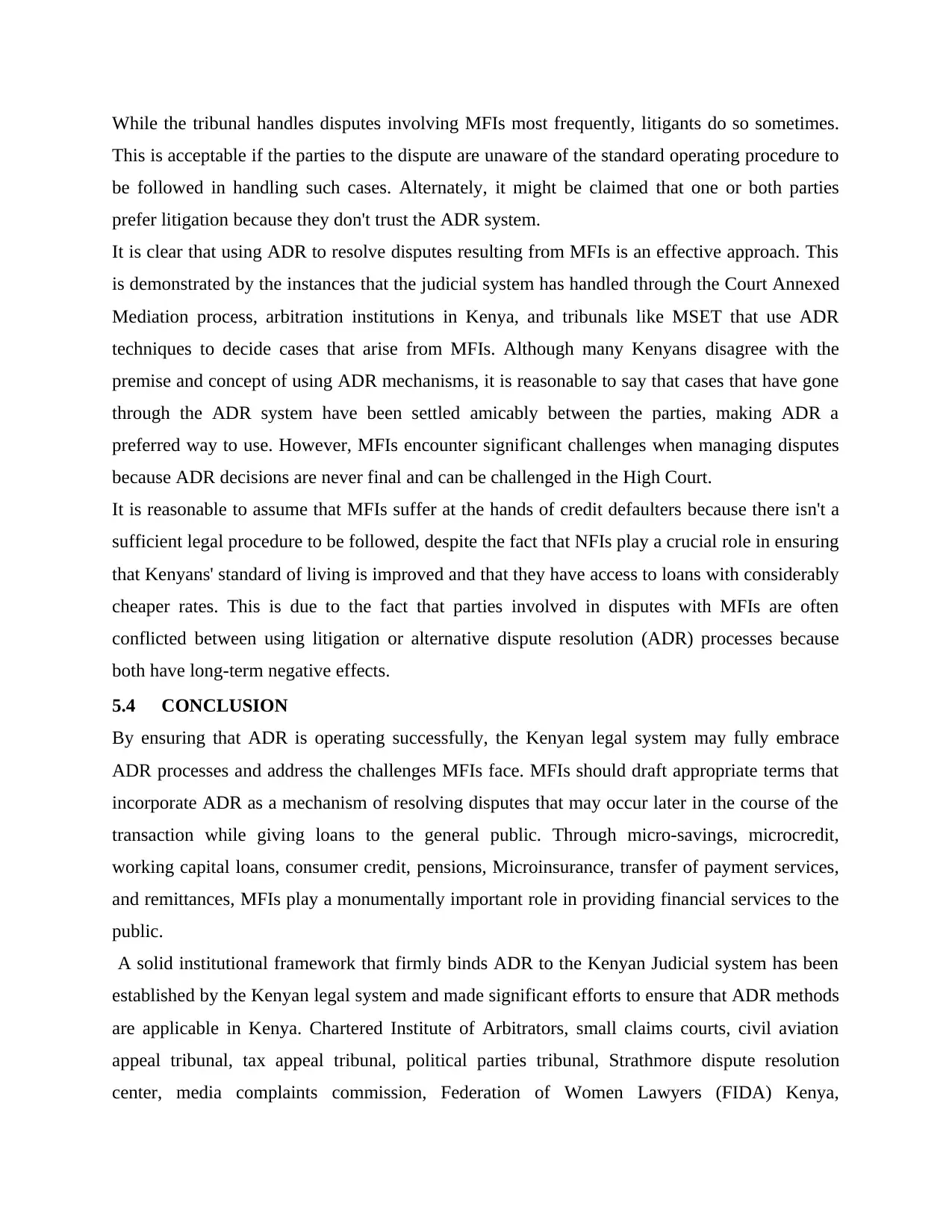
While the tribunal handles disputes involving MFIs most frequently, litigants do so sometimes.
This is acceptable if the parties to the dispute are unaware of the standard operating procedure to
be followed in handling such cases. Alternately, it might be claimed that one or both parties
prefer litigation because they don't trust the ADR system.
It is clear that using ADR to resolve disputes resulting from MFIs is an effective approach. This
is demonstrated by the instances that the judicial system has handled through the Court Annexed
Mediation process, arbitration institutions in Kenya, and tribunals like MSET that use ADR
techniques to decide cases that arise from MFIs. Although many Kenyans disagree with the
premise and concept of using ADR mechanisms, it is reasonable to say that cases that have gone
through the ADR system have been settled amicably between the parties, making ADR a
preferred way to use. However, MFIs encounter significant challenges when managing disputes
because ADR decisions are never final and can be challenged in the High Court.
It is reasonable to assume that MFIs suffer at the hands of credit defaulters because there isn't a
sufficient legal procedure to be followed, despite the fact that NFIs play a crucial role in ensuring
that Kenyans' standard of living is improved and that they have access to loans with considerably
cheaper rates. This is due to the fact that parties involved in disputes with MFIs are often
conflicted between using litigation or alternative dispute resolution (ADR) processes because
both have long-term negative effects.
5.4 CONCLUSION
By ensuring that ADR is operating successfully, the Kenyan legal system may fully embrace
ADR processes and address the challenges MFIs face. MFIs should draft appropriate terms that
incorporate ADR as a mechanism of resolving disputes that may occur later in the course of the
transaction while giving loans to the general public. Through micro-savings, microcredit,
working capital loans, consumer credit, pensions, Microinsurance, transfer of payment services,
and remittances, MFIs play a monumentally important role in providing financial services to the
public.
A solid institutional framework that firmly binds ADR to the Kenyan Judicial system has been
established by the Kenyan legal system and made significant efforts to ensure that ADR methods
are applicable in Kenya. Chartered Institute of Arbitrators, small claims courts, civil aviation
appeal tribunal, tax appeal tribunal, political parties tribunal, Strathmore dispute resolution
center, media complaints commission, Federation of Women Lawyers (FIDA) Kenya,
This is acceptable if the parties to the dispute are unaware of the standard operating procedure to
be followed in handling such cases. Alternately, it might be claimed that one or both parties
prefer litigation because they don't trust the ADR system.
It is clear that using ADR to resolve disputes resulting from MFIs is an effective approach. This
is demonstrated by the instances that the judicial system has handled through the Court Annexed
Mediation process, arbitration institutions in Kenya, and tribunals like MSET that use ADR
techniques to decide cases that arise from MFIs. Although many Kenyans disagree with the
premise and concept of using ADR mechanisms, it is reasonable to say that cases that have gone
through the ADR system have been settled amicably between the parties, making ADR a
preferred way to use. However, MFIs encounter significant challenges when managing disputes
because ADR decisions are never final and can be challenged in the High Court.
It is reasonable to assume that MFIs suffer at the hands of credit defaulters because there isn't a
sufficient legal procedure to be followed, despite the fact that NFIs play a crucial role in ensuring
that Kenyans' standard of living is improved and that they have access to loans with considerably
cheaper rates. This is due to the fact that parties involved in disputes with MFIs are often
conflicted between using litigation or alternative dispute resolution (ADR) processes because
both have long-term negative effects.
5.4 CONCLUSION
By ensuring that ADR is operating successfully, the Kenyan legal system may fully embrace
ADR processes and address the challenges MFIs face. MFIs should draft appropriate terms that
incorporate ADR as a mechanism of resolving disputes that may occur later in the course of the
transaction while giving loans to the general public. Through micro-savings, microcredit,
working capital loans, consumer credit, pensions, Microinsurance, transfer of payment services,
and remittances, MFIs play a monumentally important role in providing financial services to the
public.
A solid institutional framework that firmly binds ADR to the Kenyan Judicial system has been
established by the Kenyan legal system and made significant efforts to ensure that ADR methods
are applicable in Kenya. Chartered Institute of Arbitrators, small claims courts, civil aviation
appeal tribunal, tax appeal tribunal, political parties tribunal, Strathmore dispute resolution
center, media complaints commission, Federation of Women Lawyers (FIDA) Kenya,
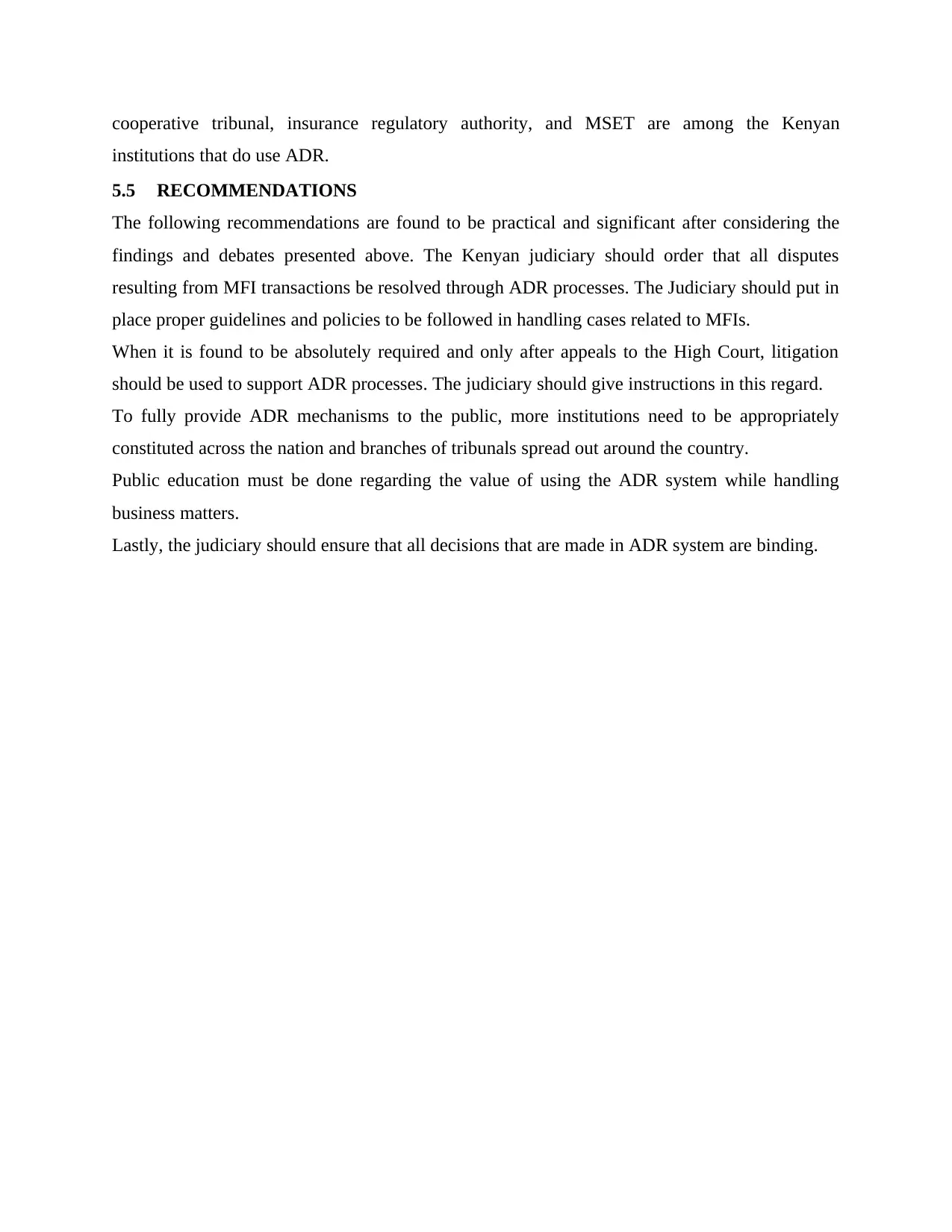
cooperative tribunal, insurance regulatory authority, and MSET are among the Kenyan
institutions that do use ADR.
5.5 RECOMMENDATIONS
The following recommendations are found to be practical and significant after considering the
findings and debates presented above. The Kenyan judiciary should order that all disputes
resulting from MFI transactions be resolved through ADR processes. The Judiciary should put in
place proper guidelines and policies to be followed in handling cases related to MFIs.
When it is found to be absolutely required and only after appeals to the High Court, litigation
should be used to support ADR processes. The judiciary should give instructions in this regard.
To fully provide ADR mechanisms to the public, more institutions need to be appropriately
constituted across the nation and branches of tribunals spread out around the country.
Public education must be done regarding the value of using the ADR system while handling
business matters.
Lastly, the judiciary should ensure that all decisions that are made in ADR system are binding.
institutions that do use ADR.
5.5 RECOMMENDATIONS
The following recommendations are found to be practical and significant after considering the
findings and debates presented above. The Kenyan judiciary should order that all disputes
resulting from MFI transactions be resolved through ADR processes. The Judiciary should put in
place proper guidelines and policies to be followed in handling cases related to MFIs.
When it is found to be absolutely required and only after appeals to the High Court, litigation
should be used to support ADR processes. The judiciary should give instructions in this regard.
To fully provide ADR mechanisms to the public, more institutions need to be appropriately
constituted across the nation and branches of tribunals spread out around the country.
Public education must be done regarding the value of using the ADR system while handling
business matters.
Lastly, the judiciary should ensure that all decisions that are made in ADR system are binding.
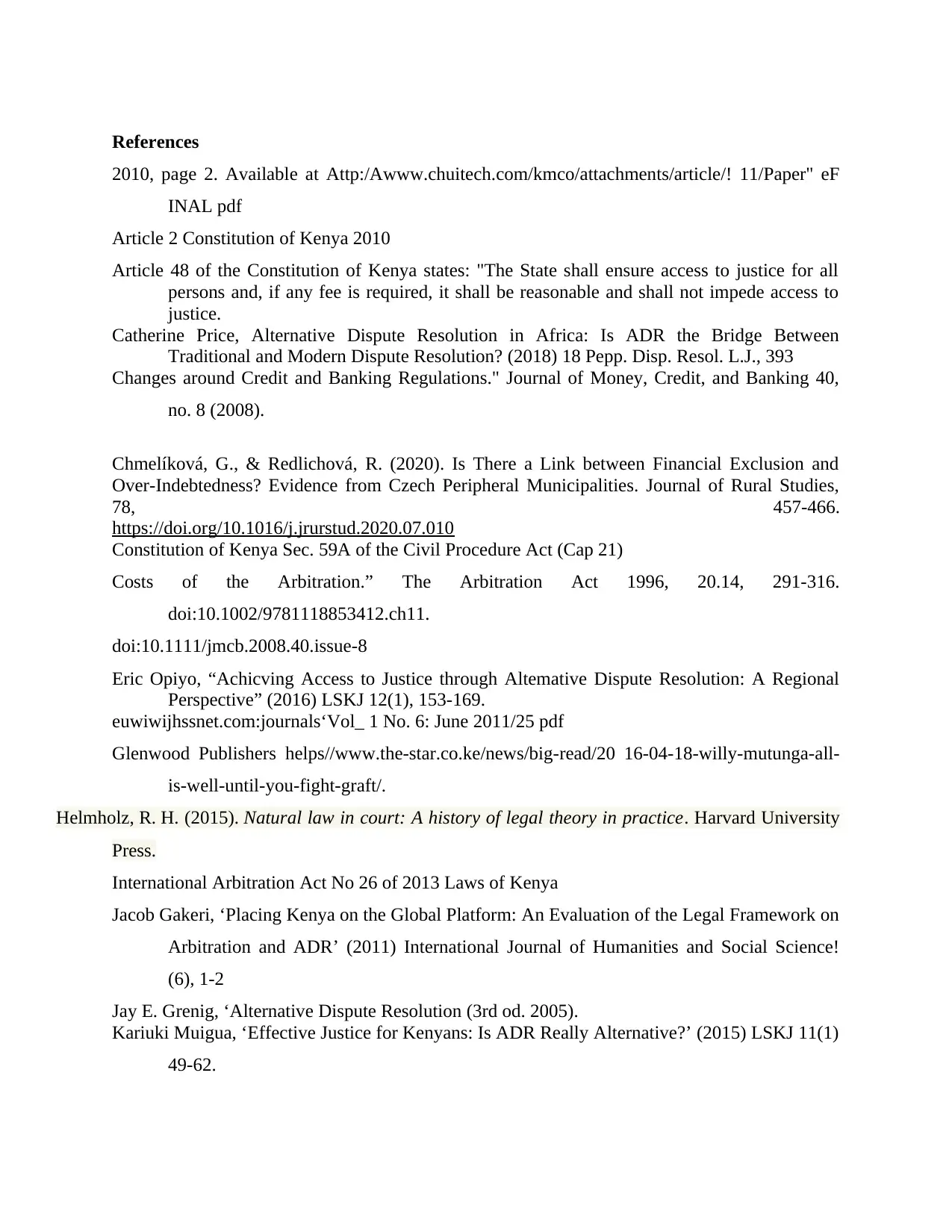
References
2010, page 2. Available at Attp:/Awww.chuitech.com/kmco/attachments/article/! 11/Paper" eF
INAL pdf
Article 2 Constitution of Kenya 2010
Article 48 of the Constitution of Kenya states: "The State shall ensure access to justice for all
persons and, if any fee is required, it shall be reasonable and shall not impede access to
justice.
Catherine Price, Alternative Dispute Resolution in Africa: Is ADR the Bridge Between
Traditional and Modern Dispute Resolution? (2018) 18 Pepp. Disp. Resol. L.J., 393
Changes around Credit and Banking Regulations." Journal of Money, Credit, and Banking 40,
no. 8 (2008).
Chmelíková, G., & Redlichová, R. (2020). Is There a Link between Financial Exclusion and
Over-Indebtedness? Evidence from Czech Peripheral Municipalities. Journal of Rural Studies,
78, 457-466.
https://doi.org/10.1016/j.jrurstud.2020.07.010
Constitution of Kenya Sec. 59A of the Civil Procedure Act (Cap 21)
Costs of the Arbitration.” The Arbitration Act 1996, 20.14, 291-316.
doi:10.1002/9781118853412.ch11.
doi:10.1111/jmcb.2008.40.issue-8
Eric Opiyo, “Achicving Access to Justice through Altemative Dispute Resolution: A Regional
Perspective” (2016) LSKJ 12(1), 153-169.
euwiwijhssnet.com:journals‘Vol_ 1 No. 6: June 2011/25 pdf
Glenwood Publishers helps//www.the-star.co.ke/news/big-read/20 16-04-18-willy-mutunga-all-
is-well-until-you-fight-graft/.
Helmholz, R. H. (2015). Natural law in court: A history of legal theory in practice. Harvard University
Press.
International Arbitration Act No 26 of 2013 Laws of Kenya
Jacob Gakeri, ‘Placing Kenya on the Global Platform: An Evaluation of the Legal Framework on
Arbitration and ADR’ (2011) International Journal of Humanities and Social Science!
(6), 1-2
Jay E. Grenig, ‘Alternative Dispute Resolution (3rd od. 2005).
Kariuki Muigua, ‘Effective Justice for Kenyans: Is ADR Really Alternative?’ (2015) LSKJ 11(1)
49-62.
2010, page 2. Available at Attp:/Awww.chuitech.com/kmco/attachments/article/! 11/Paper" eF
INAL pdf
Article 2 Constitution of Kenya 2010
Article 48 of the Constitution of Kenya states: "The State shall ensure access to justice for all
persons and, if any fee is required, it shall be reasonable and shall not impede access to
justice.
Catherine Price, Alternative Dispute Resolution in Africa: Is ADR the Bridge Between
Traditional and Modern Dispute Resolution? (2018) 18 Pepp. Disp. Resol. L.J., 393
Changes around Credit and Banking Regulations." Journal of Money, Credit, and Banking 40,
no. 8 (2008).
Chmelíková, G., & Redlichová, R. (2020). Is There a Link between Financial Exclusion and
Over-Indebtedness? Evidence from Czech Peripheral Municipalities. Journal of Rural Studies,
78, 457-466.
https://doi.org/10.1016/j.jrurstud.2020.07.010
Constitution of Kenya Sec. 59A of the Civil Procedure Act (Cap 21)
Costs of the Arbitration.” The Arbitration Act 1996, 20.14, 291-316.
doi:10.1002/9781118853412.ch11.
doi:10.1111/jmcb.2008.40.issue-8
Eric Opiyo, “Achicving Access to Justice through Altemative Dispute Resolution: A Regional
Perspective” (2016) LSKJ 12(1), 153-169.
euwiwijhssnet.com:journals‘Vol_ 1 No. 6: June 2011/25 pdf
Glenwood Publishers helps//www.the-star.co.ke/news/big-read/20 16-04-18-willy-mutunga-all-
is-well-until-you-fight-graft/.
Helmholz, R. H. (2015). Natural law in court: A history of legal theory in practice. Harvard University
Press.
International Arbitration Act No 26 of 2013 Laws of Kenya
Jacob Gakeri, ‘Placing Kenya on the Global Platform: An Evaluation of the Legal Framework on
Arbitration and ADR’ (2011) International Journal of Humanities and Social Science!
(6), 1-2
Jay E. Grenig, ‘Alternative Dispute Resolution (3rd od. 2005).
Kariuki Muigua, ‘Effective Justice for Kenyans: Is ADR Really Alternative?’ (2015) LSKJ 11(1)
49-62.
Paraphrase This Document
Need a fresh take? Get an instant paraphrase of this document with our AI Paraphraser
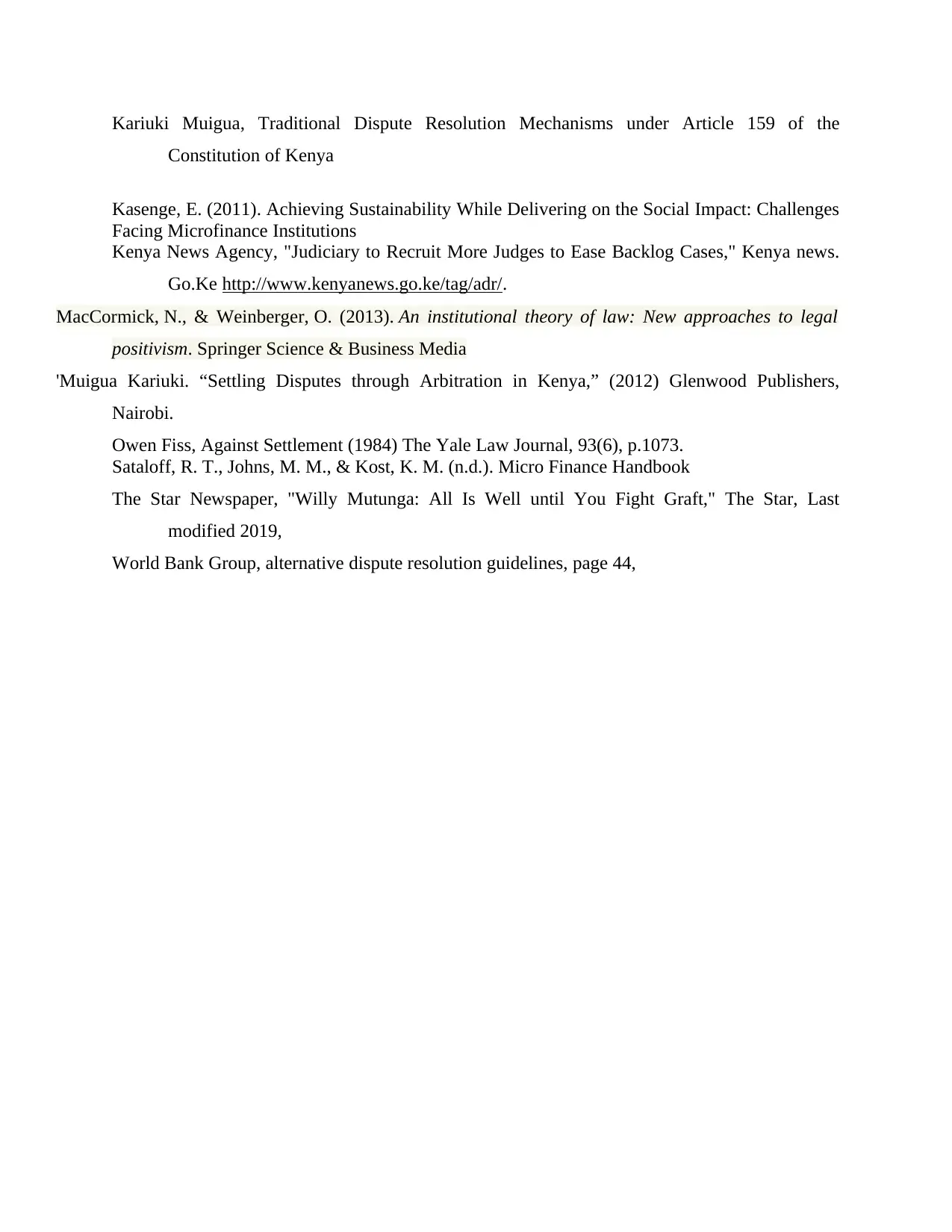
Kariuki Muigua, Traditional Dispute Resolution Mechanisms under Article 159 of the
Constitution of Kenya
Kasenge, E. (2011). Achieving Sustainability While Delivering on the Social Impact: Challenges
Facing Microfinance Institutions
Kenya News Agency, "Judiciary to Recruit More Judges to Ease Backlog Cases," Kenya news.
Go.Ke http://www.kenyanews.go.ke/tag/adr/.
MacCormick, N., & Weinberger, O. (2013). An institutional theory of law: New approaches to legal
positivism. Springer Science & Business Media
'Muigua Kariuki. “Settling Disputes through Arbitration in Kenya,” (2012) Glenwood Publishers,
Nairobi.
Owen Fiss, Against Settlement (1984) The Yale Law Journal, 93(6), p.1073.
Sataloff, R. T., Johns, M. M., & Kost, K. M. (n.d.). Micro Finance Handbook
The Star Newspaper, "Willy Mutunga: All Is Well until You Fight Graft," The Star, Last
modified 2019,
World Bank Group, alternative dispute resolution guidelines, page 44,
Constitution of Kenya
Kasenge, E. (2011). Achieving Sustainability While Delivering on the Social Impact: Challenges
Facing Microfinance Institutions
Kenya News Agency, "Judiciary to Recruit More Judges to Ease Backlog Cases," Kenya news.
Go.Ke http://www.kenyanews.go.ke/tag/adr/.
MacCormick, N., & Weinberger, O. (2013). An institutional theory of law: New approaches to legal
positivism. Springer Science & Business Media
'Muigua Kariuki. “Settling Disputes through Arbitration in Kenya,” (2012) Glenwood Publishers,
Nairobi.
Owen Fiss, Against Settlement (1984) The Yale Law Journal, 93(6), p.1073.
Sataloff, R. T., Johns, M. M., & Kost, K. M. (n.d.). Micro Finance Handbook
The Star Newspaper, "Willy Mutunga: All Is Well until You Fight Graft," The Star, Last
modified 2019,
World Bank Group, alternative dispute resolution guidelines, page 44,

1 out of 39
Related Documents
Your All-in-One AI-Powered Toolkit for Academic Success.
+13062052269
info@desklib.com
Available 24*7 on WhatsApp / Email
![[object Object]](/_next/static/media/star-bottom.7253800d.svg)
Unlock your academic potential
© 2024 | Zucol Services PVT LTD | All rights reserved.





